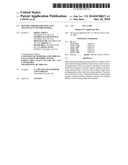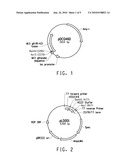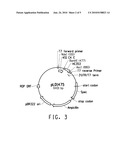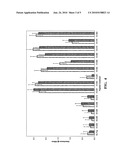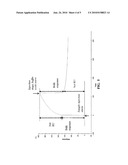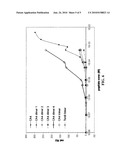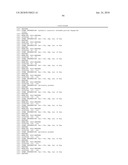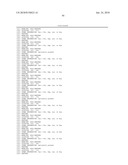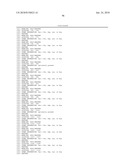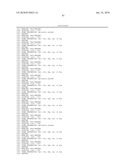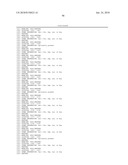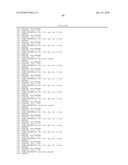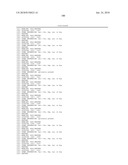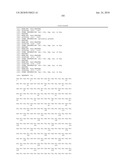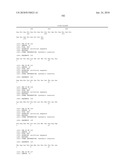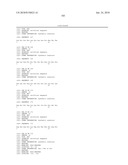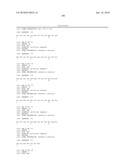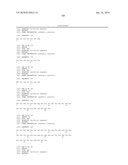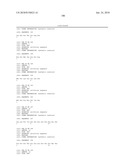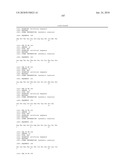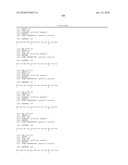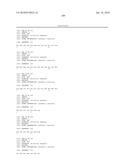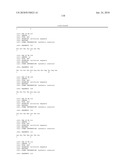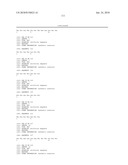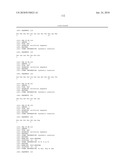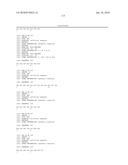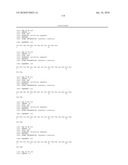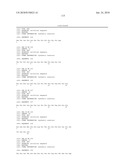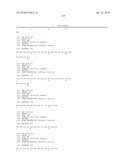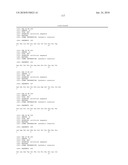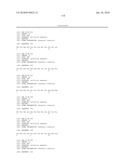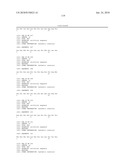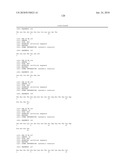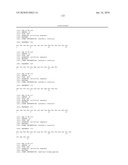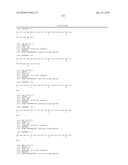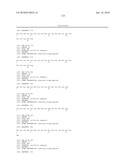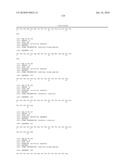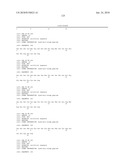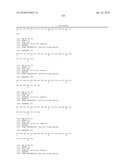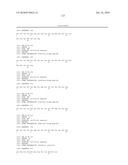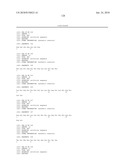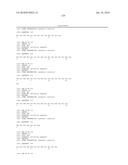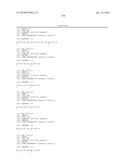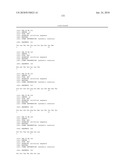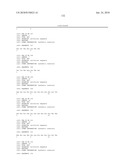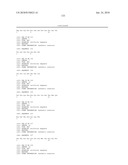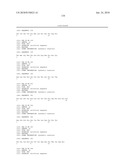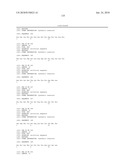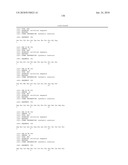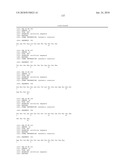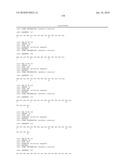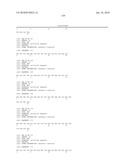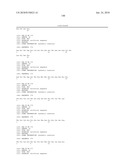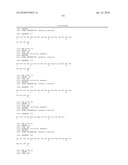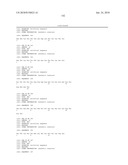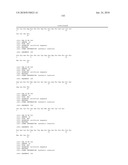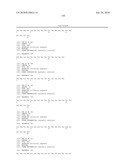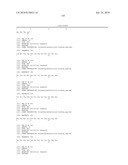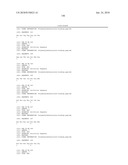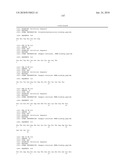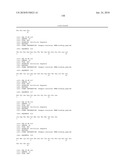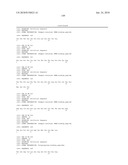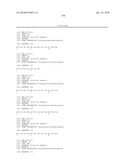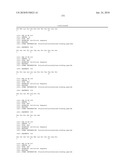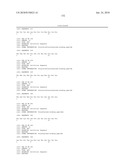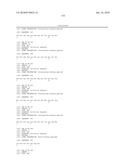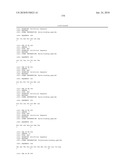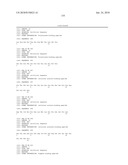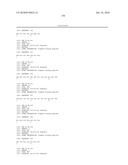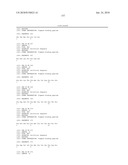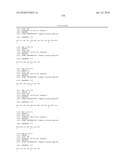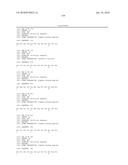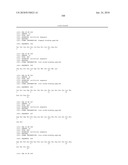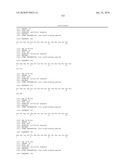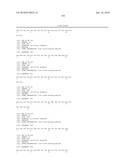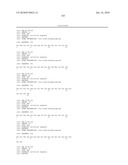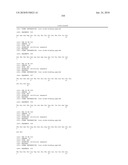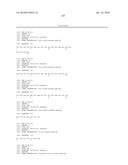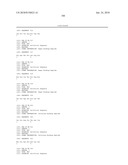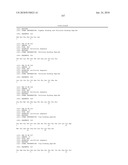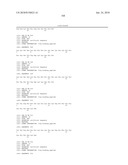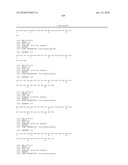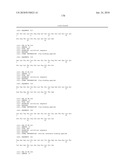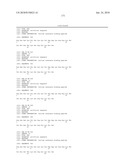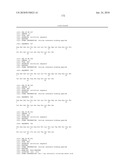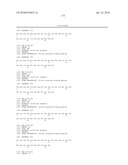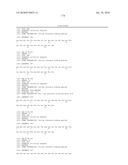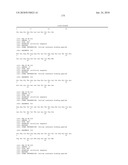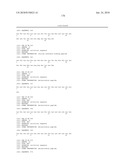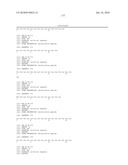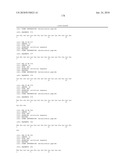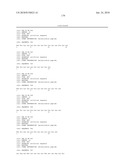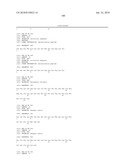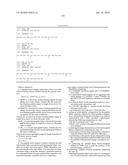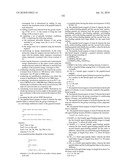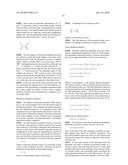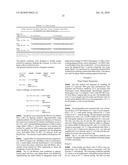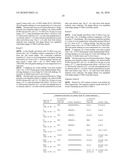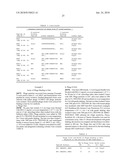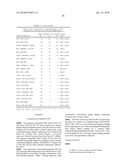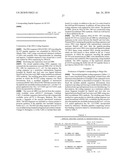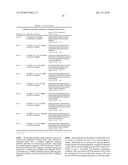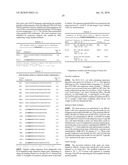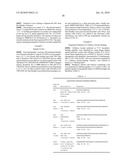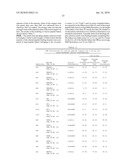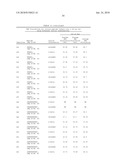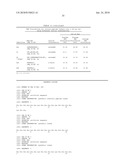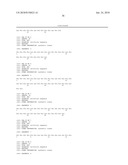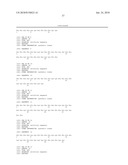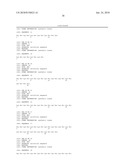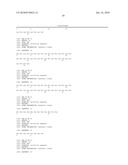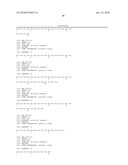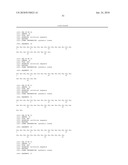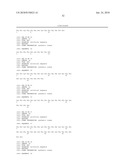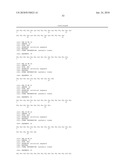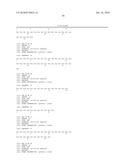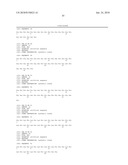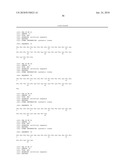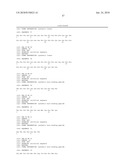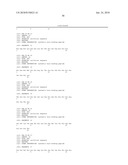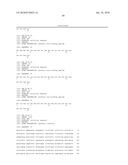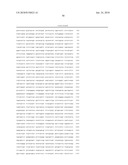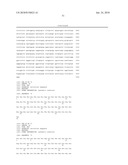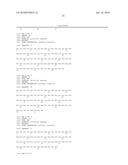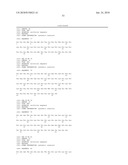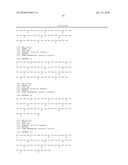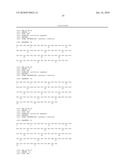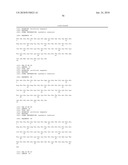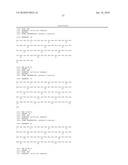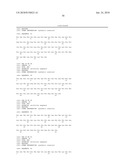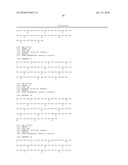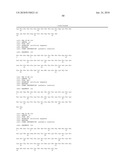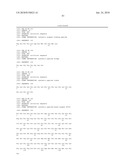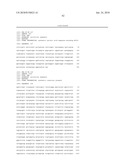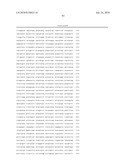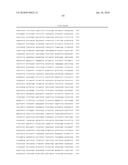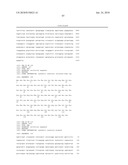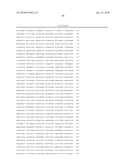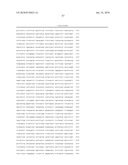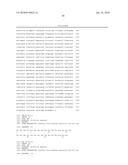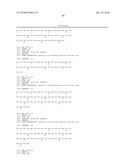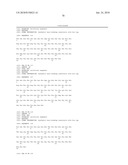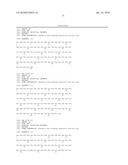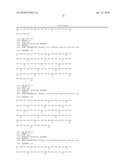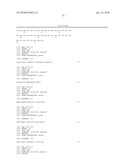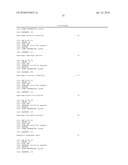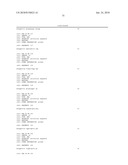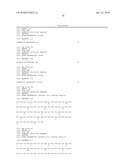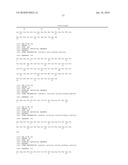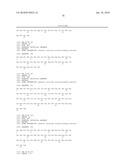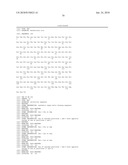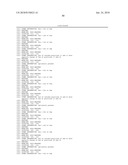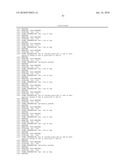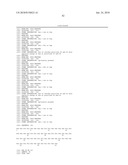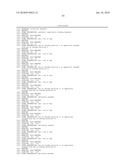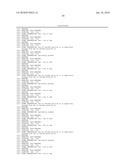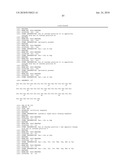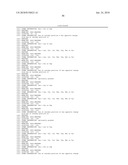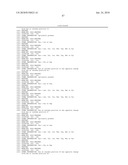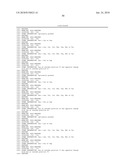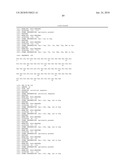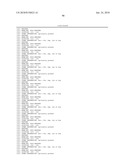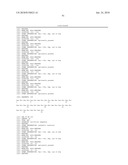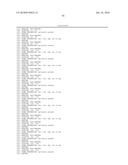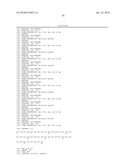Patent application title: PEPTIDE LINKERS FOR EFFECTIVE MULTIVALENT PEPTIDE BINDING
Inventors:
Qiong Cheng (Wilmington, DE, US)
Qiong Cheng (Wilmington, DE, US)
Stephen R. Fahnestock (Wilmington, DE, US)
Hongxian He (Wilmington, DE, US)
Hongxian He (Wilmington, DE, US)
Kristy N. Kostichka (Wilmington, DE, US)
Hong Wang (Kennett Square, PA, US)
Assignees:
E. I. DU PONT DE NEMOURS AND COMPANY
IPC8 Class: AA61K864FI
USPC Class:
424 49
Class name: Drug, bio-affecting and body treating compositions dentifrices (includes mouth wash)
Publication date: 2010-06-24
Patent application number: 20100158823
Claims:
1. A peptide-based reagent comprising at least one body surface-binding
domain (BSBD) having the general
structure:[(BSBP1)-RL1-(BSBP2)-(RL2)y].sub.x whereini)
BPBP1 is a first body surface-binding peptide having affinity for a body
surface; wherein the first body-surface-binding peptide ranges in length
from about 7 to about 60 amino acids;ii) BSBP2 is a second body
surface-binding peptide having affinity for the body surface; wherein the
first body surface-binding peptide and the second body surface-binding
peptide are the same or different;wherein the second body-surface-binding
peptide ranges in length from about 7 to about 60 amino acids;iii)
RL1 is a first rigid peptide linker; wherein the first rigid peptide
linker ranges in length from about 3 to 50 amino acids in length;iv)
RL2 is a second rigid peptide linker; wherein the first rigid
peptide linker and the second rigid peptide linker is the same or
different;wherein the second rigid linker ranges in length from about 3
to 50 amino acids in length;v) x=1 to 10; andvi) y=0 or 1.
2. The peptide-based reagent of claim 1 wherein the first rigid peptide linker and said second rigid peptide linker comprise an average root-mean-square (RMS) fluctuation over the entire length of the rigid linker of no more than 25 when calculated using a molecular dynamics simulation protocol for each peptide linker having a peptide linker sequence, said molecular dynamics simulation protocol comprising:a. providing a system having a set of initial parameters and algorithms comprising:i) a CHARMm simulation engine and a CHARMM27 force field;ii) a non-bonded cutoff distance of 14 angstroms with cutoff settings of CTOFNB=12 and CTONNB=10; the SWITCH cutoff method to calculate non-bonded terms;iii) a Particle Mesh Ewald summation method to calculate electrostatic interactions; andiv) a SHAKE algorithm to constrain bonds involving hydrogen atoms; andv) an integration time step set to 2 femtoseconds;b. setting an initial peptide configuration for the peptide linker sequence, wherein the initial peptide configuration is selected from the group consisting of an α-helical conformation and a fully extended conformation; wherein the following assumptions are used:i) the pH is assumed to be 7; andii) the N- and C-termini of the peptide linker are assumed to be charged;c. conducting an energy minimization on the initial peptide linker configuration comprising the steps of:i) performing an initial energy minimization calculation using the steepest descent method for 400 steps;ii) performing a subsequent energy minimization using the conjugated gradients method for 800 steps or until the gradient of the potential energy converged to 0.1; andiii) performing the Adopted Basis Newton-Raphson method for 2000 steps or until the gradient of the potential energy reached 0.1;d. conducting a peptide solvation simulation comprising the steps of:i) placing the peptide linker in the center of a rectangular box of water molecules; wherein the dimension of the rectangular box is determined by adding 16 angstroms to the maximum extent of the peptide linker in each direction;ii) adding counter-ions selected from the group consisting of Na.sup.+ or CL.sup.to the system to bring the total charge of the system to zero;iii) inputting a set of periodic boundary conditions (PBC) comprising the following settings:a) the maximum allowable distance of any group included in an image atom list is set to 14 angstroms; andb) the image atom list is updated using the heuristic method;iv) performing an energy minimization on the water molecules using the steepest descent method for 50 steps with the peptide linker sequence constrained using a harmonic constraint with a force constant of 25;v) removing the harmonic constraint and conducting the energy minimization on the entire system using the steepest descent method for 400 steps or until the total gradient of the potential energy converges to 0.01;e. conducting a heating simulation run wherein the system is heated from 0 Kelvin to 300 Kelvin with 5 Kelvin increments very 50 steps in 3000 steps;f. conducting an equilibration simulation run where the system is equilibrated at 300 Kelvin for 5000 steps;g. conducting a production simulation run in an NVT system at 300 Kelvin for 1,000,000 steps (200 picoseconds) wherein the coordinates of the atoms are saved every 100 steps (0.2 picoseconds) in a trajectory file;h. calculating room-mean-square (RMS) fluctuations for all phi (φ) and psi (ψ) torsion angles in the peptide using the coordinates of the atoms stored in the trajectory files; andi. averaging the phi and psi RMS fluctuations.
3. The peptide-based reagent of claim 1 wherein the rigid peptide linker is selected from the group consisting of:a) a salt bridge-stabilized α-helix of the general formula: TABLE-US-00023 (Xaa1-Xaa1-Ala-Ala-Xaa2-Xaa2)d or (Xaa1-Ala-Ala-Ala-Xaa2)d; or (Xaa1-Ala-Ala-Ala-Xaa2-Xaa3-Xaa3)d;
wherein;Xaa1=Glu or Asp;Xaa2=Lys or Arg; andXaa3=Leu, Val, Ile, Phe, Trp, Met or Tyr;wherein d=2 to 10 ;b) an extended proline dipeptide of the formula: TABLE-US-00024 (Xaa4-Pro)e or (Pro-Xaa4)e; or [(Xaa4-Pro)6-Gly-Gly]e
wherein e=2 to 20; and Xaa4 is an acidic or basic amino acid; andc) a peptide linker having the amino acid sequence of SEQ ID NO: 54
4. The peptide-based reagent of claim 1 wherein the first body surface-binding peptide and the second body surface-binding peptide are selected from the group consisting of hair-binding peptides, skin-binding peptides, nail-binding peptides, and tooth-binding peptides provided that both the first body surface-binding peptide and the second body surface-binding peptide have high affinity for the same body surface.
5. The peptide-based reagent of claim 4 wherein the first body surface-binding peptide and the second body-surface binding peptide individually have an MB50 value for the body surface of no more than 10.sup.-4 M.
6. The peptide-based reagent of claim 1 wherein said peptide-based reagent comprises a general structure selected from the group consisting of:a) (BSBD)f-BA;b) (BSBD)f-BR-BA; andc) [(BSBD)f-(BR)g-(BABD)h]i;whereini) BSBD is the body surface-binding domain of claim 1;ii) BR is a peptide bridge ranging from 1 to 60 amino acids in length;iii) BA is a benefit agent coupled to the peptide-based reagent;iv) BABD is a benefit agent-binding domain having affinity for a surface on the benefit agent; and whereinf=1 to 10;g=0 or 1;h=1 to 10; andi=1 to 10.
7. The peptide-based reagent of claim 6 wherein the benefit agent is covalently or non-covalently coupled to the peptide-based reagent.
8. The peptide-based reagent of claim 7 wherein the benefit agent is selected from the group consisting of conditioning agents, colorants, and antimicrobial agents.
9. The peptide-based reagent of claim 8 wherein the colorants are selected fro the group consisting of dyes, pigments, and lakes.
10. The peptide-based reagent of claim 9 wherein the colorant is a pigment.
11. The peptide based-reagent of claim 9 wherein the benefit agent binding domain (BABD) comprises the structure:[(BABP1)-RL3-(BABP2)-(RL4)k]j i) BABP1 is a first benefit agent-binding peptide; wherein the first benefit agent-binding peptide ranges in length from about 7 to about 60 amino acidsii) BABP2 is a second benefit agent-binding peptide; wherein the first benefit agent-binding peptide and the second benefit agent-binding peptide are the same or different; wherein the second benefit agent-binding peptide ranges in length from about 7 to about 60 amino acids;.iii) RL3 is a third rigid peptide linker; wherein the third rigid linker ranges in length from about 3 to 50 amino acids in lengthiv) RL4 is a fourth rigid peptide linker; wherein the third peptide linker and the fourth peptide linker is the same or different;wherein the forth rigid linker ranges in length from about 3 to 50 amino acids in length;v) j=1 to 10; andvi) k=0 or 1.
12. The peptide-based reagent of claim 11 wherein the third rigid linker and the forth rigid peptide linkers have an average root-mean-square fluctuation over the entire length of the peptide linker of no more than 25 using the molecular dynamics simulation protocol of claim 2.
13. A personal care composition comprising;a) east one peptide-based reagent of claim 1; andb) a benefit agent.
14. The personal care composition of claim 13 wherein the personal care composition is selected from the group consisting of hair care compositions, skin care compositions, nail care compositions, and oral care compositions.
15. The personal care composition of claim 13 wherein the benefit agent is a particulate benefit agent.
16. The personal care composition of claim 15 wherein the particulate benefit agent is coated with at least one polymer.
17. The personal care composition of claim 13 wherein the benefit agent is covalently or non-covalently coupled to the peptide-based reagent.
18. The personal care composition of claim 17 wherein the benefit agent is selected from the group consisting of conditioning agents, colorants, and antimicrobial agents.
19. The personal care composition of claim 18 wherein the colorants are selected from the group consisting of dyes, pigments, and lakes.
20. The personal care composition of claim 19 wherein the colorant is a pigment.
21. The personal care composition of claim 20 wherein the pigment is a white pigment.
22. The personal care composition of claim 14 wherein the hair care composition is in the form of a shampoo, a conditioner, a rinse, a lotion, an aerosol, a gel, a mousse or a hair dye.
23. The personal care composition of claim 14 wherein the skin care composition is in the form of a cream, a gel, a lotion, a capsule or a rinse.
24. The personal care composition of claim 14 wherein the oral care composition is in the form of a toothpaste, a dental cream, a gel or tooth powder, a mouth wash, a breath freshener or a dental floss
25. The personal care composition of claim 14 wherein the nail care composition is in the form of a nail polish or a nail protectant.
26. A peptide-based reagent comprises a body surface-binding domain having affinity for hair, wherein said body surface-binding domain comprises an amino acid sequence provided as SEQ ID N 0: 85.
27. A peptide-based reagent having an amino acid provided as SEQ ID NO: 106.
28. A hair-care composition comprising the peptide-based reagent of claim 26 or claim 27.
29. A method to couple an iron oxide-based pigment to hair is provided comprising:a) providing a hair care composition comprising;i) a peptide-based reagent having an amino acid sequence provided as SEQ ID NO: 106;ii) a pigment comprising iron oxide;b) contacting the hair care composition of (a) with hair whereby the iron oxide-based pigment is coupled to the hair and the hair changes in color.
30. The method of claim 29 wherein the hair care composition is in the form of a shampoo, a conditioner, a rinse, a lotion, an aerosol, a gel, a mousse or a hair dye.
31. A method to obtain a target surface-binding domain having affinity for a target surface is provided comprising:a) providing a monovalent phage display library of combinatorially generated phage peptides; wherein the phage peptides comprise the general structure:TSBP1-L-TSBP2;whereini) TSBP1 is a first target surface-binding peptide having affinity for a target surface;ii) TSBP2 is a second target surface-binding peptide having affinity for the target surface; wherein the first and second target surface-binding peptides may be the same or different; andiii) L is a rigid peptide linker;b) contacting the monovalent phage display library of (a) with a target surface sample to form a reaction solution comprising:(i) phage-phage peptide-target surface sample complex;(ii) unbound target surface sample, and(iii) uncomplexed phage-phage peptides;c) separating phage-phage peptide-target surface sample complex of (b) from the unbound target surface sample and the uncomplexed phage-phage peptides;d) determining the amino acid sequence of the phage peptide in the phage-phage peptide-target surface sample complex wherein the phage peptide has affinity for the target surface; ande) constructing a target surface-binding domain having the sequence of the phage peptide having affinity for the target surface.
32. A method for the design and identification of a rigid peptide linker useful for coupling target binding peptides wherein the rigid peptide linker has an average root-mean-square (RMS) fluctuation over the entire length of the rigid linker of no more than 25 when calculated using a molecular dynamics simulation protocol comprising the steps of:a. providing a system having a set of initial parameters and algorithms comprising:i) a CHARMm simulation engine and a CHARMM27 force field;ii) a non-bonded cutoff distance of 14 angstroms with cutoff settings of CTOFNB=12 and CTONNB=10; the SWITCH cutoff method to calculate non-bonded terms;iii) a Particle Mesh Ewald summation method to calculate electrostatic interactions; andiv) a SHAKE algorithm to constrain bonds involving hydrogen bonds; andv) an integration time step set to 2 femtoseconds;b. setting an initial peptide configuration for the peptide linker sequence, wherein the initial peptide configuration is selected from the group consisting of an α-helical conformation and a fully extended conformation; wherein the following assumptions are used:i) the pH is assumed to be 7; andii) the N- and C-termini of the peptide linker are assumed to be charged;c. conducting an energy minimization on the initial peptide linker configuration comprising the steps of:i) performing an initial energy minimization calculation using the steepest descent method for 400 steps;ii) performing a subsequent energy minimization using the conjugated gradients method for 800 steps or until the gradient of the potential energy converged to 0.1; andiii) performing the Adopted Basis Newton-Raphson method for 2000 steps or until the gradient of the potential energy reached 0.1;d. conducting a peptide solvation simulation comprising the steps of:i) placing the peptide linker in the center of a rectangular box of water molecules; wherein the dimension of the rectangular box is determined by adding 16 angstroms to the maximum extent of the peptide linker in each direction;ii) adding counter-ions selected from the group consisting of Na.sup.+ or CL.sup.to the system to bring the total charge of the system to zero;iii) inputting a set of periodic boundary conditions (PBC) comprising the following settings:a) the maximum allowable distance of any group included in an image atom list is set to 14 angstroms; andb) the image atom list is updated using the heuristic method;iv) performing an energy minimization on the water molecules using the steepest descent method for 50 steps with the peptide linker sequence constrained using a harmonic constraint with a force constant of 25;v) removing the harmonic constraint and conducting the energy minimization on the entire system using the steepest descent method for 400 steps or until the total gradient of the potential energy converges to 0.01;e. conducting a heating simulation run wherein the system is heated from 0 Kelvin to 300 Kelvin with 5 Kelvin increments very 50 steps in 3000 steps;f. conducting an equilibration simulation run where the system is equilibrated at 300 Kelvin for 5000 steps;g. conducting a production simulation run in an NVT system at 300 Kelvin for 1,000,000 steps (200 picoseconds) wherein the coordinates of the atoms are saved every 100 steps (0.2 picoseconds) in a trajectory file;h. calculating room-mean-square (RMS) fluctuations for all phi (φ) and psi (ψ) torsion angles in the peptide using the coordinates of the atoms stored in the trajectory files; andi. averaging the phi and psi RMS fluctuations; andj. identifying those peptides having an average root-mean-square (RMS) fluctuation of no more than 25.
Description:
CROSS-REFERENCE TO A RELATED APPLICATION
[0001]This application claims the benefit of U.S. Provisional Patent Application No. 61/138,633 filed Dec. 18, 2008, incorporated herein by reference.
FIELD OF THE INVENTION
[0002]The invention relates to methods of identifying and using peptide linkers characterized by a high level of rigidity to prepare single chain target surface-binding domains as well as single chain peptide-based reagents. More specifically, target surface-binding domains comprising a plurality of single chain target surface-binding peptides separated by at least one rigid peptide linker exhibit higher affinity for the target surface in comparison to target surface binding domains having flexible peptide linkers. One or more of the target surface binding domains can be incorporated into single chain peptide-based reagents for delivery of a benefit agent to target surface.
BACKGROUND OF THE INVENTION
[0003]Proteinaceous materials coupled to one or more cosmetic care benefit agents have been reported in the art. Lang et al. in U.S. Pat. No. 5,192,332 describe temporary coloring compositions that contain an animal or vegetable protein, or hydrolysate thereof, which contain residues of dye molecules (e.g., benefit agents) grafted onto the protein chain. In the Lang et al. compositions, the protein serves as a conditioning agent and does not provided targeted delivery or enhanced durability for coupling the benefit agent to the target surface.
[0004]Proteinaceous materials having strong affinity for a body surface have been used for targeted delivery of one or more personal care benefit agents. However, many of the materials used for targeted delivery are comprised or derived from immunoglobulins or immunoglobulin fragments (antibodies, antibody fragments, Fab, single-chain variable fragments (scFv), and Camelidae VHH) having affinity for the target surface. For example, Horikoshi et al. in JP 08104614 and Igarashi et al. in U.S. Pat. No. 5,597,386 describe hair coloring agents that consist of an anti-keratin antibody covalently attached to a dye or pigment. The antibody binds to the hair, thereby enhancing the binding of the hair coloring agent to the hair. Similarly, Kizawa et al. in JP 09003100 describe an antibody that recognizes the surface layer of hair and its use to treat hair. A hair coloring agent consisting of the anti-hair antibody coupled to colored latex particles is also described. The use of antibodies to enhance the binding of dyes to the hair is effective in increasing the durability of the hair coloring, but the antibodies are difficult and expensive to produce. Terada et al. in JP 2002363026 describe the use of conjugates consisting of single-chain antibodies, preferably anti-keratin, coupled to dyes, ligands, and cosmetic agents for skin and hair care compositions. Although single-chain antibodies may be prepared using genetic engineering techniques, these molecules are expensive to prepare and may not be suitable for use in commercial personal care products due to their conserved structure (i.e., immunoglobulin folds) and large size.
[0005]Non-immunoglobulin derived scaffold proteins have also been developed for targeted delivery of benefit agents to a target surface, such as delivery of cosmetic agents to keratin-containing materials (See Binz, H. et al. (2005) Nature Biotechnology 23, 1257-1268 for a review of various proteins used in scaffold-assisted binding). Findlay in WO 00/048558 describes the use of calycin-like scaffold proteins, such as β-lactoglobulin, which contain a binding domain for a cosmetic agent and another binding domain that binds to at least a part of the surface of a hair fiber or skin surface, for conditioners, dyes, and perfumes. Houtzager et a. in WO 03/050283 and US 2006/0140889 also describe affinity proteins having a defined core scaffold structure for controlled application of cosmetic substances. As with immunoglobulin-like proteins, these large scaffold proteins are somewhat limited by the requirement to maintain the underlying core structure for effective binding and are expensive to produce.
[0006]Short, single chain peptides (i.e., "target surface-binding peptides") having strong affinity for a target surface can be identified and isolated from peptide libraries using any number of biopanning techniques well known to those skilled in the art including, but not limited to bacterial display, yeast display, combinatorial solid phase peptide synthesis, phage display, ribosome display, and mRNA display technology (PROFUSION®, U.S. Pat. No. 6,258,558. Techniques to generate random peptide libraries are described in Dani, M., J. of Receptor & Signal Transduction Res., 21(4):447-468 (2001). Phage display libraries are available commercially from companies such as New England BioLabs (Beverly, Mass.).
[0007]The target surface-binding peptides are typically no more than 60 amino acids in length and often have a binding affinity (as measured by an MB50 or KD value) of 10-4 M or less for the target surface. These short peptides may be used in some applications as an interfacial material to couple one or more benefit agents to the target surface. However, for some commercial applications the individual biopanned peptides (herein referred to as providing a "monovalent" interaction) may not provide the durability necessary to achieve the desired effect. The lack in durability may be especially evident when attempting to couple a particulate benefit agent to the target surface.
[0008]Single chain peptide-based reagents lacking a scaffold support or immunoglobulin fold have been developed that can be used to couple benefit agents to a target surface. Examples of target surfaces include, but not are limited to body surfaces such as hair, skin, nail, and teeth (U.S. Pat. Nos. 7,220,405; 7,309,482; and 7,285,264; U.S. Patent Application Publication Nos. 2005-0226839; 2007-0196305; 2006-0199206; 2007-0065387; 2008-0107614; 2007-0110686; and 2006-0073111; and published PCT applications WO2008/054746; WO02004/048399; and WO2008/073368) as well as other surfaces such as pigments and miscellaneous print media (U.S. Patent Application Publication No. 2005-0054752), and various polymers such as polymethylmethacrylate (U.S. Patent Application Publication No. 2007-0265431), polypropylene (U.S. Patent Application Publication No. 2007-0264720), nylon (U.S. Patent Application Publication Nos. 2007-0141629 and 2003-0185870), polytetrafluoroethylene (U.S. patent application Ser. No. 11/607734), polyethylene (U.S. Patent Application Publication No. 2007-0141628), and polystyrene (U.S. Patent Application Publication No. 2007-0261775). However, some single chain peptide-based reagents may lack the durability required for certain commercial applications, especially when coupling a particulate benefit agent to a body surface in a highly stringent matrix.
[0009]Single chain target surface-binding domains (herein referred to as "hands") may be prepared by linking together a plurality of target surface-binding peptides (herein referred to as "fingers"). However, due to the absence of a scaffold or core structure to help control the translational and rotational entropies lost in binding between ligands (e.g., the target surface-binding peptides) and the associated polyvalent receptor (i.e., the target surface, such as a body surface), many single chain target surface-binding domains that are unstructured in solution do not exhibit polyvalent interactions. As such, rationally-designing single chain peptide reagents is often difficult. This is particularly true when attempting to design single chain peptide reagents having affinity for a target surface that is heterogeneous in nature and/or wherein the binding motifs may not be well characterized. As such, rationally-designing target surface binding domains capable of effectively forming (or promoting the formation of) multivalent associations from singe chain target surface-binding peptides remains a problem to be addressed for certain commercial applications. This is especially true for single chain target surface-binding domains lacking a conserved scaffold support, as the entropy associated with the unstructured system may adversely impact the formation of stable multivalent interactions.
[0010]Mammen et al., (Angew. Chem. Int. Ed. (1998) 37:2754-2794) examines and reviews the theoretical considerations of polyvalent interactions in biological systems and the central role entropy plays in polyvalency. Polyvalent interactions can be collectively much stronger than corresponding monovalent interactions. The increase in affinity observed with multivalent binding vs. monovalent binding is mostly attributed to decreases in the rate of dissociation (Koff) rather than an increase in the rate of association (Kon). Mammen et al. provides examples of biological systems involving polyvalent interactions including, but not limited to ligand--receptor interactions between bacterium and host cell matrices, antibody--antigen interactions, virus and host cell receptors, and signal transduction interactions, to name a few.
[0011]The entropy of a polyvalent interaction is a combination of the translational and rotational entropies (Mammen et al., J. Org. Chem. (1998) 63:3168-3175 and Mammen et al., J Org. Chem. (1998) 63:3821-3830). Due to the absence of a scaffold or core structure to help control the translational and rotational entropies present between ligands (e.g. , the target surface-binding peptides) and the associated polyvalent receptor (i.e., the target surface, such as a body surface), single chain target surface-binding domains and/or single peptide-based reagents may not exhibit multivalent binding behavior.
[0012]One problem to be solved is to provide single chain peptide-based reagents comprising one or more single chain target surface-binding domains exhibiting strong binding affinity for the target surface.
[0013]Another problem to be solved is to provide a method of identifying single chain target surface-binding domains having strong affinity for a target surface. Preferably the method provides target surface-binding domains that exhibit multivalent binding characteristics for the target surface.
[0014]A method of coupling a benefit agent to a target surface using a single chain peptide-based reagent comprising at least one target surface-binding domain exhibiting strong affinity for the target surface is also needed.
SUMMARY OF THE INVENTION
[0015]The stated problems have been solved by discovering that single chain target surface-binding domains comprising a plurality of target surface-binding peptides separated by peptide linkers having limited flexibility (i.e., "rigid peptide linkers") typically provide the highest binding affinity for the respective target surface. Although not bound by theory, it is believed that the use of rigid peptide linkers to separate the various target surface-binding peptides effectively promotes and enhances multivalent binding. Peptide-based reagents comprising one or more of the present target surface-binding domains are also provided.
[0016]In one embodiment, a peptide-based reagent is provided comprising at least one target surface-binding domain (TSBD) having the general structure:
[(TSBP1)-RL1-(TSBP2)-(RL2)da wherein [0017]i) TSBP1 is a first target surface-binding peptide having affinity for a target surface; wherein the first target-surface-binding peptide ranges in length from about 7 to about 60 amino acids; [0018]ii) TSBP2 is a second target surface-binding peptide having affinity for the target surface; wherein the first target surface-binding peptide and the second target surface-binding peptide are the same or different; wherein the second target-surface-binding peptide ranges in length from about 7 to about 60 amino acids; [0019]iii) RL1 is a first rigid peptide linker; wherein the first rigid peptide linker ranges in length from about 3 to 50 amino acids in length; [0020]iv) RL2 is a second rigid peptide linker; wherein the first rigid peptide linker and the second peptide linker are the same or different;wherein the second rigid linker ranges in length from about 3 to 50 amino acids in length; [0021]v) a=1 to 10; and [0022]vi) b=0 or 1.
[0023]The present peptide-based reagents are may be used in personal care applications for delivery of a benefit agent to a body surface.
[0024]In another embodiment, a peptide-based reagent is provided comprising at least one body surface-binding domain (BSBD) having the general structure:
[(BSBP1)-RL1-(BSBP2)-(RL2)y].sub.x wherein [0025]i) BPBP1 is a first body surface-binding peptide having affinity for a body surface; wherein the first body-surface-binding peptide ranges in length from about 7 to about 60 amino acids; [0026]ii) BSBP2 is a second body surface-binding peptide having affinity for the body surface; wherein the first body surface-binding peptide and the second body surface-binding peptide are the same or different;wherein the second body-surface-binding peptide ranges in length from about 7 to about 60 amino acids; [0027]iii) RL1 is a first rigid peptide linker; wherein the first rigid peptide linker ranges in length from about 3 to 50 amino acids in length; [0028]iv) RL2 is a second rigid peptide linker; wherein the first rigid peptide linker and the second peptide linker are the same or different;wherein the second rigid linker ranges in length from about 3 to 50 amino acids in length; [0029]v) x=1 to 10; and [0030]vi) y=0or 1.
[0031]In another embodiment, the rigid peptides linkers used in the present peptide-based reagents comprise an average root mean square (RMS) fluctuation over the length of the entire peptide linker of no more than 25 when calculated using a molecular dynamics simulation protocol for each peptide linker having a peptide linker sequence, said molecular dynamics simulation protocol comprising:
[0032]a. providing a system having a set of initial parameters and algorithms comprising: [0033]i) a CHARMm simulation engine and CHARMM27 force field; [0034]ii) a non-bonded cutoff distance of 14 angstroms with cutoff settings of CTOFNB=12 and CTONNB=10; the SWITCH cutoff method to calculate non-bonded terms; [0035]iii) a Particle Mesh Ewald (PME) summation method to calculate electrostatic interactions; and [0036]iv) a SHAKE algorithm to constrain bonds involving hydrogen atoms; and [0037]v) an integration time step set to 2 femtoseconds;
[0038]b. setting an initial peptide configuration for the peptide linker sequence, wherein the initial peptide configuration is selected from the group consisting of anα-helical conformation and a fully extended conformation; wherein the following assumptions are used: [0039]i) the pH is assumed to be 7; and [0040]ii) the N-termini and C-termini of the peptide linker are assumed to be charged;
[0041]c. conducting an energy minimization on the initial peptide linker configuration comprising the steps of: [0042]i) performing an initial energy minimization calculation using steepest descent method for 400 steps; [0043]ii) performing a subsequent energy minimization using a conjugated gradients method for 800 steps or until the gradient of the potential energy converged to 0.1; and [0044]iii) performing an Adopted Basis Newton-Raphson method for 2000 steps or until the gradient of the potential energy reached 0.1;
[0045]d. conducting a peptide solvation simulation comprising the steps of: [0046]i) placing the peptide linker in the center of a rectangular box of water molecules; wherein the dimension of the rectangular box is determined by adding 16 angstroms to the maximum extent of the peptide linker in each direction; [0047]ii) adding counter-ions selected from the group consisting of Na.sup.+ or Cl.sup.- to the system to bring the total charge of the system to zero; [0048]iii) inputting a set of periodic boundary conditions (PBC) comprising the following settings: [0049]a) the maximum allowable distance of any group included in an image atom list is set to 14 angstroms; and [0050]b) the image atom list is updated using the heuristic method; [0051]iv) performing an energy minimization on the water molecules using the steepest descent method for 50 steps with the peptide linker sequence constrained using a harmonic constraint with a force constant of 25; [0052]v) removing the harmonic constraint and conducting the energy minimization on the entire system using the steepest descent method for 400 steps or until the total gradient of the potential energy converges to 0.01;
[0053]e. conducting a heating simulation run wherein the system is heated from 0 Kelvin to 300 Kelvin with 5 Kelvin increments very 50 steps in 3000 steps;
[0054]f. conducting an equilibration simulation run where the system is equilibrated at 300 Kelvin for 5000 steps;
[0055]g. conducting a production simulation run in an NVT system at 300 Kelvin for 1,000,000 steps (200 picoseconds) wherein the coordinates of the atoms are saved every 100 steps (0.2 picoseconds) in a trajectory file;
[0056]h. calculating room-mean-square (RMS) fluctuations for all phi (φ) and psi (ψ) torsion angles in the peptide using the coordinates of the atoms stored in the trajectory files; and
[0057]i. averaging the phi and psi RMS fluctuations.
[0058]In another embodiment, the present peptide-based reagents comprise a binding domain prepared using a rigid peptide linker selected from the group consisting of:
[0059]a) a salt bridge stabilized α-helix of the general formula:
TABLE-US-00001 (Xaa1-Xaa1-Ala-Ala-Lys-Lys)d or (Xaa1-Ala-Ala-Ala-Xaa2)d; or (Xaa1-Ala-Ala-Ala-Xaa2-Xaa3-Xaa3)d;
[0060]wherein; [0061]Xaa1=Glu or Asp; [0062]Xaa2=Lys or Arg; [0063]Xaa3=Leu, Ile, Val, Phe, Trp, Tyr, and Met; and [0064]d=2 to 10;
[0065]b) an extended proline dipeptide of the formula:
TABLE-US-00002 (Xaa4-Pro)e or (Pro-Xaa4)e; or [(Xaa4-Pro)6-Gly-Gly]e
[0066]wherein e=2 to 20; and Xaa4 is an acidic or a basic amino acid; and
[0067]c) a peptide linker having the amino acid sequence SEQ ID NO: 54.
[0068]The peptide-based reagent may be coupled directly to a benefit agent, coupled to the benefit agent through a peptide bridge, or may be coupled via a peptide bridge to a benefit agent-binding domain having affinity for the surface on the benefit agent. As such, a peptide-based reagent is also provided comprising the general structure selected from the group consisting of:
[0069]a) (BSBD)f-BA;
[0070]b) (BSBD)f-BR-BA; and
[0071]c) [(BSBD)f-(BR)g-(BABD)h]i;
[0072]wherein [0073]i) BSBD is a body surface-binding domain comprising at least one rigid peptide linker; [0074]ii) BA is a benefit agent; [0075]iii) BR is a peptide bridge ranging from 1 to 60 amino acids in length; and [0076]iv) BABD is a benefit agent-binding domain; and [0077]wherein [0078]f=1 to 10; [0079]g=0 or 1; [0080]h=1 to 10; and [0081]i=1 to 10.
[0082]In another embodiment, the peptide-based reagent comprises a benefit agent-binding domain having at least one rigid peptide linker, said benefit agent-binding domain have the general structure:
(BABP1)-RL3-(BABP2)-(RL4)k]j wherein [0083]i) BABP1 is a first benefit agent-binding peptide having affinity for a particulate benefit agent surface; wherein the first benefit agent-binding peptide ranges in length from about 7 to about 60 amino acids; [0084]ii) BABP2 is a second benefit agent-binding peptide having affinity for the particulate benefit agent surface; wherein the first benefit agent-binding peptide and the second benefit agent-binding peptide are the same or different; wherein the second benefit agent-binding peptide ranges in length from about 7 to about 60 amino acids; [0085]iii) RL3 is a third rigid peptide linker; wherein the third rigid peptide linker ranges in length from about 3 to 50 amino acids; [0086]iv) RL4 is a fourth rigid peptide linker; wherein the third rigid peptide linker and the fourth rigid peptide linker are the same or different;wherein the fourth rigid peptide linker ranges in length from about 3 to 50 amino acids; [0087]v) j=1 to 10; and [0088]vi) k=0 or 1.
[0089]In another embodiment, personal care compositions comprising the present peptide-based reagents are also provided.
[0090]In another embodiment, the target surface-binding peptides (i.e., "fingers") independently have a KD or MB50 value for their respective surface of 10-4 M or less.
[0091]In another embodiment, a method to couple a benefit agent to a body surface is provided comprising:
[0092]a) providing a personal care composition comprising: [0093]i) at least one of the present peptide-based reagents having affinity for a body surface; and [0094]ii) a benefit agent;
[0095]b) contacting the body surface with the personal care composition of (a) whereby the benefit agent is coupled by said at least one peptide-based reagent to the body surface.
[0096]In one embodiment, the peptide-based reagent comprises a body surface-binding domain having affinity for hair, said body surface-binding domain comprising an amino acid sequence selected from the group consisting of SEQ ID NOs: 73, 74, 75, 76, 77, 78, 83, 85, 88, 89, 90, 91, 92, 93, 94, 96, 97, 98, 99, 100, 101, and 102.
[0097]In another embodiment, the peptide-based reagent comprises a body surface-binding domain having affinity for hair, said body surface binding domain comprises an amino acid sequence provided as SEQ ID NO: 85.
[0098]In another embodiment, the peptide-based reagent is peptide HC353 having an amino acid SEQ ID NO: 106.
[0099]In another embodiment, a method to couple a pigment to hair is provided comprising:
[0100]a) providing a hair care composition comprising: [0101]i) a peptide-based reagent having an amino acid sequence SEQ ID NO: 106; and [0102]ii) a pigment comprising iron oxide; and
[0103]b) contacting the hair care composition of (a) with hair whereby the pigment is coupled to the hair.
[0104]In another embodiment, a method to obtain a target surface-binding domain having affinity for a target surface is provided comprising:
[0105]a) providing a monovalent phage display library of combinatorially generated phage peptides; wherein the phage peptides comprise the general structure: [0106]TSBP1-L-TSBP2; [0107]wherein [0108]i) TSBP1 is a first target surface-binding peptide having affinity for a target surface; [0109]ii) TSBP2 is a second target surface-binding peptide having affinity for the target surface; wherein the first and second target surface-binding peptides may be the same or different; and [0110]iii) L is a rigid peptide linker;
[0111]b) contacting the monovalent phage display library of (a) with a target surface sample to form a reaction solution comprising: [0112](i) phage-phage peptide-target surface sample complex; [0113](ii) unbound target surface sample, and [0114](iii) uncomplexed phage-phage peptides;
[0115]c) separating phage-phage peptide-target surface sample complex of (b) from the unbound target surface sample and the uncomplexed phage-phage peptides;
[0116]d) determining the amino acid sequence of the phage peptide in the phage-phage peptide-target surface sample complex wherein the phage peptide has affinity for the target surface; and
[0117]e) constructing a target surface-binding domain having the sequence of the phage peptide having affinity for the target surface.
BRIEF DESCRIPTION OF FIGURES AND SEQUENCE DESCRIPTIONS
[0118]The various embodiments of the invention can be more fully understood from the following detailed description, figure and the accompanying sequence descriptions, which form a part of this application.
[0119]FIG. 1 is a plasmid map of pDCQ460
[0120]FIG. 2 is a plasmid map of pLD001
[0121]FIG. 3 is a plasmid map of pLD1475
[0122]FIG. 4 is a bar graph of the hair-binding ELISA results.
[0123]FIG. 5 is a typical binding kinetics curve for injection and buffer wash phases in Surface Plasmon Resonance sensorgram.
[0124]FIG. 6 is shows the net response units (RU) for various peptide concentration plots for all tested cellulose acetate-binding peptides described in Example 8.
BRIEF DESCRIPTION OF THE BIOLOGICAL SEQUENCES
[0125]The following sequences comply with 37 C.F.R. 1.821-1.825 ("Requirements for Patent Applications Containing Nucleotide Sequences and/or Amino Acid Sequence Disclosures--the Sequence Rules") and are consistent with World Intellectual Property Organization (WIPO) Standard ST.25 (1998) and the sequence listing requirements of the EPC and PCT (Rules 5.2 and 49.5(a-bis), and Section 208 and Annex C of the Administrative Instructions). The symbols and format used for nucleotide and amino acid sequence data comply with the rules set forth in 37 C.F.R. §1.822
[0126]SEQ ID NO: 1 is the amino acid sequence of peptide linker La3 with N-terminal Gly-Pro and C-terminal Pro-Ala residues.
[0127]SEQ ID NO: 2 is the amino acid sequence of peptide linker La3.
[0128]SEQ ID NO: 3 is the amino acid sequence of peptide linker La5 with N-terminal Gly-Pro and C-terminal Pro-Ala residues.
[0129]SEQ ID NO: 4 is the amino acid sequence of peptide linker La5.
[0130]SEQ ID NO: 5 is the amino acid sequence of peptide linker La6 with N-terminal Gly-Pro and C-terminal Pro-Ala residues.
[0131]SEQ ID NO: 6 is the amino acid sequence of peptide linker La6.
[0132]SEQ ID NO: 7 is the amino acid sequence of peptide linker Lb2 with N-terminal Gly-Pro and C-terminal Pro-Ala residues.
[0133]SEQ ID NO: 8 is the amino acid sequence of peptide linker Lb2.
[0134]SEQ ID NO: 9 is the amino acid sequence of peptide linker Lb4 with N-terminal Gly-Pro and C-terminal Pro-Ala residues.
[0135]SEQ ID NO: 10 is the amino acid sequence of peptide linker Lb4.
[0136]SEQ ID NO: 11 is the amino acid sequence of peptide linker Lb5 with N-terminal Gly-Pro and C-terminal Pro-Ala residues.
[0137]SEQ ID NO: 12 is the amino acid sequence of peptide linker Lb5.
[0138]SEQ ID NO: 13 is the amino acid sequence of peptide linker Lc4 with N-terminal Gly-Pro and C-terminal Pro-Ala residues.
[0139]SEQ ID NO: 14 is the amino acid sequence of peptide linker Lc4.
[0140]SEQ ID NO: 15 is the amino acid sequence of peptide linker Lc8 with N-terminal Gly-Pro and C-terminal Pro-Ala residues.
[0141]SEQ ID NO: 16 is the amino acid sequence of peptide linker Lc8.
[0142]SEQ ID NO: 17 is the amino acid sequence of peptide linker Lc12 with N-terminal Gly-Pro and C-terminal Pro-Ala residues.
[0143]SEQ ID NO: 18 is the amino acid sequence of peptide linker Lc12.
[0144]SEQ ID NO: 19 is the amino acid sequence of peptide linker Lc16 with N-terminal Gly-Pro and C-terminal Pro-Ala residues.
[0145]SEQ ID NO: 20 is the amino acid sequence of peptide linker Lc16.
[0146]SEQ ID NO: 21 is the amino acid sequence of peptide linker Ld2 with N-terminal Gly-Pro and C-terminal Pro-Ala residues.
[0147]SEQ ID NO: 22 is the amino acid sequence of peptide linker Ld2.
[0148]SEQ ID NO: 23 is the amino acid sequence of peptide linker Ld4 with N-terminal Gly-Pro and C-terminal Pro-Ala residues.
[0149]SEQ ID NO: 24 is the amino acid sequence of peptide linker Ld4.
[0150]SEQ ID NO: 25 is the amino acid sequence of peptide linker Ld6 with N-terminal Gly-Pro and C-terminal Pro-Ala residues.
[0151]SEQ ID NO: 26 is the amino acid sequence of peptide linker Ld6.
[0152]SEQ ID NO: 27 is the amino acid sequence of peptide linker Le2 with N-terminal Gly-Pro and C-terminal Pro-Ala residues.
[0153]SEQ ID NO: 28 is the amino acid sequence of peptide linker Le2.
[0154]SEQ ID NO: 29 is the amino acid sequence of peptide linker Le4 with N-terminal Gly-Pro and C-terminal Pro-Ala residues.
[0155]SEQ ID NO: 30 is the amino acid sequence of peptide linker Le4.
[0156]SEQ ID NO: 31 is the amino acid sequence of peptide linker Le6 with N-terminal Gly-Pro and C-terminal Pro-Ala residues.
[0157]SEQ ID NO: 32 is the amino acid sequence of peptide linker Le6.
[0158]SEQ ID NO: 33 is the amino acid sequence of peptide linker Lf2 with N-terminal Gly-Pro and C-terminal Pro-Ala residues.
[0159]SEQ ID NO: 34 is the amino acid sequence of peptide linker Lf2.
[0160]SEQ ID NO: 35 is the amino acid sequence of peptide linker Lf4 with N-terminal Gly-Pro and C-terminal Pro-Ala residues.
[0161]SEQ ID NO: 36 is the amino acid sequence of peptide linker Lf4.
[0162]SEQ ID NO: 37 is the amino acid sequence of peptide linker Lf6 with N-terminal Gly-Pro and C-terminal Pro-Ala residues.
[0163]SEQ ID NO: 38 is the amino acid sequence of peptide linker Lf6.
[0164]SEQ ID NO: 39 is the amino acid sequence of peptide linker Lg1 with N-terminal Gly-Pro and C-terminal Pro-Ala residues.
[0165]SEQ ID NO: 40 is the amino acid sequence of peptide linker Lg1.
[0166]SEQ ID NO: 41 is the amino acid sequence of peptide linker Lg2 with N-terminal Gly-Pro and C-terminal Pro-Ala residues.
[0167]SEQ ID NO: 42 is the amino acid sequence of peptide linker Lg2.
[0168]SEQ ID NO: 43 is the amino acid sequence of peptide linker Lg3 with N-terminal Gly-Pro and C-terminal Pro-Ala residues.
[0169]SEQ ID NO: 44 is the amino acid sequence of peptide linker Lg3.
[0170]SEQ ID NO: 45 is the amino acid sequence of peptide linker Lh1 with N-terminal Gly-Pro and C-terminal Pro-Ala residues.
[0171]SEQ ID NO: 46 is the amino acid sequence of peptide linker Lh1.
[0172]SEQ ID NO: 47 is the amino acid sequence of peptide linker Lh2 with N-terminal Gly-Pro and C-terminal Pro-Ala residues.
[0173]SEQ ID NO: 48 is the amino acid sequence of peptide linker Lh2.
[0174]SEQ ID NO: 49 is the amino acid sequence of peptide linker Lh3 with N-terminal Gly-Pro and C-terminal Pro-Ala residues.
[0175]SEQ ID NO: 50 is the amino acid sequence of peptide linker Lh3.
[0176]SEQ ID NO: 51 is the amino acid sequence of peptide linker Lj with N-terminal Gly-Pro and C-terminal Pro-Ala residues.
[0177]SEQ ID NO: 52 is the amino acid sequence of peptide linker Lj.
[0178]SEQ ID NO: 53 is the amino acid sequence of peptide linker Lk with N-terminal Gly-Pro and C-terminal Pro-Ala residues.
[0179]SEQ ID NO: 54 is the amino acid sequence of peptide linker Lk.
[0180]SEQ ID NO: 55 is the amino acid sequence of peptide linker Lm3 with N-terminal Gly-Pro and C-terminal Pro-Ala residues.
[0181]SEQ ID NO: 56 is the amino acid sequence of peptide linker Lm3.
[0182]SEQ ID NO: 57 is the amino acid sequence of peptide linker Lm4 with N-terminal Gly-Pro and C-terminal Pro-Ala residues.
[0183]SEQ ID NO: 58 is the amino acid sequence of peptide linker Lm4.
[0184]SEQ ID NOs: 59-70 are various body surface-binding peptides described in Example 1.
[0185]SEQ ID NO: 71 is the nucleic acid sequence of phagemid vector pDCQ460.
[0186]SEQ ID NOs: 72-90 are the amino acid sequences of various hair-binding domains identified after 4th round of phage biopanning.
[0187]SEQ ID NOs: 73-78, 83, 85, 88, and 90-102 are the amino acid sequences of various hair-binding domains identified to bind strongly to hair based on the phage titer and ELISA experiments.
[0188]SEQ ID NO: 103 is the amino acid sequence of pigment-binding peptide having affinity for an iron oxide-based pigments.
[0189]SEQ ID NO: 104 is the amino sequence of a peptide bridge in peptide reagent HC353.
[0190]SEQ ID NO: 105 is the amino acid sequence of a cationic linker used to link together 2 copies of the pigment-binding peptides of SEQ ID NO: 103.
[0191]SEQ ID NO: 106 is the amino acid sequence of peptide reagent HC353.
[0192]SEQ ID NO: 107 is the nucleic acid sequence encoding peptide reagent HC353.
[0193]SEQ ID NO 108 is the nucleic acid sequence of expression vector pLD001.
[0194]SEQ ID NO: 109 is the amino acid sequence of inclusion body tag KSI(C4)E.
[0195]SEQ ID NO: 110 is the nucleic acid sequence of expression vector pLD1474.
[0196]SEQ ID NOs: 111-124 are the amino acid sequences of various modular hair-binding hands comprising a hexahistidine tag.
[0197]SEQ ID NOs: 125-145 are PCR primers.
[0198]SEQ ID NO: 146 is the amino acid sequence of the hair-binding domain in peptide HC365.
[0199]SEQ ID NO: 147 is the amino acid sequence of the hair-binding domain in peptide HC366.
[0200]SEQ ID NO: 148 is the amino acid sequence of the hair-binding domain in peptide HC367.
[0201]SEQ ID NO: 149 is the amino acid sequence of a cellulose acetate-binding peptide referred to herein as "CA4".
[0202]SEQ ID NO: 150-154 are the amino acid sequences of various dimer and trimer constructs comprising multiple copies of cellulose acetate-binding peptide "CA4" covalently linked together using flexible or rigid peptide linkers.
[0203]SEQ ID NO: 155 is the amino acid sequence of a Gram negative bacterial cytoplasmic membrane protein "TonB" (GENBANK® Accession No. AAY89716).
[0204]SEQ ID NOs: 156-158 are the amino acid sequences of rigid peptide linkers having structures associated with the formation of salt bridge stabilizedα-helices.
[0205]SEQ ID NOs: 159-161 are the amino acid sequences of rigid peptide linkers comprising extended proline dipeptides.
[0206]SEQ ID NOs: 59-70 and 162-307 are the amino acid sequences of hair-binding peptides.
[0207]SEQ ID NOs: 303-355 are the amino acid sequences of skin-binding peptides.
[0208]SEQ ID NOs: 356-357 are the amino acid sequences of nail-binding peptides.
[0209]SEQ ID NOs: 358-397 are the amino acid sequences of tooth-binding peptides.
[0210]SEQ ID NOs: 398-424 are the amino acid sequences of polymethylmethacrylate-binding peptides.
[0211]SEQ ID NOs: 425-431 are the amino acid sequences of polypropylene-binding peptides.
[0212]SEQ ID NOs: 432-440 are the amino acid sequences of polytetrafluoroethylene-binding peptides.
[0213]SEQ ID NOs: 441-447 are the amino acid sequences of polyethylene-binding peptides.
[0214]SEQ ID NOs: 448-453 are the amino acid sequences of nylon-binding peptides.
[0215]SEQ ID NOs: 454-456 are the amino acid sequences of polystyrene-binding peptides.
[0216]SEQ ID NOs: 149 and 457-459 are the amino acid sequences of cellulose acetate-binding peptides.
[0217]SEQ ID NOs: 460-463 are the amino acid sequences of carbon black-binding peptides.
[0218]SEQ ID NOs: 464-472 are the amino acid sequences of CROMOPHTAL® yellow-binding peptides.
[0219]SEQ ID NOs: 473-475 are the amino acid sequences of SUNFASV Magenta-binding peptides.
[0220]SEQ ID NOs: 476-484 are the amino acid sequences of SUNFAST® Blue-binding peptides.
[0221]SEQ ID NOs: 103 and 485-513 are the amino acid sequences of iron oxide-based pigment-binding peptides.
[0222]SEQ ID NOs: 514-515 are the amino acid sequences of cotton fabric-binding peptides.
[0223]SEQ ID NOs: 514 and 516 are the amino acid sequences of peptides that bind to polyester/cotton blends.
[0224]SEQ ID NOs: 514 and 517-519 are the amino acid sequences of peptides that bind to Hammermill paper.
[0225]SEQ ID NOs: 520-525 are the amino acid sequences of cellulose-binding peptides.
[0226]SEQ ID NOs: 526-540 are the amino acid sequences of clay-binding peptides.
[0227]SEQ ID NOs: 541-566 are the amino acid sequences of calcium carbonate-binding peptides.
[0228]SEQ ID NOs: 567-595 are the amino acid sequences of antimicrobial peptides.
DETAILED DESCRIPTION OF THE INVENTION
[0229]Provided herein are single chain peptide reagents comprising at least one target surface-binding hand formed by covalently linking together two or more target surface-binding peptide fingers using a rigid peptide linker. Target surface-binding domains ("hands") comprising target surface-binding peptides ("fingers") linked together using rigid peptide linkers exhibit stronger affinity for the target surface in comparison to target surface-binding domains having flexible peptide linkers. Although not bound by theory, it is believed that the use of rigid peptide linkers to covalently link together two or more target surface-binding peptides promotes multivalent peptide binding to the target surface.
[0230]The single chain peptide-based reagents can be used to couple a benefit agent to a target surface. The target surface may be any surface targeted for the coupling of a benefit agent. Examples of various target surfaces are provided in Table A. In one embodiment, the target surface is a body surface selected from the group consisting of hair, skin, nails, and teeth. The benefit agent may be as cosmetic benefit agent. In another embodiment, the benefit agent may be a particulate benefit agent, such as a pigment (including whitening agents), a polymer coated pigment, a colored microsphere, a particulate conditioning agent, and a sunscreen agent.
[0231]The peptide-based reagent may contain one target surface-binding domain having affinity for a target surface and a second domain capable of being coupled to a benefit agent (i.e., a "one-handed" peptide reagent). The peptide reagent may contain a first target surface-binding domain having affinity for a first surface and a second target surface-binding domain having affinity for a second surface wherein the first and second surfaces are different (i.e., a "two-handed" peptide reagent). In a further embodiment, the peptide-based reagent comprises a body surface-binding domain and a benefit agent-binding domain, wherein the body surface-binding domain is linked to the benefit agent-binding domain via an optional peptide bridge; wherein inclusion of a peptide bridge is preferred. In a further embodiment, both the body surface-binding domain and the benefit agent-binding domain comprise at least one rigid peptide linker.
[0232]The following definitions are used herein and should be referred to for interpretation of the claims and the specification. Unless otherwise noted, all U.S. Patents and U.S. Patent Applications referenced herein are incorporated by reference in their entirety.
[0233]As used herein, the articles "a", "an", and "the" preceding an element or component of the invention are intended to be nonrestrictive regarding the number of instances (i.e., occurrences) of the element or component. Therefore "a", "an" and "the" should be read to include one or at least one, and the singular word form of the element or component also includes the plural unless the number is obviously meant to be singular.
[0234]As used herein, the term "comprising" means the presence of the stated features, integers, steps, or components as referred to in the claims, but that it does not preclude the presence or addition of one or more other features, integers, steps, components or groups thereof. The term "comprising" is intended to include embodiments encompassed by the terms "consisting essentially of and "consisting of". Similarly, the term "consisting essentially of is intended to include embodiments encompassed by the term "consisting of".
[0235]As used herein, the term "about" modifying the quantity of an ingredient or reactant of the invention or employed refers to variation in the numerical quantity that can occur, for example, through typical measuring and liquid handling procedures used for making concentrates or use solutions in the real world; through inadvertent error in these procedures; through differences in the manufacture, source, or purity of the ingredients employed to make the compositions or carry out the methods; and the like. The term "about" also encompasses amounts that differ due to different equilibrium conditions for a composition resulting from a particular initial mixture. Whether or not modified by the term "about", the claims include equivalents to the quantities.
[0236]Where present, all ranges are inclusive and combinable. For example, when a range of "1 to 5" is recited, the recited range should be construed as including ranges "1 to 4", "1 to 3", "1-2", "1-2 & 4-5", "1-3 & 5", and the like.
[0237]The term "invention" or "present invention" as used herein is a non-limiting term and is not intended to refer to any single embodiment of the particular invention but encompasses all possible embodiments as described in the specification and the claims.
[0238]As used herein, the terms "polypeptide" and "peptide" will be used interchangeably to refer to a polymer of two or more amino acids joined together by a peptide bond. In one aspect, this term also includes post expression modifications of the polypeptide, for example, glycosylations, acetylations, phosphorylations and the like. Included within the definition are, for example, peptides containing one or more analogues of an amino acid or labeled amino acids and peptidomimetics. In one embodiment, the peptides are comprised of L-amino acids.
[0239]As used herein, the term "target surface" refers to a surface of interest. In one embodiment, the target surface is a body surface. In another embodiment, the body surface is the surface of a biological material selected from the group consisting of hair, skin, nail, and teeth.
[0240]As used herein, the term "target surface-binding peptide" (TSBP) is a single chain peptide having strong affinity for a target surface. The target surface-binding peptides range from about 7 to about 60 amino acids in length and are typically identified from a random library using biopanning. As described herein, the target surface-binding peptides (as described herein as peptide "fingers") are coupled together via at least one of the present rigid peptide linkers to form at least target surface-binding domain (the "hand"). In one embodiment, the target surface-binding peptide (TSBP) is a body surface-binding peptide.
[0241]As used herein, a "body surface-binding peptide" (BSBP) is a single chain peptide having strong affinity for a body surface selected from the group consisting of hair, skin, nails, and teeth.
[0242]As used herein, the terms "hand", "target surface hand", and "target surface-binding domain" will refer to a single chain peptide comprising of at least two target surface-binding peptides linked together by at least one rigid peptide linker. In one embodiment, the target surface-binding peptides are biopanned from a random peptide library using a method selected from the group consisting of phage display, bacterial display, yeast display, ribosome display, and mRNA-display. In another embodiment, the target-surface binding hand comprises two target surface-binding peptides linked together by a rigid peptide linker.
[0243]As used herein, the term "peptide-based reagent" or "peptide reagent" refers to a single chain peptide comprising at least one target surface-binding domain having strong affinity for a target surface.
[0244]As used herein, the term "body surface-binding hand" or "body surface-binding domain" will refer to a single chain peptide comprising two or more body surface-binding peptides (BSBPs) linked together by at least one rigid peptide linker. In one embodiment, the body surface-binding domain comprises two body surface-binding peptides linked together by a rigid peptide linker.
[0245]As used herein, the term "benefit agent-binding hand" or "benefit agent-binding domain" will refer to a single chain peptide domain comprising two or more benefit agent-binding peptides (BABPs) coupled together by at least one rigid peptide linker. In one embodiment, the benefit agent-binding domain comprises two benefit agent-binding peptides linked together by a rigid peptide linker.
[0246]As used herein, the term "hair" as used herein refers to human hair, eyebrows, and eyelashes.
[0247]As used herein, the term "skin" as used herein refers to human skin, or substitutes for human skin, such as pig skin, VITRO-SKIN® and EPIDERM®. Skin, as used herein, will refer to a body surface generally comprising a layer of epithelial cells and may additionally comprise a layer of endothelial cells.
[0248]As used herein, the term "nails" as used herein refers to human fingernails and toenails.
[0249]As used herein, "HBP" means hair-binding peptide. As used herein, the term "hair-binding peptide" refers to peptide sequences that bind with high affinity to hair. Examples of hair binding peptides have been reported (U.S. patent application Ser. No. 11/074473 to Huang et al.; WO 0179479; U.S. Patent Application Publication No. 2002/0098524 to Murray et al.; Janssen et al., U.S. Patent Application Publication No. 2003/0152976 to Janssen et al.; WO 2004048399; U.S. application Ser. No. 11/512910, and U.S. patent application Ser. No. 11/696380). Examples of hair-binding peptides are provided as SEQ ID NOs: 59-70 and 162-307. The hair-binding peptides may be from about 7 amino acids to about 60 amino acids, more preferably, from about 7 amino acids to about 25 amino acids, most preferably from about 7 to about 20 amino acids in length.
[0250]As used herein, "SBP" means skin-binding peptide. As used herein, the term "skin-binding peptide" refers to peptide sequences that bind with high affinity to skin. Examples of skin binding peptides have also been reported (U.S. patent application Ser. No. 11/069858 to Buseman-Williams; Rothe et. al., WO 2004/000257; and U.S. patent application Ser. No. 11/696380). Skin as used herein as a body surface will generally comprise a layer of epithelial cells and may additionally comprise a layer of endothelial cells. Examples of skin-binding peptides are provided as SEQ ID NOs: 303-355. The skin-binding peptides may be from about 7 amino acids to about 60 amino acids, more preferably, from about 7 amino acids to about 25 amino acids, most preferably from about 7 to about 20 amino acids in length.
[0251]As used herein, "NBP" means nail-binding peptide. As used herein, the term "nail-binding peptide" refers to peptide sequences that bind with high affinity to nail. Examples of nail binding peptides have been reported (U.S. patent application Ser. No. 11/696380). Examples of nail-binding peptides are provided as SEQ ID NOs: 356-357. The nail-binding peptides may be from about 7 amino acids to about 60 amino acids, more preferably, from about 7 amino acids to about 25 amino acids, most preferably from about 7 to about 20 amino acids in length.
[0252]As used herein, "TBP" means tooth-binding peptide. A tooth-binding peptide is a peptide that binds with high affinity to a mammalian or human tooth surface. As used herein, the term "tooth-binding peptide" will refer to a peptide that binds to tooth enamel or tooth pellicle. In one embodiment, the tooth-binding peptides may be from about 7 amino acids to about 60 amino acids in length, more preferably, from about 7 amino acids to about 25 amino acids in length, most preferably from about 7 to about 20 amino acids in length. In a preferred embodiment, the tooth-binding peptides are combinatorially-generated peptides. Examples of tooth-binding peptides having been disclosed in co-pending and co-owned U.S. application Ser. No. 11/877,692. In a preferred embodiment, the tooth-binding peptide is selected from the group consisting of SEQ ID NOs: 358-397.
[0253]The term "tooth surface" will refer to a surface comprised of tooth enamel (typically exposed after professional cleaning or polishing) or tooth pellicle (an acquired surface comprising salivary glycoproteins). Hydroxyapatite can be coated with salivary glycoproteins to mimic a natural tooth pellicle surface (tooth enamel is predominantly comprised of hydroxyapatite).
[0254]As used herein, the terms "pellicle" and "tooth pellicle" will refer to the thin film (typically ranging from about 1 μm to about 200 μm thick) derived from salivary glycoproteins which forms over the surface of the tooth crown. Daily tooth brushing tends to only remove a portion of the pellicle surface while abrasive tooth cleaning and/or polishing (typically by a dental professional) will exposure more of the tooth enamel surface.
[0255]As used herein, the terms "enamel" and "tooth enamel" will refer to the highly mineralized tissue which forms the outer layer of the tooth. The enamel layer is composed primarily of crystalline calcium phosphate (i.e.
[0256]hydroxyapatite; Ca5(PO4)3OH) along with water and some organic material. In one embodiment, the tooth surface is selected from the group consisting of tooth enamel and tooth pellicle.
[0257]As used herein, a "polymer" is a natural or synthetic compound of usually high molecular weight consisting of repeated linked units.
[0258]As used herein, the term "polymer-binding peptide" refers to peptide sequences that bind with high affinity to a specified polymer (U.S. patent application Ser. No. 11/516362). Examples include peptides that bind to polyethylene (SEQ ID NOs: 441-447), poly(methyl methacrylate) (SEQ ID NOs: 398-424), nylon (SEQ ID NOs: 448-453), poly(tetrafluoroethylene) (SEQ ID NOs: 432-440), polypropylene (SEQ ID NOs: 425-431, and polystyrene (SEQ ID NOs: 454-456).
[0259]As used herein, an "antimicrobial peptide" is a peptide having the ability to kill microbial cell populations (U.S. Pat. No. 7,427,656). Examples of antimicrobial peptides are provided as SEQ ID NOs: 567-595.
[0260]As used herein, the term "print medium-binding peptide" will refer to a peptide that binds to a printer medium such as cotton, cellulose, paper, and cotton/polyester blends. Examples of cellulose-binding peptides are provided as SEQ ID NOs: 520-525. Examples of cotton-binding peptides are provided as SEQ ID NOs: 514-516. Examples of Hammermill paper-binding peptides are provided as SEQ ID NOs: 514 and 517-519.
[0261]As used herein, "clay-binding peptide" refers to a peptide that binds with strong affinity to clay (U.S. patent application Ser. No. 11/696380), such as montmorillonite Examples of clay-binding peptides are provided as SEQ ID NOs: 526-540.
[0262]As used herein, "calcium carbonate-binding peptide" refers to a peptide that binds with strong affinity of calcium carbonate (U.S. patent application Ser. No. 11/828,539). Examples of calcium carbonate-binding peptides are provided as SEQ ID NOs: 541-566.
[0263]As used herein, the term "pigment" means an insoluble colorant. A wide variety of organic and inorganic pigments alone or in combination may be used in the present invention.
[0264]As used herein, the terms "iron oxide-based pigment" and "iron oxide pigment" will refer to a pigment particle comprised primarily of an iron oxide. Iron oxide pigments may vary in color (red, yellow, brown, and black tones) due to minor impurities and/or the size of the pigment particle. In one embodiment, the iron oxide pigment is a cosmetically acceptable iron oxide pigment. Cosmetically acceptable iron oxide pigments are commercially available from various companies, such as Sensient Technologies Corp, Milwaukee, Wis. In one embodiment, the iron oxide is selected from the group consisting of ferric oxide (Fe2O3), ferrous ferric oxide (Fe3O4), and mixtures of Fe2O3 and Fe3O4. In one embodiment, the iron oxide is ferric oxide Fe2O3. In another embodiment, the iron oxide--based pigment is at least partially coated with silica.
[0265]As used herein, the term "pigment-binding peptide" refers to a peptide that binds with high affinity to a pigment particle. Examples of pigment-binding peptides are provided in Table A as SEQ ID NO: 149 and 460-513. SEQ ID NOs: 460-463 bind to carbon black, SEQ ID NOs: 464-472 bind to CROMOPHTAL® yellow, SEQ ID NOs: 473-475 bind to SUNFAST® magenta, SEQ ID NOs: 472 and 476-484 bind to SUNFAST® blue, and SEQ ID NO: 103 and 485-513 bind to iron oxide-based pigments.
[0266]As used herein, the term "pigment lake" or "lake" refers to a pigment manufactured by precipitating a dye with an inert binder, usually a metallic salt.
[0267]As used herein, the term "operably-linked" refers to the association of nucleic acid sequences on a single nucleic acid fragment so that the function of one is affected by the other. For example, a promoter is operably linked with a coding sequence when it is capable of affecting the expression of that coding sequence (i.e., that the coding sequence is under the transcriptional control of the promoter). In a further embodiment, the definition of "operably linked" may also be extended to describe the products of chimeric genes. As such, "operably-linked" may also refer to the linking of two or more target surface-binding peptides by at least one rigid peptide linker.
[0268]As used herein, the "benefit agent" refers to a molecule that imparts a desired functionality or benefit when applied or coupled to a target surface. The present peptide reagents may be used to couple a benefit agent to a target surface, such as a body surface. In one embodiment, the peptide reagent is used to couple a benefit agent to a body surface by forming a complex between the peptide reagent, the benefit agent, and the body surface. In one embodiment, the peptide reagent is applied to the body surface prior to the application of the benefit agent (i.e., a sequential application). The benefit agent may be a peptide or the peptide reagent (e.g., condition peptides or antimicrobial peptides) or may be one or more molecules bound to (covalently or non-covalently), or associated with, a peptide reagent having affinity for a target surface. The benefit agent may be a particulate benefit agent. In one embodiment, the term "particulate benefit agent' is a general term relating to a particulate substance, which when applied to a body surface provides a cosmetic or prophylactic effect. Particulate benefit agents typically include pigments, particulate conditioners, inorganic sunscreens and the like along with other particulate substances commonly used in the personal care industry.
[0269]As used herein, the term "effective amount" is that amount of a specified material or combination of materials (e.g., a least one peptide-based reagent and the amount of at least one benefit agent) incorporated into a composition to achieve the desired effect.
[0270]The particulate benefit agent may comprise an applied coating, such as a polymeric coating. Examples of benefits agents may include, but are not limited to conditioners for personal care products, pigments, dyes, fragrances, pharmaceutical agents (e.g., targeted delivery of cancer treatment agents), diagnostic/labeling agents, ultraviolet light blocking agents (i.e., active agents in sunscreen protectants), and antimicrobial agents (e.g., antimicrobial peptides), to name a few. In a preferred aspect, the benefit agent is cosmetically acceptable pigment or coated pigment.
[0271]As used herein, the term "MB50" refers to the concentration of the binding peptide that gives a signal that is 50% of the maximum signal obtained in an ELISA-based binding assay (see Example 9 of U.S. Published Patent Application No. 2005-0226839; hereby incorporated by reference). The MB50 provides an indication of the strength of the binding interaction or affinity of the components of the complex. The lower the value of MB50, the stronger the interaction of the peptide with its corresponding substrate.
[0272]As used herein, the terms "binding affinity" or "affinity" refers to the strength of the interaction of a binding peptide (e.g. target surface-binding peptides, target surface-binding domains, and peptide reagents) with its respective substrate. The binding affinity may be reported in terms of the MB50 value as determined in an ELISA-based binding assay or as a KD (equilibrium dissociation constant) value, which may be deduced using surface plasmon resonance (SPR). The lower the value of MB50 or KD, the stronger affinity of the peptide interacting with its corresponding substrate.
[0273]As used herein, the term "strong affinity" refers to a binding affinity, as measured as an MB50 or KD value, of 10-4 M or less, preferably 10-6 M or less, preferably less than 10-6 M, more preferably less than 10-7 M, more preferably less than 10-8 M, even more preferably less than 10-9 M, and most preferably less than 10-10 M.
[0274]As used herein, the term "avidity" means the combined strength of multiple bond interactions ("multivalent associations").
[0275]As used herein, the terms "root-mean-square (RMS) fluctuation" (RMSfluct) of a torsion angle is the standard deviation of the torsion angle value about the time-averaged value in a CHARMm molecular dynamics simulation, wherein the torsion angle is calculated was follows:
RMS fluct = 1 N f f ( θ f - θ ave ) 2 ##EQU00001##
where f refers to the frame number, N is the total number of frames in the trajectory file, and θf and θave are the current value and the average value for the torsion angle, respectively.
[0276]As used herein, "CHARMm" (Chemistry at HARvard Macromolecular Mechanics) refers to a computer simulation engine (see Brooks B R et al. (1983) J Comp Chem 4: 187-217; MacKerell, A. D. et al. (1998) J. Phys. Chem. B 102(18): 3586-3616; and "CHARMM: The Energy Function and Its Parameterization with an Overview of the Program", by A. D. MacKerell, Jr., B. Brooks, C. L. Brooks, III, L. Nilsson, B. Roux, Y. Won, and M. Karplus in The Encyclopedia of Computational Chemistry, Volume 1, 271-277, by Paul von Raque Schleyer et al., editors (John Wiley & Sons: Chichester, United Kingdom (1998)); and Brooks, B. R., et al., (2009) J. Comp. Chem., 30:1545-1615 (2009).
[0277]As used herein, "peptide rigidity" will refer to degree of flexibility of the peptide backbone over the entire length of a short, single chain peptide as measured by the average RMS fluctuation (RMSfluct) of all internal torsion angles (φ, ψ) over the length of a given single chain peptide linker. More specifically, the average RMSfluct can be calculated using the formula: (average RMSfluct phi (φ)+average RMSfluct psi (ψ)/2. The average RMS fluctuation of all internal backbone torsion angles over the length of the peptide can be used to quantify the rigidity of the peptide linker. The more rigid the peptide is the smaller the average RMS fluctuation should be due to a more limited conformational space accessible to the peptide.
[0278]As used herein, the terms "peptide linker", "linker" and "peptide spacer" will refer to a peptide used to link together two or more target surface-binding peptides. As used herein, "rigid peptide linker", "semi-rigid linker", "rigid linker", and "peptide having limited flexibility" will refer to a short single chain peptide linkers having an average RMSfluct of 25 or less when measured using the present CHARMm modeling over a production run of 200 ps.
[0279]As used herein, the term "α-helix" is a right-handed coiled conformation in which every backbone N-H group donates a hydrogen bond to the backbone C═O group of the amino acid four residues earlier (i+4→i hydrogen bonding). Amino acids that have a propensity for forming α-helical structure are typically methionine, alanine, leucine, glutamate, histidine, valine, tryptophan, glutamine, and lysine. In a preferred embodiment, the amino acids having a propensity for forming an α-helical structure are selected from the group consisting of alanine, glutamate (glutamic acid), and leucine.
[0280]As used herein, the term "310 helix" is a right-handed coiled conformation in which backbone N--H group donates a hydrogen bond to the backbone C═O group of the amino acid three residues toward the N-terminus (i+3→i hydrogen bonding).
[0281]As used herein, the term "salt bridge-stabilized α-helix" refers to a peptide that has the propensity to form an α-helix wherein the peptide comprises oppositely charged residues every 1o 4 residue apart (i+4) or 3 or 2 residues apart (i+3) (Marqusee, S. and Baldwin, R., Proc. Natl. Acad. Sci. USA (1987) 84:8898-8902).
[0282]As used herein, the term "bridge", "peptide bridge", and "bridging element" will refer to a linear peptide used to couple a target-surface binding domain ("target surface-binding hand") to a peptide domain coupled to the surface of particulate benefit agent (i.e., covalent or non-covalent coupling). The peptide bridge may range in size from 1 to 60 amino acids in length, preferably 6 to 40 amino acids in length. In one embodiment, the peptide bridge is not rigid and has an average RMSfluct greater than 25, preferably greater than 30.
[0283]The terms "coupling" and "coupled" as used herein refer to any chemical association and include both covalent and non-covalent interactions. In one embodiment, the term coupling means a covalent interaction. In another embodiment, the term coupling means a non-covalent interaction.
[0284]The term "peptide-based conjugate" refers to a composition formed by coupling a peptide reagent with a particulate benefit agent.
[0285]The term "stringency" as it is applied to the selection of the binding peptides, refers to the concentration of the eluting agent used to elute binding peptides from the target surface. Higher concentrations of the eluting agent provide more stringent conditions.
[0286]The term "amino acid" refers to the basic chemical structural unit of a protein or polypeptide. The following abbreviations are used herein to identify specific amino acids:
TABLE-US-00003 Three-Letter One-Letter Amino Acid Abbreviation Abbreviation Alanine Ala A Arginine Arg R Asparagine Asn N Aspartic acid Asp D Cysteine Cys C Glutamine Gln Q Glutamic acid Glu E Glycine Gly G Histidine His H Isoleucine Ile I Leucine Leu L Lysine Lys K Methionine Met M Phenylalanine Phe F Proline Pro P Serine Ser S Threonine Thr T Tryptophan Trp W Tyrosine Tyr Y Valine Val V Miscellaneous (or as Xaa X defined herein)
[0287]The term "phage display" refers to the display of functional foreign peptides or small proteins on the surface of bacteriophage or phagemid particles. Genetically engineered phage may be used to present peptides as segments of their native surface proteins. Peptide libraries may be produced by populations of phage with different gene sequences.
[0288]The term "monovalent phage display" refers to phage display in which at most a single copy of a functional foreign peptide or small protein is displayed on the surface of each phage particle.
[0289]As used herein, the term "peptide-based" refers to an interfacial material comprised of a compound pertaining to or having the nature or the composition of the peptide class. Interfacial refers to the quality of the peptide-based material described herein as connecting one material to another.
[0290]Standard recombinant DNA and molecular cloning techniques used herein are well known in the art and are described by Sambrook, J. and Russell, D., Molecular Cloning: A Laboratory Manual, Third Edition, Cold Spring Harbor Laboratory Press, Cold Spring Harbor, N.Y. (2001); and by Silhavy, T. J., Bennan, M. L. and Enquist, L. W., Experiments with Gene Fusions, Cold Spring Harbor Laboratory Cold Press Spring Harbor, N.Y. (1984); and by Ausubel, F. M. et. al., Short Protocols in Molecular Biology, 5th Ed. Current Protocols and John Wiley and Sons, Inc., N.Y., 2002.
Target Surface-Binding Peptides
[0291]The present peptide-based reagent are comprised of at least one target surface-binding domain comprising two or more target surface-binding peptides linked together by at least one rigid peptide linker.
[0292]As described herein, target surface-binding peptides are single chain peptides having strong affinity for a target surface. The target surface-binding peptide are from about 7 amino acids to about 60 amino acids in length, more preferably, from about 7 amino acids to about 25 amino acids in length, most preferably from about 7 to about 20 amino acids in length. In one embodiment, the target surface-binding peptide is selected from a peptide library based on affinity for the target surface (i.e., a biopanned peptide). In another embodiment, the target surface-binding peptide may be identified using phage display. In another embodiment, the target surface-binding peptide may be empirically generated (Rothe et al., supra).
[0293]The target surface-binding peptide may have strong affinity for a particulate benefit agent surface (such as pigment(s), sunscreen agent(s), and whitening agent(s)), a polymeric coating applied to a particulate benefit agent (i.e., a coated pigment), a clay, calcium carbonate, silica, a metal oxide (such as iron oxide) or a body surface. Examples of various target surface-binding peptides can be found in U.S. Pat. Nos. 7,220,405;7,285,264; and 7,585,495; U.S. Patent Application Publication Nos. US 2005/0226839; US 2005/0249682; US 2005/0054752; US 2006/0199206; US 2006/0073111; US 2007/0065387; US 2007/0067924; US 2007/0110686; US 2007/0141628; US 2007/0141629; US 2007-0053857; US 2007/0196305; US 2007/0249805; US 2007/0261775; US 2007/0265431; US 2007/0264720; US 2008-0207872; US 2008-0280810; US 2008-0175798; US 2009-0074694; US 2002-0098524; US 2003-0185870; and US 2009-0029902; PCT Publication No. WO2004/048399; and U.S. Provisional Patent Application Nos. U.S. 61/138,623; U.S. 61/138,631; and U.S. 61/016,708.
[0294]In one embodiment, the target surface-binding peptide is a body surface-binding peptide selected from the group consisting of a hair-binding peptide, a skin-binding peptide, a nail-binding peptide, and a tooth-binding peptide. Tooth-binding peptides as defined herein as peptides that bind with high affinity to mammalian teeth, preferably human teeth. The tooth surface may be tooth enamel or tooth pellicle (the acquired glycoprotein coating on teeth).
Rigid Peptide Linkers
[0295]Individual target surface-binding peptides may lack the binding affinity to durably couple a benefit agent to a target surface for some cosmetic applications (referred to herein as a "monovalent" interaction based one the use of a single target surface-binding peptide). Linking together a plurality of single chain target surface-binding peptides via peptide linkers is one approach to produce single chain peptides having improved affinity for the target surface. The formation of target surface-binding domains (also referred to herein as binding "hands") promote multivalent interactions between the single chain peptide and the target surface.
[0296]It has been discovered that rigid peptide linkers can be used to promote multivalent binding when linking together single chain target surface-binding peptides lacking a defined tertiary structure or protein scaffold. Single chain target surface-binding domains prepared using rigid peptide linkers exhibit superior binding affinity when compared to substantially flexible peptide linkers.
[0297]Initial experiments using monovalent phage display identified a family of linkers associated with the target surface binding domain having stronger affinity for a target surface. Target surface binding domains exhibiting a higher affinity for the target surface were typically comprised of peptide linkers having limited flexibility. As such, the use of rigid peptide linkers to couple together target surface-binding peptides appears to promote and/or enhance multivalent associations between the single chain target surface-binding domain and the target surface. Molecular dynamics modeling was then used to establish a parameter associated with limited linker flexibility. It was determined that average value of the root-mean-square fluctuations (RMSfluct) of all internal torsion angles (φ, ψ) of the peptide can be used to characterize and identify rigid peptide linkers.
[0298]Suitable rigid peptide linkers have an average RMSfluct of 25 or less over a production run of 200 ps using the present CHARMm model. In one embodiment, the average RMSfluct value is less than 25, more preferably no more than 20, and most preferably no more than 15 when measured over a production run of 200 picoseconds (ps). The present rigid linkers may range from 3 amino acid to 50 amino acids in length, preferably 3 amino acids to 40 amino acids in length, and most preferably 3 amino acids to 30 amino acids in length. In one embodiment, the rigid peptide linker has an average RMSfluct of 25 or less over a production run of 200 ps using the CHARMm model and ranges in length from 3 to 30 amino acids.
[0299]The rigid peptide linkers identified from the monovalent phage display experiments generally fell into 3 categories: (1) sequences designed to form a salt bridge-stabilized α-helix confirmation (i+4→i hydrogen bonding) in solution, (2) those having an extended confirmation of repeated proline dipeptide motif, and (3) a rigid linker comprising a peptide sequence herein referred to as the "Lk" linker or "Ton B" linker (SEQ ID NO: 54). The "TonB" linker is derived from the intermediate domain of the Gram-negative bacterial cytoplasmic membrane protein TonB (Escherichia coli; GENBANK® Accession No. AAY89716; SEQ ID NO: 155).
[0300]In one embodiment, the salt bridge-stabilized linker comprises a repeating motif having oppositely charged residues. In one embodiment, a salt bridge-stabilized α-helix is provided having the general formula:
TABLE-US-00004 (Xaa1-Xaa1-Ala-Ala-Xaa2-Xaa2)d (SEQ ID NO: 156) or (Xaa1-Ala-Ala-Ala-Xaa2)d; (SEQ ID NO: 157) or (Xaa1-Ala-Ala-Ala-Xaa2-Xaa3- (SEQ ID NO: 158) Xaa3)d;
[0301]wherein ; [0302]Xaa1 is independently Glu or Asp; [0303]Xaa2 is independently Lys or Arg;and [0304]Xaa3 is independently Ala, Leu, Val, Ile, Phe, Trp, Met
or Tyr; and
[0304] [0305]wherein d=2 to 10.
[0306]Xaa1 and Xaa2 are oppositely charged amino acid residues spaced 3 or 4 residues apart. In another embodiment, Xaa1 is glutamine and Xaa2 is lysine. In another embodiment, d=2 to 6.
[0307]The salt bridge-stabilized α-helix forming sequence may include hydrophobic amino acid residues at Xaa3. In one embodiment, Xaa3 is independently selected from the group Ala, Leu, Val, Ile, Phe, Trp, Met or Tyr. In a preferred embodiment, Xaa3 is selected from the group consisting of Leu, Val, and Ile, wherein Leu is preferred.
[0308]In a preferred embodiment, the salt bridge-stabilized sequence is selected from the group consisting of SEQ ID NOs: 2, 4, 6, 8, 10, 12, 56, 58, 156, 157, and 158. In a further preferred embodiment, the salt bridge stabilized α-helix sequence comprises at least one proline residue flanking the N- and/or C-terminus (a proline "cap") of the salt bridge stabilized α-helix sequence.
[0309]In one embodiment, the rigid peptide linker may comprise a repeated proline dipeptide motif having the formula:
TABLE-US-00005 (Xaa4-Pro)e (SEQ ID NO: 159) or (Pro-Xaa4)e; (SEQ ID NO: 160) or ((Xaa-Pro)6GG]e (SEQ ID NO: 161)
[0310]wherein Xaa is an acidic or basic amino acid and wherein r is 2 to 20, preferably 2 to 16, more preferably 4 to 16. In another embodiment, e=2 for SEQ ID NO: 161.
[0311]In another embodiment, Xaa4 is selected from the group consisting of lysine, arginine, glutamic acid, and combinations thereof. In a further embodiment, Xaa is selected from the group consisting of glutamic acid, lysine, and combinations thereof. In another embodiment, the proline dipeptide comprises a peptide selected from the group consisting of SEQ ID NOs: 14, 16, 18, 20, 52, 159, 160, and 161 . The extended proline dipeptide linker may comprise one or more flexible hinge regions as long as the average RMSfluct value is no more than 25, preferable less than 20. In one embodiment, the extended proline dipeptide comprises the amino acid sequence of SEQ ID NO: 52 or SEQ ID NO: 161.
[0312]One rigid peptide linker that was also identified from monovalent phage display experiments was the linker "Lk" or "TonB" linker. This linker appears to be particularly suitable for linking together target surface-binding peptides, including both body surface-binding domains and non-biological surfaces, such as cellulose acetate as shown in Example 8. In one embodiment, the rigid peptide linker is the TonB linker. In further embodiment, the TonB linker comprises SEQ ID NO: 54.
[0313]A hair-binding domain has been identified comprising the formula HP2-TonB-Gray3 that exhibits strong affinity for hair. In one embodiment, a hair-binding domain is provided as SEQ ID NO: 85. The HP2-TonB-Gray3 hair-binding domain has been linked, via a peptide bridge, to a pigment-binding domain comprising 2 iron oxide-binding peptides (2 copies of iron oxide-binding peptide "Rfe1"; SEQ ID NO: 103) identified by phage display.
Target Surface-Binding Domains Comprising Rigid Peptide Linkers
[0314]Target surface-binding domains prepared using rigid peptide linkers typically have stronger affinity for the target surface when compared to target surface-binding domains prepared with flexible peptide linkers. Monovalent phage display was used to isolate hair-binding domain having stronger affinity for the hair based on ELISA experiments. The majority of the hair-binding domains having stronger affinity for the surface of hair were comprised of rigid peptide linkers. Although not bound by theory, it is believed that the stronger affinity attributed to the hair-binding domains having rigid peptide linkers correlates with enhanced multivalent peptide binding by decreasing the translational and rotational entropies of the single chain peptides for the target surface.
[0315]The target-surface binding domains may be prepared from target surface-binding peptides identified and isolated from a combinatorially generated peptide library. The peptide linkers that promote the formation of target surface-binding domains with high affinity for the target surface can be identified using the monovalent phage display process described herein.
[0316]The monovalent phage display process described herein was used to identify linker rigidity as important factor in creating effective target surface-binding domains. The present monovalent phage display process may also be used to identify rigid peptide linkers having optimal length and composition by creating target surface-binding domain libraries incorporating rigid peptide linkers of varying length and amino acid content. In one embodiment, the rigid peptide linkers are selected from the group consisting of SEQ ID NOs: 2, 4, 6, 8, 10, 12, 14, 16, 18, 20, 52, 54, 56, 58, 156, 157, 158, 159, 160, and 161. In another embodiment, the rigid peptide linker are selected from the group consisting of 2, 4, 6, 8, 10, 12, 14, 16, 18, 20, 52, 54, 56, and 58.
[0317]Rigid peptide linkers may be used to prepare single chain binding domains (binding "hands") for any number of target surfaces including, but not limited to body surfaces such hair, skin, nails, and teeth as well as surfaces of pigments, polymers, sunscreen agents, clay, calcium carbonate, print media, and other target surfaces suitable for biopanning. The present examples illustrate the ability to use rigid linker to prepare body surface-binding domains, such as hair-binding domains, as well as a cellulose acetate-binding domain. Regardless of the target surface-binding domain, the incorporation of rigid peptide linkers in the target surface-binding domain typically enhances affinity and promotes multivalent peptide binding.
[0318]In one embodiment, a target surface-binding domain (TSBD) is provided comprising the general structure:
[(TSBP1)-RL1-(TSBP2)-(RL2)b]a wherein [0319]i) TSBP1 is a first target surface-binding peptide having affinity for a target surface; wherein the first target-surface-binding peptide ranges in length from about 7 to about 60 amino acids; [0320]ii) TSBP2 is a second target surface-binding peptide having affinity for the target surface; wherein the first target surface-binding peptide and the second target surface-binding peptide are the same or different; wherein the second target-surface-binding peptide ranges in length from about 7 to about 60 amino acids; [0321]iii) RL1 is a first rigid peptide linker; wherein the first rigid peptide linker ranges in length from about 3 to 50 amino acids in length; [0322]iv) RL2 is a second rigid peptide linker; wherein the first rigid peptide linker and the second peptide linker is the same or different;
[0323]wherein the second rigid linker ranges in length from about 3 to 50 amino acids in length; [0324]v) a=1 to 10; and [0325]vi) b=0 or 1.
[0326]In another embodiment, at least one body surface-binding domain (BSBD) is provided having the general structure:
[(BSBP1)-RL1-(BSBP2)-(RL2)y].sub.x wherein [0327]i) BPBP1 is a first body surface-binding peptide having affinity for a body surface; wherein the first body-surface-binding peptide ranges in length from about 7 to about 60 amino acids; [0328]ii) BSBP2 is a second body surface-binding peptide having affinity for the body surface; wherein the first body surface-binding peptide and the second body surface-binding peptide are the same or different;wherein the second body-surface-binding peptide ranges in length from about 7 to about 60 amino acids; [0329]iii) RL1 is a first rigid peptide linker; wherein the first rigid peptide linker ranges in length from about 3 to 50 amino acids in length; [0330]iv) RL2 is a second rigid peptide linker; wherein the first rigid peptide linker and the second peptide linker is the same or different;wherein the second rigid linker ranges in length from about 3 to 50 amino acids in length; [0331]v) x=1 to 10; and [0332]vi) y=0or 1.
[0333]In another embodiment, the present peptide-based reagents comprise a binding domain prepared using a rigid peptide linker selected from the group consisting of:
[0334]a) a salt bridge-stabilized α-helix of the general formula:
TABLE-US-00006 (Xaa1-Xaa1-Ala-Ala-Xaa2-Xaa2)d (SEQ ID NO: 156) or (Xaa1-Ala-Ala-Ala-Xaa2)d; (SEQ ID NO: 157) or (Xaa1-Ala-Ala-Ala-Xaa2-Xaa3- (SEQ ID NO: 158) Xaa3)d;
[0335]wherein ; [0336]Xaa1=Glu or Asp; [0337]Xaa2=Lys or Arg; and [0338]Xaa3=Leu, Val, Ile, Phe, Trp, Met or Tyr; [0339]wherein d=2 to 10;
[0340]b) an extended proline dipeptide of the formula:
TABLE-US-00007 (Xaa4-Pro)e (SEQ ID NO: 159) or (Pro-Xaa4)e (SEQ ID NO: 160) or [(Xaa4-Pro)6-Gly-Gly]e (SEQ ID NO: 161)
[0341]wherein e=2 to 20; and Xaa4 is an acidic or basic amino acid; and
[0342]c) a peptide linker having the amino acid sequence of SEQ ID NO: 54.
[0343]In another embodiment, the peptide-based reagent comprises a benefit agent-binding domain having at least one rigid peptide linker, said benefit agent-binding domain have the general structure:
[(BABP1)-RL3-(BABP2)-(RL4)k]j;
[0344]wherein; [0345]i) BABP1 is a first benefit agent-binding peptide having affinity for a particulate benefit agent surface; wherein the first benefit agent-binding peptide ranges in length from about 7 to about 60 amino acids; [0346]ii) BABP2 is a second benefit agent-binding peptide having affinity for the particulate benefit agent surface; wherein the first benefit agent-binding peptide and the second benefit agent-binding peptide are the same or different; wherein the second benefit agent-binding peptide ranges in length from about 7 to about 60 amino acids; [0347]iii) RL3 is a third rigid peptide linker; wherein the third rigid peptide linker ranges in length from about 3 to 50 amino acids in length; [0348]iv) RL4 is a fourth rigid peptide linker; wherein the third rigid peptide linker and the fourth rigid peptide linker are the same or different;wherein the fourth rigid peptide linker ranges in length from about 3 to 50 amino acids in length; [0349]v) j=1 to 10; and [0350]vi) k=0 or 1.
[0351]In one embodiment, the peptide-based reagent comprises a body surface-binding domain having affinity for hair, said body surface binding domain comprises an amino acid sequence selected from the group consisting of SEQ ID NOs: 73, 74, 75, 76, 77, 78, 83, 85, 88, 90, 91, 92, 93, 94, 95, 96, 97, 98, 99, 100, 101, and 102.
[0352]In another embodiment, the peptide-based reagent comprises a body surface-binding domain having affinity for hair, said body surface binding domain comprises an amino acid sequence provided as SEQ ID NO: 85.
[0353]In another embodiment, a peptide-based reagent is provided having an amino acid provided as SEQ ID NO: 106.
Peptide-based Reagents
[0354]Peptide-based reagents are also provided comprising at least one target surface-binding domain prepared by linking together two or more target surface-binding peptides using a rigid peptide linker.
One-Handed Peptide-Based Reagents
[0355]As used herein, the term one-handed peptide based reagent refers to a peptide reagent comprising a single target surface-binding domain prepared by linking together (using at least one of the present rigid peptide linkers) two or more target surface-binding peptides having strong affinity for the target surface. The peptide-based reagent may be comprised of a single target surface-binding domain coupled to a benefit agent, a single target surface-binding domain coupled through a peptide bridge to a benefit agent, or a single target surface-binding domain coupled (through an optional peptide bridge) to a peptide domain capable of binding to the benefit agent.
[0356]In one embodiment, a peptide-based reagent is provided comprising the general structure selected from the group consisting of:
[0357]a) (BSBD)f-BA;
[0358]b) (BSBD)f-BR-BA; and
[0359]c) [(BSBD)f-(BR)g-(BABD)h]i;
[0360]wherein [0361]i) BSBD is a body surface-binding domain comprising at least one rigid peptide linker; [0362]ii) BA is a benefit agent; [0363]iii) BR is a peptide bridge; and [0364]iv) BABD is a benefit agent-binding domain; and [0365]wherein [0366]f=1 to 10; [0367]g=0 or 1; [0368]h=1 to 10; and [0369]i=1 to 10.
[0370]In one embodiment, the target surface-binding domain is a body surface-binding domain. In another embodiment, the body surface-binding domain has strong affinity for a body surface selected from the group consisting of hair, skin, nails, and teeth. In a further embodiment, the body surface-binding domain is used to couple a benefit agent to a body surface. In further embodiment, the benefit agent is selected from the group consisting of pigments, dyes, lakes, conditioning agents, antimicrobial agents (including antimicrobial peptides), and the like. In one embodiment, the antimicrobial peptide is selected from the group consisting of SEQ ID NOs: 567-595.
Two-Handed Peptide-Based Reagents
[0371]The present peptide-based reagents may comprise two different target surface-binding domains (i.e., the first and the second target surface-binding domains have affinity for different target surfaces) formed by linking together target surface-binding peptides so long as at least one of the two target surface-binding domains comprises at least one rigid peptide linkers. In another embodiment, both the first and the second target-surface binding domains are prepared by linking together their respective target surface-binding peptides using one or more rigid peptide linkers. The first and the second target surface-binding domains may be linked together using an optional peptide bridge, wherein the inclusion of a peptide bridge is preferred.
[0372]In one embodiment, the first target surface-binding domain is a body surface-binding domain and the second target surface-binding domain is a benefit agent-binding domain. In another embodiment, the body surface-binding domain has strong affinity for a body surface selected from the group consisting of hair, skin, nails, and teeth. In a further embodiment, the body surface-binding domain is used to couple a benefit agent to a body surface.
[0373]In another embodiment, a peptide based reagent is provided comprising a benefit agent binding domain having the general structure the general structure:
[(BABP1)-RL3-(BABP2)]-(RL4)k]j wherein [0374]i) BABP1 is a first benefit agent-binding peptide having affinity for a particulate benefit agent surface; wherein the first benefit agent-binding peptide ranges in length from about 7 to about 60 amino acids; [0375]ii) BABP2 is a second benefit agent-binding peptide having affinity for the particulate benefit agent surface; wherein the first benefit agent-binding peptide and the second benefit agent-binding peptide are the same or different; wherein the second benefit agent-binding peptide ranges in length from about 7 to about 60 amino acids; [0376]iii) RL3 is a third rigid peptide linker; wherein the third rigid peptide linker ranges in length from about 3 to 50 amino acids in length; [0377]iv) RL4 is a fourth rigid peptide linker; wherein the third rigid peptide linker and the fourth rigid peptide linker are the same or different;wherein the fourth rigid peptide linker ranges in length from about 3 to 50 amino acids in length; [0378]v) j=1 to 10; and [0379]vi) k=0 or 1.
[0380]Measurement of Rigidity of Short Peptides Using Molecular Dynamics
[0381]A rigid peptide linker can be designed by incorporating conformational constraints.
For example: [0382](1) an stable α-helical conformation as residues in regular helices have confined backbone torsion angles, the rigidity (stability) of the helices can be further enhanced by the formation of salt-bridges; [0383](2) an extended conformation with restricted backbone torsion angles, such as peptides consisting of alternating Xaa4-Pro or Pro-Xaa4 dipeptide units, which will adopt relatively stiff elongated conformation; or [0384](3) a conformationally-constrained peptide linker such as SEQ ID NO: 54.
[0385]Reports show that simple physical models can reproduce the structural biases of certain peptide fragments. Molecular dynamics (MD) simulations have been used to study the conformation or folding of small peptides. As described below, a MD simulation was used to quantify the rigidity of peptides.
[0386]The rigidity of a peptide can be related to its conformational fluctuations during the MD simulation. Specifically, the averaged value of root-mean-square (RMS) fluctuations of the peptide backbone torsion angles can be used to quantify the rigidity of the peptide.
Torsion Angles
[0387]The backbone of a (poly)peptide chain consists of a repeated sequence of three atoms of each residue in the chain--the amide N, the C.sup.α, and the carbonyl C.
##STR00001##
[0388]These atoms are generally represented as Ni, C.sup.α, and Ci', respectively, where i is the residue number, starting from the amino end of the chain. The peptide bond is usually planar because of its partial double bond, and the group of atoms usually acts as a rigid unit. This group is designated a peptide unit. Thus the polypeptide chain can be divided into peptide units that go from one C.sup.α atom to the next C.sup.α.
##STR00002##
[0389]The only degrees of freedom the peptide units have are rotations around the bonds linking consecutive units. Rotations about bonds are described as torsion or dihedral angles, which are usually taken to lie in the range -180° to 180° . Each peptide unit can rotate around two such bonds: the C60 --C' and the N--C.sup.α bonds. Rotation about the N--C.sup.α bond is denoted by torsion angle phi (φ), and rotation about the C.sup.α--C' bond by psi (ψ). The maximum value of 180° (which is the same as -180° is given to each of the torsion angles in the maximally extended chain, when the N, C.sup.α, and C' atoms are all trans to each other. When these atoms are all cis to each other, the torsion angles have the value of zero.
[0390]In this way, each amino acid is associated with only two conformational angles φ and ψ, thus the backbone conformation of the polypeptide is completely determined when the φ and ψ angles are defined. In other words, a peptide backbone structure can be represented as a sequence of torsion angle values.
Molecular Dynamics Simulation
[0391]The method of molecular dynamics (MD) simulation is one of the principal tools in the theoretical study of biological molecules. This computational method calculates the time dependent behavior of a molecular system. MD simulations have provided detailed information on the fluctuations and conformational changes of proteins and nucleic acids. These methods are now routinely used to investigate the structure, dynamics and thermodynamics of biological molecules and their complexes.
[0392]The MD simulation method is based on Newton's second law or the equation of motion. Once the force on each atom is known, it is possible to determine the acceleration of each atom in the system. MD simulations generate successive configurations of the system by integrating the equation of motion. The result is a trajectory that specifies how the positions and velocities of the atoms in the system vary with time. The trajectory is obtained by solving the following equation:
Fi=miai
where Fi is the force exerted on atom i, mi is the mass of atom i and ai is the acceleration of atom i. The force can also be expressed as the gradient of the potential energy:
Fi=-ΔiV
where V is the potential energy of the system.
[0393]Combining the two equations yields:
2 V r i = m i 2 r i t 2 ##EQU00002##
where ri is the position of atom i.
[0394]Thus, the derivative of the potential energy can be related to the changes in position as a function of time.
Verlet Integration Method
[0395]Numerous numerical algorithms have been developed for integrating the equations of motion. All the integration algorithms assume the positions, velocities and accelerations can be approximated by a Taylor series expansion:
r ( t + δ t ) = r ( t ) + δ tv ( t ) + 1 2 δ t 2 a ( t ) + 1 6 δ t 3 b ( t ) + 1 24 δ t 3 c ( t ) + ##EQU00003## v ( t + δ t ) = v ( t ) + δ t a ( t ) + 1 2 δ t 2 b ( t ) + 1 6 δ t 3 c ( t ) + ##EQU00003.2## a ( t + δ t ) = a ( t ) + δ tb ( t ) + 1 2 δ t 2 c ( t ) + ##EQU00003.3## b ( t + δ t ) = b ( t ) + δ tc ( t ) + ##EQU00003.4##
Where r is the position, v is the velocity (the first derivative with respect to time), a is the acceleration (the second derivative with respect to time), etc. The Verlet algorithm is the most widely used method for integrating the equations of motions in a MD simulation (Verlet, L. (1967) Physical Review 159(1): 98-103). The Verlet algorithm calculates the new positions at t+δt, r(t+δt) using the positions and accelerations at time t, and the positions from the previous time step, r(t-δt).
r ( t + δ t ) = r ( t ) + δ tv ( t ) + 1 2 δ t 2 a ( t ) + ##EQU00004## r ( t - δ t ) = r ( t ) - δ tv ( t ) + 1 2 δ t 2 a ( t ) - ##EQU00004.2##
Adding the two equations gives:
r(t+δt)=2r(t)-r(t-δt)+δt2a(t)
[0396]The velocities can be then calculated by dividing the difference in positions at times t+δt and t-δt by 2δt:
v(t)=|r(t+δt)-r(t-δt)|/2δt
Force Field Most of the MD simulation methods are force field methods (also known as statistical mechanics). The force field methods ignore the motion of the electrons and calculate the energy of a system as a function of the nuclear positions only.
[0397]A force field consists of the functional form and parameter sets used to describe the potential energy of a system of atoms. The basic functional form of a force field includes both bonded terms relating to atoms that are linked by covalent bonds, and non-bonded terms describing the long-range electrostatic and van der Waals forces. The specific decomposition of the terms depends on the force field, but generally the total energy in an additive force field can be written as
E.sub.totalEbonded+Enonbonded
Ebonded=Ebond+Eangle+Edihedral
Enonbonded=Eelectrostatic+E.sub.vanderWaals
[0398]The bond and angle terms are usually modeled as harmonic oscillators in force fields. The functional form for the rest of the bonded terms is highly variable in different force fields.
Non-Bonded Interactions
[0399]The non-bonded terms in a force field are generally considered in two groups, one comprising electrostatic interactions, and the other van der Waals interactions. The non-bonded terms are most computationally intensive because they include many more interactions per atom. Typically interactions are limited to pairwise energies. The van der Waals term is usually computed with a Lennard-Jones potential and the electrostatic term with Coulomb's law.
[0400]The Lennard-Jones 12-6 function is the best known potential function for van der Waals interactions. It takes the following form:
v ( r ) = 4 [ ( σ r ) 12 - ( σ r ) 6 ] ##EQU00005##
Where σ is the collision diameter (the separation for which the energy is zero) and ε is the well depth.
[0401]The electrostatic interaction between two molecules or between different parts of the same molecule is calculated as a sum of interactions between pairs of point charges using Coulomb's law:
F = i = 1 N A j = 1 N B q i q j 4 π eff r ij ##EQU00006##
NA and NB are the numbers of point charges in the two molecules, qi, and qj are the partial atomic charges, εeff is the effective dielectric constant, rij is the relative distance between the two point charges.
Cutoff Method
[0402]In principle, the non-bonded terms between every pair of atoms should be evaluated. To speed up the computation, the interactions between two atoms separated by a distance greater than a pre-defined distance, the cutoff distance (CUTNB), are ignored. There are different methods to terminate the interactions between two atoms. In the truncation method, the interactions are simply set to zero for inter-atomic distances greater than the cutoff distance. In the SHIFT cutoff method, the entire potential energy surface is modified such that the interaction potential is zero at the cutoff distance. In the SWITCH method, the interaction potential tapers off over a pre-defined range of distance. The potential takes its usual value up to the first cutoff (CTONNB), and is then switched to zero between the first the last cutoff (CTOFNB). In one embodiment, CTONNB is 10 and the CTOFNB is 12.
Treatment of Solvent
[0403]Solvent, usually water, has a fundamental effect on the structure and dynamics of biological molecules. One of the most important effects of the solvent is the screening of electrostatic interactions. Thus it is important to include solvent effects in a MD simulation. In the implicit treatment of the solvent, water molecules are not included in the simulation but an effective dielectric constant is used in the calculation of electrostatic interactions. The effective dielectric constant can be modeled to be distance dependent, εeff= rijε.
[0404]In the explicit solvent model, water molecules are explicitly included in the simulation (εeff is 1 in the electrostatic term). In this case, the solvent boundary conditions must be imposed. The purpose is to prevent the water molecules from diffusing away from the protein during the simulation, and to allow simulation using a limited number of solvent molecules.
Boundary Conditions
[0405]Periodic boundary conditions (PBC) are a set of boundary conditions that enables a simulation to be performed using a relatively small number of atoms in such a way that the atoms experience forces as though they were in a bulk solution. The center cell, or the primary cell, is replicated in all directions to give a periodic array. If a particle leaves the primary cell during the simulation, then it is replaced by an image particle that enters from the opposite side. Thus the number of particles within the primary cell remains constant.
[0406]The cube cell is the simplest periodic system to program. Other cell shapes can be used as well, for example, the hexagonal prism, the truncated octahedron, and the rhombic dodecahedron. It is often recommended to choose a periodic cell that reflects the underlying geometry of the system.
[0407]The size of the unit cell must be chosen such that an atom in the primary box does not see its images in the surrounding boxes. Usually this is achieved by specifying the shortest side of the box greater than twice of the non-bonded cutoff distance.
Long-Range Electrostatic Interactions
[0408]A major approximation made in the conventional MD simulations is the neglect of long-range electrostatic force. However, the long range electrostatic interactions play important roles in biological molecules. Increasing the cutoff distance to include the longer range electrostatic interactions in a MD simulation can dramatically raise the computational cost.
[0409]One solution is to calculate the full electrostatic energy of the unit cell in a macroscopic lattice of repeating images using the Ewald summation convention (Ewald, P. P. (1921) Annalen der Physik 369(3): 253-287). The Ewald summation is the method of choice to compute electrostatic interactions in system with PBC. It avoids all problems associated with the use of a cutoff distance. The Particle Mesh Ewald (PME) method is an approximate method to computer Ewald sums and has been shown as an efficient algorithm (Darden, T., D. and York, et al. (1993) J. Chem. Phys. 98(12): 10089-10092).
Constraint Dynamics
[0410]The conformational behavior of a molecule is a superposition of different motions. The high frequency motions (e.g. bond vibrations) are usually of less interest than the low frequency motions, which often correspond to major conformational changes. The timestep of a MD simulation is dictated by the highest frequency motion present in the system. The timestep can be increased if one can remove the high frequency vibrations without sacrificing accuracy.
[0411]SHAKE algorithm (Ryckaert, J.-P. and G. Ciccotti, et al. (1977) J. Comp. Phys. 23(3): 327-341) is the most commonly used method for applying constraints. SHAKE can be applied to just the bonds involving hydrogen atoms which have much higher vibrational frequencies. This can enable the time step in a MD simulation to be increased, for example, from typical 1 fs (femtosecond) to 2 fs.
Energy Minimization
[0412]When the starting configuration is very far from the equilibrium, large forces can cause the simulation to crash or distort the system, thus, it is often necessary to run energy minimization of the system before starting the MD simulation. Energy minimization methods are used to identify configurations of the system that corresponds to minimum points in the energy surface. Minimum energy arrangements of the atoms correspond to stable states of the system.
[0413]Energy minimization algorithms generally start from an arbitrary state of molecules. These methods work by gradually changing the coordinates of the atoms as they move the system closer and closer to the minimum point. The updated coordinates are then used to evaluate the potential energy again.
[0414]Two first-order minimization algorithms that are frequently used in molecular modeling are the steepest descents and the conjugate gradient method. In the steepest descents method, each atom is moved a short distance in the direction of decreasing energy (Payne, M. C. and J. D. Joannopoulos, et al. (1986) Phys. Rev. Lett. 56(24): 2656). The direction of the gradient is determined by the largest inter-atomic forces, so steepest descent is a good method for relieving the highest-energy features in an initial configuration. The disadvantage of the steepest descents method is that it does not converge well. The conjugate gradient method produces a set of mutually conjugate directions so that each successive step continually refines the direction toward the minimum without oscillations (Stich, I., and R. Car, et al. (1989) Phys. Rev. B 39(8): 4997-5004). The conjugate gradient method has the advantage of more efficient convergence to minimum.
[0415]Adopted Basis Newton-Raphson (ABNR) method calculates the 2nd derivative matrix and then uses steepest descents to find new direction for next iteration (Chu, J.-W., and B. L. Trout, et al. (2003) J. Chem Phys 119(24): 12708-12717.).
Constant Temperature Dynamics
[0416]It is usually desirable to perform a simulation at a specified temperature. Simulations at constant temperature (NVT) are useful to study the system behaviors at different temperatures. As the temperature of a system is related to the average kinetic energy of the particles, the temperature can be controlled by scaling the velocities.
[0417]A dynamics run typically consists of four parts: initialization, heating, equilibration, and the simulation itself (or production). Initialization means establishing an initial configuration and velocity for all the atoms. Heating is the process of increasing the kinetic energy of the system up to the temperature at which the simulation will be conducted. Equilibration is the process where the system evenly distributes its kinetic and the potential energy throughout the system. The production phase can begin when the average temperature of the system stabilizes and this is when one can collect the trajectory information for analysis.
[0418]The initial configuration can be obtained from experimental data, from a theoretical model, or from a combination of the two. The initial velocities are usually assigned by randomly selecting from a Maxwell-Boltzmann distribution at the temperature of interest.
p ( v ix ) = ( m i 2 π k B T ) 1 / 2 exp [ - 1 2 m i v ix 2 k B T ] ##EQU00007##
The Maxwell-Boltzmann equation provides the probability that at atom i of mass mi has a velocity vix in the x direction at a temperature T.
[0419]Heating the system is performed gradually by increasing the kinetic energy by a small amount periodically. During the heating phase, initial velocities are assigned at a low temperature. Periodically new velocities are assigned at a slightly higher temperature and the simulation is allowed to continue. This process is repeated until the desired temperature is reached.
[0420]Once the desired temperature is reached, the simulation of the system continues and several properties are being monitored: the structure, pressure, temperature, and energy. The goal of the equilibration phase is to run the simulation until these properties become stable with respect to time. One typically specifies a temperature window around the final temperature where velocity adjustment will be made. If the temperature increases or decreases significantly, the velocities are scaled such that the temperature returns to near its desired value.
[0421]The final step of a MD simulation is to run the simulation in production phase (production "run") for the time length desired. The temperature window can be set larger, so that if there are gross conformational changes which result in large changes in the potential energy, the temperature can be maintained.
[0422]A production phase of 200 ps was used in the present models. The average RMS fluctuation is calculated from the trajectory file from the production run.
Particulate Benefit Agents
[0423]The method of the invention may be used in conjunction with a wide variety of particulate benefit agents. In one embodiment, the particulate benefit agents are those known in the art of personal care. Examples of particulate benefit agents may include, but are not limited to, pigments, particulate conditioning agents, and inorganic sunscreens.
[0424]As used herein, the term "pigment" means an insoluble colorant. A wide variety of organic and inorganic pigments alone or in combination may be used in the present invention. Pigments for coloring hair and skin are well known in the art (see for example Green et al. (WO 0107009), incorporated herein by reference, CFTA International Color Handbook, 2nd ed., Micelle Press, England (1992) and Cosmetic Handbook, US Food and Drug Administration, FDA/IAS Booklet (1992)), and are available commercially from various sources (for example Bayer, Pittsburgh, Pa.; Ciba-Geigy, Tarrytown, N.Y.; ICI, Bridgewater, N.J.; Sandoz, Vienna, Austria; BASF, Mount Olive, N.J.; and Hoechst, Frankfurt, Germany).
[0425]Metallic and semiconductor nanoparticles may also be used as hair coloring agents due to their strong emission of light (Vic et al., U.S. Patent Application Publication No. 2004/0010864). The metallic nanoparticles include, but are not limited to, particles of gold, silver, platinum, palladium, iridium, rhodium, osmium, iron, copper, cobalt, and alloys composed of these metals. An "alloy" is herein defined as a homogeneous mixture of two or more metals. The "semiconductor nanoparticles" include, but are not limited to, particles of cadmium selenide, cadmium sulfide, silver sulfide, cadmium sulfide, zinc oxide, zinc sulfide, zinc selenide, lead sulfide, gallium arsenide, silicon, tin oxide, iron oxide, and indium phosphide. The nanoparticles are stabilized and made water-soluble by the use of a suitable organic coating or monolayer. As used herein, monolayer-protected nanoparticles are one type of stabilized nanoparticle. Methods for the preparation of stabilized, water-soluble metal and semiconductor nanoparticles are known in the art, and suitable examples are described by Huang et al. in U.S. Patent Application Publication No. 2004/0115345, which is incorporated herein by reference. The color of the nanoparticles depends on the size of the particles. Therefore, by controlling the size of the nanoparticles, different colors may be obtained. The particulate benefit agent may also be nanoparticles, such as organic nanoparticles; inorganic nanoparticles, such as silica nanoparticles; polymer nanoparticles; and metallic and semiconductor nanoparticles, which serve as hair conditioning agents, specifically, hair straightening aids, hair strengthening aids, and hair volumizing agents. The particulate benefit agent may also be an inorganic UV sunscreen, which absorbs, reflects, or scatters ultraviolet light at wavelengths from 290 to 400 nanometers. Inorganic UV sunscreen materials are typically inorganic pigments and metal oxides including, but not limited to, titanium dioxide (such as SunSmart available from Cognis Co.), zinc oxide, and iron oxide. A preferred sunscreen is titanium dioxide nanoparticles. Suitable titanium dioxide nanoparticles are described in U.S. Pat. Nos. 5,451,390; 5,672,330; and 5,762,914. Titanium dioxide P25 is an example of a suitable commercial product available from Degussa (Parsippany, N.J.). Other commercial suppliers of titanium dioxide nanoparticles include Kemira (Helsinki, Finland), Sachtleben (Duisburg, Germany) and Tayca (Osaka, Japan).
[0426]The titanium dioxide nanoparticles typically have an average particle size diameter of less than 100 nanometers (nm) as determined by dynamic light scattering which measures the particle size distribution of particles in liquid suspension. The particles are typically agglomerates which may range from about 3 nm to about 6000 nm. Any process known in the art can be used to prepare such particles. The process may involve vapor phase oxidation of titanium halides or solution precipitation from soluble titanium complexes, provided that titanium dioxide nanoparticles are produced.
[0427]A preferred process to prepare titanium dioxide nanoparticles is by injecting oxygen and titanium halide, preferably titanium tetrachloride, into a high-temperature reaction zone, typically ranging from 400 to 2000° C. Under the high temperature conditions present in the reaction zone, nanoparticles of titanium dioxide are formed having high surface area and a narrow size distribution. The energy source in the reactor may be any heating source such as a plasma torch.
Polymer-Coated Particulate Benefit Agents
[0428]The particulate benefit agent may be coated with a polymer coating such that peptides having an affinity for the polymer will bind to the polymer coating. The polymer coating may be formed from many different organic and biological polymers including, but not limited to cellulose acetate, polyacrylates, polymethacrylates, polymethylmethacrylates, polycarbonates, polystyrene, polypropylene, polyethylene terephthalate, polyurethanes, polypeptides, lignin, polysaccharides, polyamides, polyimides, polyaramides, and copolymers, (e.g., block and graft copolymers) comprising at least one monomer from methacylates, acrylates or styrene.
[0429]If a pigment dispersed with a polymer dispersant is used as the particulate benefit agent, the polymer dispersant, may serve as the polymer coating. Any of the polymer dispersants described above may be used. For example, pigments dispersed with a polyacrylate-containing dispersant may be used in conjunction with a polyacrylate-binding peptide. Alternatively, the dispersed pigment may be coated with another polymer as described below.
[0430]For pigments and self-dispersing pigments and other particulate benefit agents that are not typically used with a polymer dispersant, the particles may be coated with the polymer using particle coating methods known in the art. Typically, methods used for coating particles are solution-based methods that rely on the application of a polymer coating solution onto the particle surface, followed by the removal of the solvent. For example, the particulate benefit agent may be coated with a polymer by simply mixing the particles with a solution containing the polymer for a time sufficient to coat the particles and then removing the solvent.
Identification of Peptide Linkers Characterized by the Ability to Enhance Binding Affinity By Monovalent Phaqe Display
[0431]Target surfaces, such as various body surfaces, may have a heterogeneous surface. As such, many different surface-binding epitopes (the surface features where target surface-binding peptides non-covalently associate) may be present on the target surface. The number and the relative distance between the various binding epitopes may not be known. As such, the optimal length and/or selection of the optimal rigid peptide linker may vary depending upon the surface characteristics of the target surface and the target surface-binding peptides used to prepare the target surface-binding domain.
[0432]As illustrated herein, the use of rigid peptide linkers generally enhances the multivalent characteristics of a target surface-binding domain. Molecular Dynamics (MD) modeling can be used to identify peptides having limited flexibility. However, the selection of the rigid linker that provides the strongest affinity may require additional screening.
[0433]As illustrated in the present examples, monovalent phage display can be used to identify peptide linkers that provide exhibited stronger affinity for the target surface.
Production of Peptides
[0434]Peptides may be prepared using standard peptide synthesis methods, which are well known in the art (see for example Stewart et al., Solid Phase Peptide Synthesis, Pierce Chemical Co., Rockford, Ill., 1984; Bodanszky, Principles of Peptide Synthesis, Springer-Verlag, New York, 1984; and Pennington et al., Peptide Synthesis Protocols, Humana Press, Totowa, N.J., 1994). Additionally, many companies offer custom peptide synthesis services.
[0435]Alternatively, the peptides may be prepared using recombinant DNA and molecular cloning techniques. Genes encoding the peptides may be produced in heterologous host cells, particularly in the cells of microbial hosts, as described by Huang et al. (U.S. Patent Application Publication No.2005/0050656) and O'Brien et al., supra. The peptides may further comprise a proline (P) residue at the N-terminus and optionally an aspartic acid (D) residue at the C-terminus to enable acid cleavage of the peptide when produced as a fusion peptide. These additional residues result from the use of acid labile DP cleavage sites to separate the desired peptide sequence from peptide tags, used to promote inclusion body formation, and between tandem repeats of the peptide sequences.
Personal Care Compositions Comprising a Peptide-Based Reagent and a Benefit Agent
[0436]The peptide-based reagent may be applied to a body surface from various compositions, such as an aqueous solution or a personal care composition. It is understood that when referring to personal care compositions comprising a peptide-based reagent, the personal care compositions will comprise at least one benefit agent capable of being coupled via the peptide-based reagent to the target body surface.
[0437]For example, a peptide-based reagent may be applied to the hair from an aqueous solution comprising the peptide-based reagent. Alternatively, the peptide-based reagent may be applied to the hair from a hair care composition (described below). In either case, the peptide-based reagent is used in the composition at a concentration of about 0.01% to about 10%, preferably about 0.01% to about 5% by weight relative to the total weight of the composition. Suitable peptide-based reagents are described above. Additionally, a mixture of different peptide-based reagents may be used in the composition. The peptide-based reagents in the mixture need to be chosen so that there is no interaction between the reagents that mitigates the beneficial effect. Suitable mixtures of peptide-based reagents may be determined by one skilled in the art using routine experimentation. If a mixture of peptide-based reagents is used in the composition, the total concentration of the peptide-based reagent is about 0.01% to about 10% by weight relative to the total weight of the composition.
[0438]Hair care compositions are herein defined as compositions for the treatment of hair including, but not limited to, shampoos, conditioners, rinses, lotions, aerosols, gels, mousses, and hair dyes. The hair care composition may comprise a cosmetically acceptable medium for hair care compositions, examples of which are described for example by Philippe et al. in U.S. Pat. No. 6,280,747, and by Omura et al. in U.S. Pat. No. 6,139,851 and Cannell et al. in U.S. Pat. No. 6,013,250, all of which are incorporated herein by reference. For example, these hair care compositions can be aqueous, alcoholic or aqueous-alcoholic solutions, the alcohol preferably being ethanol or isopropanol, in a proportion of from about 1 to about 75% by weight relative to the total weight, for the aqueous-alcoholic solutions. Additionally, the hair care compositions may contain one or more conventional cosmetic or dermatological additives or adjuvants including, but not limited to, antioxidants, preserving agents, fillers, surfactants, UVA and/or UVB sunscreens, fragrances, thickeners, wetting agents and anionic, nonionic or amphoteric polymers, and dyes or pigments.
[0439]Similarly, the peptide-based reagent may be applied to the skin from an aqueous solution comprising the peptide-based reagent. Alternatively, the peptide-based reagent may be applied to the skin from a skin care composition. In either case, the peptide-based reagent is used in the composition at a concentration of about 0.01% to about 10%, preferably about 0.01% to about 5% by weight relative to the total weight of the composition. Suitable peptide-based reagent are described above. Additionally, a mixture of peptide-based reagent may be used in the composition. The peptide-based reagents in the mixture need to be chosen so that there is no interaction between the peptides that would mitigate the beneficial effect. Suitable mixtures of peptide-based reagents may be determined by one skilled in the art using routine experimentation. If a mixture of peptide-based reagents is used in the composition, the total concentration of the peptide-based reagent is about 0.01% to about 10% by weight relative to the total weight of the composition.
[0440]Skin care compositions are herein defined as compositions for the treatment of skin including, but not limited to, skin care, skin cleansing, make-up, sunscreens, skin lightening, and anti-wrinkle products. The skin care composition may be in the form of conventional skin-care products such as a cream, gel or lotion, capsules or the like. The composition can also be in the form of a so-called "wash-off" product e.g. a bath or shower gel, possibly containing a delivery system for the actives to promote adherence to the skin during rinsing. Most preferably the product is a "leave-on" product, i.e. a product to be applied to the skin without a deliberate rinsing step soon after its application to the skin.
[0441]The skin care composition may comprise a cosmetically acceptable medium for skin care compositions, examples of which are described for example by Philippe et al. supra. For example, the cosmetically acceptable medium may be an anhydrous composition containing a fatty substance in a proportion generally of from about 10 to about 90% by weight relative to the total weight of the composition, where the fatty phase containing at least one liquid, solid or semi-solid fatty substance. The fatty substance includes, but is not limited to, oils, waxes, gums, and so-called pasty fatty substances. Alternatively, the compositions may be in the form of a stable dispersion such as a water-in-oil or oil-in-water emulsion. Additionally, the compositions may contain one or more conventional cosmetic or dermatological additives or adjuvants including, but not limited to, antioxidants, preserving agents, fillers, surfactants, UVA and/or UVB sunscreens, fragrances, thickeners, wetting agents and anionic, nonionic or amphoteric polymers, and dyes or pigments.
[0442]The present invention includes oral care compositions comprising an effective amount of one or more of the present peptide-based reagents and an effective amount of at least one orally-acceptable benefit agent. In one embodiment, the orally-acceptable benefit agent is a whitening agent.
[0443]In another embodiment, the peptide-based reagent is used to detect the presence of a particular surface on teeth (e.g., a diagnostic application). For example, the peptide-based reagent may be used to detect the presence of a pellicle coating on teeth immediately after an abrasive cleaning/polishing procedure (e.g. a dental office cleaning/polishing procedure).
[0444]The oral care compositions of the invention may be in the form of powder, paste, gel, liquid, ointment, or tablet. Exemplary oral care compositions include, but are not limited to toothpaste, dental cream, gel or tooth powder, mouth wash, breath freshener, and dental floss. The oral care compositions comprise an effective amount of the peptide-based reagent of the invention in an orally acceptable carrier medium. An effective amount of a peptide-based reagent for use in an oral care composition may vary depending on the type of product. Typically, the effective amount of the peptide-based reagent is a proportion from about 0.01% to about 90% by weight relative to the total weight of the composition. Additionally, a mixture of different peptide-based reagents having affinity for different benefit agents (e.g. tooth whitening colorants) may be used in the composition. The peptide-based reagents in the mixture need to be chosen so that there is no interaction between the peptides that mitigates the whitening effect. Suitable mixtures of peptide-based reagents may be determined by one skilled in the art using routine experimentation. If a mixture of peptide-based reagents is used in the composition, the total concentration of the peptide-based reagents and the benefit agent(s) is about 0.001% to about 90% by weight relative to the total weight of the composition.
[0445]Components of an orally-acceptable carrier medium are described by White et al. in U.S. Pat. No. 6,740,311; Lawler et al. in U.S. Pat. No. 6,706,256; Fuglsang et al. in U.S. Pat. No. 6,264,925; and Ibrahim et al., U.S. Patent Application Publication No. 2005/0069501, each of which is incorporated herein by reference. For example, the oral care composition may comprise one or more of the following: abrasives, surfactants, antioxidants, chelating agents, fluoride sources, thickening agents, buffering agents, solvents, humectants, carriers, bulking agents, and oral benefit agents, such as enzymes, anti-plaque agents, anti-staining agents, anti-microbial agents, anti-caries agents, anti-inflammatory agents, desensitizing agents, sweetening agents, flavoring agents, breath-freshening agents, coolants, nutrients, and salivating agents.
[0446]Nail care compositions are also provided. The nail care compositions may be in the form of a nail polish or a nail protectant. In on embodiment, the nail care composition is a nail polish comprising at least one coloring agent (i.e. "a peptide-based nail colorant"). The peptide-based reagent may be used to increase the durability of a coloring agent for the a nail surface.
[0447]In the peptide-based nail colorants, any of the coloring agents described above may be used. The preferred coloring agents for use in the peptide-based nail colorants include D&C Red Nos. 8, 10, 30 and 36, the barium lakes of D&C Red Nos. 6, 9 and 12, the calcium lakes of D&C Red Nos. 7, 11, 31 and 34, the strontium lake of D&C Red No. 30 and D&C Orange No. 17 and D&C Blue No. 6.
[0448]The peptide-based nail colorants may be used in nail polish compositions for coloring fingernails and toenails. Nail polish compositions are herein defined as compositions for the treatment and coloring of nails, comprising an effective amount of a peptide-based nail colorant or a mixture of different peptide-based nail colorants in a cosmetically acceptable medium. An effective amount of a peptide-based nail colorant for use in a nail polish composition is herein defined as a proportion of from about 0.001% to about 20% by weight relative to the total weight of the composition. Components of a cosmetically acceptable medium for nail polishes are described by Philippe et al. supra. The nail polish composition typically contains a solvent and a film forming substance, such as cellulose derivatives, polyvinyl derivatives, acrylic polymers or copolymers, vinyl copolymers and polyester polymers. Additionally, the nail polish may contain a plasticizer, such as tricresyl phosphate, benzyl benzoate, tributyl phosphate, butyl acetyl ricinoleate, triethyl citrate, tributyl acetyl citrate, dibutyl phthalate or camphor.
Methods for Applying a Particulate Benefit Agent to a Body Surface
[0449]Peptide-based reagents may be used to enhance the durability of common particulate benefit agents, for example, pigments, whitening agents, particulate conditioners, and inorganic sunscreens, and the like, on one or more body surfaces according to the method of the invention. The particulate benefit agent may be coated with a polymer or other suitable coating.
[0450]In one embodiment, the particulate benefit agent is applied to the body surface prior to the application of the peptide-based reagent. In another embodiment, the peptide-based reagent is applied prior to the application of the particulate benefit agent. In yet a further embodiment, the particulate benefit agent and the peptide-based reagent are applied concomitantly to a body surface as described in U.S. Patent Application Publication NOs. 2007/0067924 and 2007/0065387; U.S. Pat. No. 7,285,264; and International Patent Application Publication NO. WO2008/054746. The particulate benefit agent may be applied to the body surface from any suitable solution, such as an aqueous solution or a conventional personal care composition, for example a coloring composition. These personal care compositions are well known in the art. The particulate benefit agent is left on the body surface for a time sufficient for the particulate benefit agent to bind to the body surface, typically between about 5 seconds to about 60 minutes.
[0451]In any of the methods described above, the composition comprising the peptide-based reagent having affinity for the particulate benefit agent may optionally be reapplied to the body surface.
[0452]Additionally, in any of the methods described above, a composition comprising a polymeric sealant may optionally be applied to the body surface after the application of the composition comprising a particulate benefit agent and the peptide-based reagent to further enhance the durability of the benefit agent. The composition comprising the polymeric sealant may be an aqueous solution or a hair, skin or oral care or skin care composition comprising the polymeric sealant. Typically, the polymeric sealant is present in the composition at a concentration of about 0.25% to about 10% by weight based on the total weight of the composition. Polymeric sealants are well know in the art of personal care products and include, but are not limited to, poly(allylamine), acrylates, acrylate copolymers, methacrylates, methacrylate copolymers, polyurethanes, carbomers, methicones, amodimethicones, polypeptides, polyethylenene glycol, beeswax, siloxanes, and the like. The choice of polymeric sealant depends on the specific particulate benefit agent and the peptide-based reagent used. The optimum polymeric sealant may be readily determined by one skilled in the art using routine experimentation.
Examples
[0453]The present invention is further defined in the following Examples. It should be understood that these Examples, while indicating preferred embodiments of the invention, are given by way of illustration only. From the above discussion and these Examples, one skilled in the art can ascertain the essential characteristics of this invention, and without departing from the spirit and scope thereof, can make various changes and modifications of the invention to adapt it to various uses and conditions.
[0454]The meaning of abbreviations used is as follows: "min" means minute(s), "sec" means second(s), "h" means hour(s), "μL" means microliter(s), "mL" means milliliter(s), "L" means liter(s), "nm" means nanometer(s), "mm" means millimeter(s), "cm" means centimeter(s), "μm" means micrometer(s), "mM" means millimolar, "M" means molar, "mmol" means millimole(s), "μmole" means micromole(s), "g" means gram(s), "μg" means microgram(s), "mg" means milligram(s), "g" means the gravitation constant, "rpm" means revolution(s) per minute, "pfu" means plaque forming unit(s), "BSA" means bovine serum albumin, "ELISA" means enzyme linked immunosorbent assay, "IPTG" means isopropyl δ-D-thiogalactopyranoside, "A" means absorbance, "A450" means the absorbance measured at a wavelength of 450 nm, "TBS" means Tris-buffered saline, "TBST" means Tris-buffered saline containing TWEEN® 20, "TMB" means 3,3'',5,5''-tetramethylbenzidine, "HRP" means horse radish peroxidase.
General Methods
[0455]Standard recombinant DNA and molecular cloning techniques used herein are well known in the art and are described by Sambrook, J. and Russell, D., Molecular Cloning: A Laboratory Manual, Third Edition, Cold Spring Harbor Laboratory Press, Cold Spring Harbor, N.Y. (2001); and by Silhavy, T. J., Bennan, M. L. and Enquist, L. W., Experiments with Gene Fusions, Cold Spring Harbor Laboratory Cold Press Spring Harbor, N.Y. (1984); and by Ausubel, F. M. et. al., Short Protocols in Molecular Biology, 5th Ed. Current Protocols and John Wiley and Sons, Inc., N.Y., 2002.
[0456]Materials and methods suitable for the maintenance and growth of bacterial cultures are also well known in the art. Techniques suitable for use in the following Examples may be found in Manual of Methods for General Bacteriology, Phillipp Gerhardt, R. G. E. Murray, Ralph N. Costilow, Eugene W. Nester, Willis A. Wood, Noel R. Krieg and G. Briggs Phillips, eds., American Society for Microbiology, Washington, DC., 1994, or by Thomas D. Brock in Biotechnology: A Textbook of Industrial Microbiology, Second Edition, Sinauer Associates, Inc., Sunderland, Mass., 1989. All reagents, restriction enzymes and materials used for the growth and maintenance of bacterial cells were obtained from BD Diagnostic Systems (Sparks, Md.), Invitrogen (Carlsbad, Calif.), Life Technologies (Rockville, Md.), QIAGEN (Valencia, Calif.), Sigma-Aldrich Chemical Company (St. Louis, Mo.) or Pierce Chemical Co. (A division of Thermo Fisher Scientific Inc., Rockford, Ill.) unless otherwise specified. unless otherwise specified.
Example 1
Construction of a Combinatorial Modular Peptide Library
[0457]Peptide sequences with binding affinity for hair were discovered by phage display as described in U.S. Patent Application Publication NOs. 2007/0067924, 2008/0175798, 2007/0196305, 2006/0073111, 2007/0065387, and U.S. Patent 7,285,264). The binding affinities that characterize those sequences, as determined by half-saturation levels of biotinylated peptide binding to hair, are in the range between approximately 0.1 and 1 micromolar.
[0458]One strategy for improving those binding affinities makes use of avidity effects of multiple catenated binding sequences. For the maximal avidity effect, two binding sequences must be joined by a linker that is of an appropriate length to span the separation of the target binding epitopes on the surface of hair. Since no information is available regarding the spacing of epitopes or its regularity, flexibility in the linker is desirable. However, as argued by Mammen et al. (supra) entropic effects of fixing a flexible linker can easily negate the free energy of a second binding sequence. Therefore a balance must be struck between linker length and linker stiffness.
[0459]The structure of a prototypical single chain binding peptide "hand" or "domain" is composed of two single chain binding "fingers" (the target surface-binding peptides; TSBPs) joined by a single chain peptide linker. As described in the present example, the target surface-biding peptides are body surface-binding peptides (BSBPs; such as hair-binding peptides). As such, the prototypical binding body surface-binding domain has the general structure:
BSBP1-Linker- BSBP2
[0460]This catenated peptide structure is designed to facilitate production of the entire "hand" or "binding domain" linked to additional functional sequences as a single gene product encoded by a single, contiguous DNA sequence.
[0461]A library was designed in which the body surface-binding peptides were selected from a list of 12 hair-binding peptides ("fingers") and the linker was selected from a list of 29 linkers (SEQ ID NOs: 1-58; Table 1). The linker list was composed of 12 different sequence motifs of varying hypothetical stiffness, with several different lengths of individual motifs. The lists of body surface-binding peptides (e.g. hair-binding peptides) and Linkers are shown in Tables 1 and 2.
TABLE-US-00008 TABLE 1 Peptide Linkers Tested SEQ ID NOs Linker names Linker Formula (bold)2 La3, La5, GP[EAAAK]nPA 1, 2, 3, 4, 5, 6 La6 (n = 3, 5, 6) Lb2, Lb4, GP[EEAAKK]nPA 7, 8, 9, 10, 11, 12 Lb5 (n = 2, 4, 5) Lc4, Lc8, GP(KP)nGPA 13, 14, 15, 16, 17, Lc12, Lc16 (n = 4, 8, 12, 16) 18, 19, 20 Ld2, Ld4, GP[GGGS]nPA 21, 22, 23, 24, 25, Ld6 (n = 2, 4, 6) 26 Le2, Le4, GP[EGGGS]nPA 27, 28, 29, 30, 31, Le6 (n = 2, 4, 6) 32 Lf2, Lf4, Lf6 GP[KGGGS]nPA 33, 34, 35, 36, 37, (n = 2, 4, 6) 38 Lg1, Lg2, GP[GAGGAGGSGGS]nPA 39, 40, 41, 42, 43, Lg3 (n = 1, 2, 3) 44 Lh1, Lh2, GP[AGPAPGSPGSP]nPA 45, 46, 47, 48, 49, Lh3 (n = 1, 2, 3) 50 Lj GP[(KP)6GG]2PA 51, 52 Lk (TonB)1 GP(EP)4IPEPPKEAPVVIE(KP)6PA 53, 54 Lm3, Lm4 GP(EAAAKLL)nPA 55, 56, 57, 58 (n = 3, 4) 1= Linker "Lk" also referred to herein as the "TonB" linker. 2= Linker sequences without flanking N-terminus GP or C-terminus PA residues are bolded.
TABLE-US-00009 TABLE 2 Body Surface-binding Peptides (hair-binding peptides): 12 options for each position Peptide (SEQ ID NO.)* N-terminus* C-terminus* IB5A PSTPPELLHGAPRSGP PATPPELLHGAPRSGS (SEQ ID NO: 59) HB1 PSTPPTNVLMLATKGP PATPPTNVLMLATKGS (SEQ ID NO: 60) KF11 PSNTSQLSTGP PANTSQLSTGS (SEQ ID NO: 61) Gray1 PSGMPAMHWIHPFAGP PAGMPAMHWIHPFAGS (SEQ ID NO: 62) Gray3 PSHDHKNQKETHQRHAAGP PAHDHKNQKETHQRHAAGS (SEQ ID NO: 63) Gray4A PSHNHMQERYTAPQHSPSVNGLGP PAHNHMQERYTAPQHSPSVNGLGS (SEQ ID NO: 64) Gray5 PSTAEIQSSKNPNPHPQRSWTNGP PATAEIQSSKNPNPHPQRSWTNGS (SEQ ID NO: 65) HP1 PSGSCVDTHKADSCVANNGPATGP PAGSCVDTHKADSCVANNGPATGS (SEQ ID NO: 66) HP2 PSAQSQLPDKHSGLHERAPQRYGP PAAQSQLPDKHSGLHERAPQRYGS (SEQ ID NO: 67) HP3 PSTDMMHNHSDNSPPHRRSPRNGP PATDMMHNHSDNSPPHRRSPRNGS (SEQ ID NO: 68) HP4 PSTPPELAHTPHHLAQTRLTDRGP PATPPELAHTPHHLAQTRLTDRGS (SEQ ID NO: 69) MEA4 PSHINKTNPHQGNHHSEKTQRQGP PAHINKTNPHQGNHHSEKTQRQGS (SEQ ID NO: 70) *= sequences of hair-binding peptides identified by phage display are underlined. The dipeptides flanking the hair-binding sequences are provided to illustrate the design strategy.
The genetic constructs were designed to include unique restriction sequences flanking the construct or 6-base overhangs with no restriction sites.The general structure used for all genetic modules:
TABLE-US-00010 AvrII(X) - PeptN - Linker - PeptC - BamHI CCTAGC GGATCC Pro-Ser Gly-Ser Pro-Ser = (C)CTAGCNNN NNN Gly-Ser = NNNG NNNCCTAG(G)
6-base overhangs, no restriction sites:
TABLE-US-00011 Gly-Pro(N-term) = GGTCCANNN NNN Gly-Pro(C-term) = NNN NNNTGGACC Pro-Ala(N-term) = CCGGCANNN NNN Pro-Ala(C-term) = NNN NNNTGCCGG
[0462]The library was constructed by DNA2.0, Inc (Menlo Park, Calif.) by ligating synthetic oligonucleotides using standard methods. First 29 separate sub-libraries of 144 members each were constructed by random combination of any of the 12 N- and C-terminal Binding Sequences (Table 2) with a single linker (Table 1). Those libraries were checked and verified for quality by DNA sequencing random members. Each sub-library was cloned separately into the phagemid vector pDCQ460 (SEQ ID NO: 71) between AvrII and BamHI sites . The structure of pDCQ460 is illustrated in FIG. 1.
[0463]Ligated DNA was inserted into electrocompetent E. coli 10GF' (Lucigen Corp., Middleton, Wis.) by electroporation. A small aliquot from the transformed E. coli was plated out to assess the colony yield from each sub-library, also 3 random clones picked for DNA sequencing to assess the complexity of each sub-library.
[0464]The 29 sub-libraries were combined in approximately equal cell titers, and a phage library was obtained by superinfecting the entire library of phagemid clones with helper bacteriophage VCSM13 (Stratagene, La Jolla, Calif.), isolating phage particles, and re-infecting E. coli 10GF' cells. A small aliquot from the re-infected E. coli was plated out to assess the phagemid titer. A second complexity test of the phage library was performed by sequencing plasmid DNA isolated from randomly picked individual clones. This library was used for phage display panning against human hair.
Example 2
Phaqe Display Biopanninq
[0465]The hair surface was prepared by bundling 50 strands of Caucasian 50% gray hair (International Hair Importers and Products, Bellerose, N.Y.; pre-cleaned with Neutrogena Clean Replenishing® Moisturizing shampoo Neutrogena Corp., Los Angeles, Calif.) with 3M (3M Corp., St. Paul, Minn.) surgical tape on one end. The bundled hairs were 1.5 cm in length and were either pre-blocked with 1% bovine serum albumin (BSA) at room temperature (˜21° C.) for 30 minutes or were not pre-blocked.
Round 1
[0466]The hair bundles were contacted with 1-mL of binding solution (1×108 pfu library) for 1 hour at room temperatures (˜21° C.) with gentle mixing followed by a 1 hour contact at 42° C. without mixing. The hair bundles were then washed twice with 1 mL of TBST buffer (0.5% TWEEN®-20) with gentle shaking at room temperature for 2 min each. The hair was then cut off and the 3M surgical tape was removed. Phage particles were eluted by either (1) adding 1 mL elution buffer (0.2M Glycine-HCl, pH 2.2, 1% BSA) for 10 min at room temp (˜21° C.), then eutralized with 160 μL 1 M Tris-Cl, pH 9.1 followed by infection of E. coli cells and amplification or (2) directly infect E. coli cells with the neutralized loose hair after acid elution step
[0467]The E. coli cells from both elution methods were collected. The phage library was amplified with helper phage VCSM13 and titered.
Round 2
[0468]A hair bundle (pre-block with 1% BSA) was contacted with 1 mL of binding solution comprising 1×108 pfu from the 1st round phage. The contacting conditions included (1) 1 hour at room temperature with gentle mixing followed by (2) 1 hour at 42° C. without mixing. The hair was then rinsed 3 times with 1 mL of TBST buffer (0.5% TWEEN®-20) with gentle shaking at room temperature for 2 min each.
[0469]The hair ends were cut off as described above. Phage particles were eluted by either (1) adding 1 mL elution buffer (0.2M Glycine-HCl, pH 2.2, 1% BSA) for 10 min at room temp (˜21° C.), then neutralized with 160 μL 1 M Tris-Cl, pH 9.1 followed by infection of E. coli cells and amplification or (2) directly infect E. coli cells with the neutralized loose hair after acid elution step. The E. coli cells from both elution methods were collected. The phage library was amplified with helper phage VCSM13 and then titered.
Round 3
[0470]A hair bundle (pre-block with 1% BSA) was contacted with 1 mL of binding solution comprising 1×108 pfu from the 2nd round phage. The contacting conditions included (1) 1 hour at room temperature with gentle mixing followed by (2) 1 hour at 42° C. without mixing. The hair was then rinsed 5 times with 1 mL of TBST buffer (0.5% TWEEN®-20) with gentle shaking at room temperature for 2 min each.
[0471]A duplicate set of hair bundles were then washed with 1 mL of 25% Neutrogena Clean Replenishing® Moisturizing shampoo at room temp for 5 min with shaking, followed by 5x buffer rinses and 3× H2O rinses.
[0472]The hair ends were cut off as described above. Phage particles were eluted by either (1) adding 1 mL elution buffer (0.2M Glycine-HCl, pH 2.2, 1% BSA) for 10 min at room temp (˜21° C.), then neutralized with 160 μL 1 M Tris-Cl, pH 9.1 followed by infection of E. coli cells and amplification or (2) directly infect E. coli cells with the neutralized loose hair after acid elution step. The E. coli cells from both elution methods were collected. The phage library was amplified with helper phage VCSM13 and then titered.
Round 4
[0473]A hair bundle (pre-block with 1% BSA) was contacted with 1 mL of binding solution comprising 1×108 pfu from the 3rd round phage. The contacting conditions included (1) 1 hour at room temperature with gentle mixing followed by (2) 1 hour at 42° C. without mixing. The hair was then rinsed 5 times with 1 mL of TBST buffer (0.5% TWEEN®-20) with gentle shaking at room temperature for 2 min each.
[0474]A duplicate set of hair bundles were then washed with 1 mL of 25% Neutrogena Clean Replenishing® Moisturizing shampoo at room temp for 5 min with shaking, followed by 5× buffer rinses and 3× H2O rinses.
[0475]The hair ends were cut off as described above. Phage particles were eluted by either (1) adding 1 mL elution buffer (0.2M Glycine-HCl, pH 2.2, 1% BSA) for 10 min at room temp (˜21° C.), then neutralized with 160 μL 1 M Tris-Cl, pH 9.1 followed by infection of E. coli cells and amplification or (2) directly infect E. coli cells with the neutralized loose hair after acid elution step. The E. coli cells from both elution methods were collected. The phage library was amplified with helper phage VCSM13 and then titered.
Sequence Analysis
[0476]Ninety-five (95) random colonies were picked for DNA sequencing. The sequence analysis results from the 4th round of panning are provide in Table 3
TABLE-US-00012 TABLE 3 Sequence analysis of phage from 4th round panning. N-terminal C-terminal Peptide ID Binding Binding (SEQ NO.) Peptide Linker Sequence Peptide Linker Type F1 HP2 (GAGGAGGSGGS)2 Gray3 Flexible (SEQ ID NO: 72) R1 HP2 (EEAAKK)4 Gray1 Rigid (SEQ ID NO: 73) R2 HP2 (EEAAKK)5 Gray4A Rigid (SEQ ID NO: 74) R3 HP2 (EEAAKK)4 MEA4 Rigid (SEQ ID NO: 75) R4 HP2 (EEAAKK)2 MEA4 Rigid (SEQ ID NO: 76) SR1 Gray1 (KP)8 Gray1 Semi-rigid (SEQ ID NO: 77) HSR1 Gray5 (KPKPKPKPKPKPGG)2 Gray4A Hinged Semi- (SEQ ID NO: 78) rigid HSR2 KF11 (KPKPKPKPKPKPGG)2 Gray4A Hinged Semi- (SEQ ID NO: 79) Rigid HSR3 KF11 (KPKPKPKPKPKPGG)2 Gray5 Hinged Semi- (SEQ ID NO: 80) Rigid HSR4 KF11 (KPKPKPKPKPKPGG)2 Gray5 (Q-->R Hinged Semi- (SEQ ID NO: 81) mutation Rigid HSR5 KF11 (KPKPKPKPKPKPGG)2 HB1 Hinged Semi- (SEQ ID NO: 82) Rigid HSR6 Gray3 (KPKPKPKPKPKPGG)2 KF11 Hinged Semi- (SEQ ID NO: 83) Rigid HSR7 HP3 (KPKPKPKPKPKPGG)2 KF11 Hinged Semi- (SEQ ID NO: 84) Rigid HSR8 HP2 (EP)4IPEP-PKEAPVVIE- Gray3 Hinged Semi- (SEQ ID NO: 85) (KP)6 Rigid HSR9 Gray3 (EP)4IPEP-PKEAPVVIE- HP1 Hinged Semi- (SEQ ID NO: 86) (KP)6 Rigid HSR10 HP2 (EP)4IPEP-PKEAPVVIE- HB1 Hinged Semi- (SEQ ID NO: 87) (KP)6 Rigid HSR11 HP2 (EP)4IPEP-PKEAPVVIE- IB5A Hinged Semi- (SEQ ID NO: 88) (KP)6 Rigid HSR12 HP2 (EP)4IPEP-PKEAPVVIE- MEA4 Hinged Semi- (SEQ ID NO: 89) (KP)6 Rigid FR1 Gray5 (EAAAKLL)3 MEA4 Semi-rigid (SEQ ID NO: 90)
Example 3
Assay of Phage Binding to Hair
[0477]Phage particles recovered from panning (Example 2) were used to infect E. coli 10GF' and transformants were purified by colony isolation. Purified phagemid clones were infected with helper phage VCSM13 and phage particles were isolated. Those purified phage clones were assayed for binding to hair by two methods.
a. Phage Titer
[0478]Six gray hair strands (1.5 cm long) were blocked with BSA (1 mg/mL) at room temperature (˜21° C.) for 30 min in 1.5 mL microfuge tubes, then washed twice with tris buffered saline (TBS). Phage particles were added in TBS plus 0.1% TWEEN®-20 and incubated at room temperature for 1 hour with gentle shaking. The hair was then washed 3 times with TBS plus 0.5% TWEEN®-20, and centrifuged briefly to remove excess liquid. E. coli 10GF' (1 mL; OD600 nm=0.5) was added for 15 min. Aliquots were plated on selective plates and phagemid-containing colonies were counted (Table 4)
b. Phage ELISA
[0479]Gray hair (200 strands, 1.5 cm long per bundle were blocked with BSA (1 mg/mL) at room temperature (˜21° C.) for 30 min in 1.5 mL microfuge tubes, then washed 3 times with TBS. Phage particles (1×1011 pfu) were added in TBS plus 0.1% TWEEN®-20 and incubated at room temperature for 1 hr with gentle shaking. The hair was then washed 5 times with TBS plus 0.5% TWEEN®-20. Hair with bound phage was incubated with HRP/Anti-M13 monoclonal conjugate (GE Healthcare Bio-Science Corp, Piscataway, N.J.) at room temperature (˜21° C.) for 1 hr with gentle shaking, then washed 6 times with TBS plus 0.5% TWEEN®-20. IMMUNOPURE® TMB substrate kit (High sensitivity, Pierce, Rockford, Ill.; a division of Thermo Scientific) was used for colorimetric assay. After 15˜20 min development with gentle shaking, the reaction was stopped, and absorbance was determined at 450 nm. The Phage titer and ELISA data were reported relative to the activity observed for the hair-binding domain HP2-TonB-Gray3. (Table 4).
TABLE-US-00013 TABLE 4 Phage Titer and ELISA of Phage Binding to Hair Relative to the Activity of HP2-TonB-Gray3. SEQ ID Phage Titer ELISA Linker Peptide Formula NO: (%)1 (%)1 Type HP2-(EEAAKK)2-MEA4 76 330 130 Rigid HP2-(EEAAKK)4-MEA4 75 80 170 Rigid HP2-TonB-Gray31 85 100 100 Semi-rigid HP2-TonB-IB5A 88 50 100 Semi-rigid Gray5-(EAAAKLL)3-MEA4 90 25 115 Semi-rigid HP2-(EEAAKK)5-Gray4A 74 50 80 Rigid HP2-TonB-HP2 91 55 55 Semi-rigid Gray5-(EAAAKLL)3-Gray3 92 10 60 Semi-rigid HP2-(EEAAKK)4-Gray1 73 40 8 Rigid HP2-TonB-HB1 93 30 1 Semi-rigid MEA4-(EAAAKLL)3-IB5A 94 10 20 Semi-rigid HB1-(KGGGS)4-HP2 95 10 1 Flexible HB1-(KP)12-IB5A 96 5 1 Rigid Gray1-(KP)8-Gray1 77 1 1 Rigid Gray5-[(KP)6GG]2-Gray4A 78 1 1 Semi-rigid KF11-[(KP)6GG]2-Gray4A 97 1 1 Semi-rigid Gray3-TonB-HP1 98 1 1 Semi-rigid Gray5-[(KP)6GG]2-HP2 99 1 1 Semi-rigid Gray3-(EAAAKLL)4-HB1 100 1 1 Semi-rigid Gray3-[(KP)6GG]2-KF11 83 1 1 Semi-rigid KF11-[(KP)6GG]2-KF11 101 1 1 Semi-rigid HP2-TonB-MEA4 89 1 1 Semi-rigid MEA4-[(KP)6GG]2-MEA4 102 1 1 Semi-rigid 1= Activity relative to HP2-TonB (linker "Lk")-Gray3, the hair-binding domain also found in peptide HC353.
Example 4
Construction of Peptide HC353
[0480]The sequences designated HP2 (SEQ ID NO: 67) and Gray3 (SEQ ID NO: 63) were selected from random peptide libraries displayed fused to the pill protein of bacteriophage M13 for their ability to bind to human hair, using conventional phage display technology (Tim Clackson and Henry B. Lowman, Eds., Phage Display: A Practical Approach, Oxford University Press, New York, N.Y. (2004)). The sequence designated "Rfe1" (SEQ ID NO: 103) was identified using phage display for its ability to bind to red iron oxide-based pigment particles (SENSIENT® Unipure Red LC381 EM, red iron oxide, Sensient Technologies, Milwaukee, Wis.).
[0481]The combination of hair-binding peptides HP2 and Gray3 and the linker joining them were selected from a combinatorial library consisting of module combinations of the type [binding sequence--linker--binding sequence], using conventional "monovalent" phage display technology (Clackson and Lowman, supra).
[0482]The HP2-TonB-Gray3 (SEQ ID NO: 85) hair-binding hand was coupled via a peptide bridge (GSGGGGSP; SEQ ID NO: 104) to an iron oxide-based pigment binding hand comprising two iron oxide-based pigment-binding peptides (Rfe1) linked together by a cationic linker (GKGKGKGKGKGKGKGKGKGKG; SEQ ID NO: 105), to form peptide HC353. The target surface-binding peptides are in bold. The rigid linker is italicized.
Formula for HC353
TABLE-US-00014 [0483] PS-HP2-GP-TonB-PA-Gray3-GSGGGGSP-Rfe1- GKGKGKGKGKGKGKGKGKGKG-Rfe1-GK
Corresponding Peptide Sequence for HC353
TABLE-US-00015 [0484](SEQ ID NO: 106) PSAQSQLPDKHSGLHERAPQRYGPEPEPEPEPIPEPPKEAPVVIEKPKP KPKPKPKPPAHDHKNQKETHQRHAAGSGGGGSPWAPEKDHMQLMKG KGKGKGKGKGKGKGKGKGKGWAPEKDHMQLMKGK
Construction of the DNA Coding Sequence
[0485]The DNA sequence (SEQ ID NO: 107) encoding the HC353 peptide sequence was assembled by DNA2.0 Inc. (Menlo Park, Calif.) using conventional chemical synthesis of DNA and assembly from oligonucleotides by annealing and ligation. Candidate sequences were cloned into a vector and verified by DNA sequencing by DNA2.0.
[0486]Recloning into expression vector pLD001
[0487]The cloned peptide-coding DNA sequence was recloned into the expression vector pLD001 (FIG. 2; SEQ ID NO: 108) for expression in E. coli. For that purpose, the coding sequence on a restriction endonuclease fragment bounded by BamHI and Ascl sites was ligated between BamHI and Ascl sites in pLD001 using standard recombinant DNA methods. The resulting gene fusion resulted in a gene product in which the HC353 coding sequence was fused downstream from a modified fragment of ketosteroid isomerase [(KSI(C4)E); SEQ ID NO 109] that served to drive the peptide into insoluble inclusion bodies in E. coli (See U.S. patent application Ser. Nos. 12/172385 and 12/172395; each herein incorporated by reference)
[0488]The vector pLD001 was derived from the commercially available vector pDEST17 (Invitrogen, Carlsbad, Calif.). It includes sequences derived from the commercially available vector pET31 b (Novagen, Madison, Wis.) that encode a fragment of the enzyme ketosteroid isomerase (KSI). The KSI fragment was included as a fusion partner to promote partition of the peptides into insoluble inclusion bodies in E. coli. The KSI-encoding sequence from pET31 b was modified using standard mutagenesis procedures (QuickChange II, Stratagene, La Jolla, Calif.) to include three additional Cys codons, in addition to the one Cys codon found in the wild type KSI sequence. In addition, all Asp codons in the coding sequence were replaced by Glu codons. The plasmid pLD001, given by SEQ ID NO: 108 was constructed using standard recombinant DNA methods, which are well known to those skilled in the art.
[0489]The DNA sequence (SEQ ID NO: 107) encoding peptide HC353 was inserted into pLD001 by substituting for sequences in the vector between the BamHI and Ascl sites. Plasmid DNA containing the peptide encoding sequences and vector DNA were digested with endonuclease restriction enzymes BamHI and Ascl, then the peptide-encoding sequences and vector DNA were mixed and ligated by phage T4 DNA ligase using standard DNA cloning procedures, which are well known to those skilled in the art. Correct constructs, in which the sequences encoding the peptide HC353 were inserted into pLD001, were identified by restriction analysis and verified by DNA sequencing, using standard methods. The DNA sequence of the expression plasmid pLD1474 encoding the KSI(C4)E-HC353 peptide fusion is provided as SEQ ID NO: 110 (FIG. 3).
Example 5
Production of Peptides Corresponding to Phage Hits
[0490]The modular peptide-coding sequences (Tables 1, 2, and 3) were transferred from phagemids isolated from cells infected as described above (Example 3) into a plasmid vector derived from pLD001 as described in Example 4. The vector fused the modular peptide sequences downstream from sequences encoding a protein tag to render them insoluble (an inclusion body tag) and upstream from a six-histidine tag. For that purpose, the coding sequence on a restriction endonuclease fragment bounded by BamHI and Ascl sites was ligated between BamHI and Ascl sites in pLD001 using standard recombinant DNA methods. The resulting gene fusion resulted in a gene product in which the coding sequence was fused downstream of KSI(C4)E, a solubility tag that served to drive the peptide into insoluble inclusion bodies in E. coli (see U.S. patent application Ser. No. 12/172385; incorporated herein by reference). Modular peptides comprising various hair-binding constructs linked to a hexahistidine tag are provided in Table 5.
TABLE-US-00016 TABLE 5 Modular peptides coupled to hexahistidine tag. Amino Acid Sequence Peptide ID Peptide Formula1 (SEQ ID NO.) HC205 PG-IB5A-GGGGSGGGGSG- PGTPPELLHGAPRSGGGGSGGGGS HHHHHH GHHHHHH (SEQ ID NO: 111) HC206 PG-IB5A-GGG-IB5A- PGTPPELLHGAPRSGGGTPPELLHG GGGGSGGGGSG-HHHHHH APRSGGGGSGGGGSGHHHHHH (SEQ ID NO: 112) HC208 PG-GRAY3A- PGHAHKNQKETHQRHAAGGGGSG GGGGSGGGGSG-HHHHHH GGGSGHHHHHH (SEQ ID NO: 113) HC209 PG-GRAY3A-GGG-GRAY3A- PGHAHKNQKETHQRHAAGGGHAH GGGGSGGGGSG-HHHHHH KNQKETHQRHAAGGGGSGGGGSG HHHHHH (SEQ ID NO: 114) HC214 PG-Gray3-GGG-Gray3- PGHDHKNQKETHQRHAAGGGHDH GGGGSGGGGSG-HHHHHH KNQKETHQRHAAGGGGSGGGGSG HHHHHH (SEQ ID NO: 115) HC257 PS-HP2-GP-Lg2-PA-Gray3- PSAQSQLPDKHSGLHERAPQRYGP GSGGGGSP-HHHHHH GAGGAGGSGGSGAGGAGGSGGSP AHDHKNQKETHQRHAAGSGGGGS PHHHHHH (SEQ ID NO: 116) HC263 PS-HP2-GP-TonB-PA-Gray3- PSAQSQLPDKHSGLHERAPQRYGP GSGGGGSP-HHHHHH EPEPEPEPIPEPPKEAPVVIEKPKPK PKPKPKPPAHDHKNQKETHQRHAA GSGGGGSPHHHHHH (SEQ ID NO: 117) HC281 PS-HP4-GP-Le4-PA-KF11- PSTPPELAHTPHHLAQTRLTDRGPE GSGGGGSP-HHHHHH GGGSEGGGSEGGGSEGGGSPANT SQLSTGSGGGGSPHHHHHH (SEQ ID NO: 118) HC362 PR-HP2-GP-TonB-PA-IB5A- PRAQSQLPDKHSGLHERAPQRYGP GSGGGGSP-HHHHHH EPEPEPEPIPEPPKEAPVVIEKPKPK PKPKPKPPATPPELLHGAPRSGSGG GGSPHHHHHH (SEQ ID NO: 119) HC364 PR-HP2-GP-TonB-PA-HP2- PRAQSQLPDKHSGLHERAPQRYGP GSGGGGSP-HHHHHH EPEPEPEPIPEPPKEAPVVIEKPKPK PKPKPKPPAAQSQLPDKHSGLHER APQRYGSGGGGSPHHHHHH (SEQ ID NO: 120) HC365 PR-HP2-GP-Lb4-PA-MEA4- PRAQSQLPDKHSGLHERAPQRYGP GSGGGGSP-HHHHHH EEAAKKEEAAKKEEAAKKEEAAKKP AHINKTNPHQGNHHSEKTQRQGSG GGGSPHHHHHH (SEQ ID NO: 121) HC375 PR-HP2-GP-TonB-PA-HB1- PRAQSQLPDKHSGLHERAPQRYGP GSGGGGSP-HHHHHH EPEPEPEPIPEPPKEAPVVIKKPKPK PKPKPKPPATPPTNVLMLATKGSGG GGSPHHHHHH (SEQ ID NO: 122) HC376 PR-HP2-GP-Lb5-PA-Gray4A- PRAQSQLPDKHSGLHERAPQRYGP GSGGGGSP-HHHHHH EEAAKKEEAAKKEEAAKKEEAAKKE EAAKKPAHNHMQERYTAPQHSPSV NGLGSGGGGSPHHHHHH (SEQ ID NO: 123) HC380 PR-HP2-GP-Lb2-PA-MEA4- PRAQSQLPDKHSGLHERAPQRYGP GSGGGGSP-HHHHHH EEAAKKEEAAKKPAHINKTNPHQGN HHSEKTQRQGSGGGGSPHHHHHH (SEQ ID NO: 124) 1= Hair-binding peptide units are in bold and the peptide linkers are italicized.
[0491]The modular peptide-coding sequences were transferred from phagemids isolated from cells infected as described above into a modified expression plasmid, pKK263. pKK263 was derived from pLD263, which fused the modular peptide sequences (HP2-TonB-Gray3; SEQ ID NO: 83) downstream from sequences encoding a protein tag KSI(C4)E to render them insoluble and upstream from a six-histidine tag. A 980 by HindIII fragment conferring spectinomycin resistance was removed from pLD263, resulting in pKK263.
[0492]Oligonucleotide PCR primers incorporating AvrII (CCTAGG) or BamHI (GGATCC) sites were designed to amplify specifically the 24 selected new modular peptide-coding sequences from the phagemids, and pKK263 plasmid except without the hair binding domain (HP2-TonB-Gray3) (Tables 6 and 7). AccuPrime Pfx Supermix (Invitrogen, Carlsbad, Calif.) was used for all PCR reactions. DNA Clean & Concentrator-25 kit (Zymo Research, Orange, Calif.) was used for all DNA and fragment purifications. Both the amplified vector and 24 PCR fragments representing the modular peptide-coding sequences were first digested with AvrII, then BamHI restriction enzyme. Peptide-encoding sequences and vector DNA were mixed and ligated by phage T4 DNA ligase at room temperature (˜21° C.) for 30 min, then transformed using standard DNA techniques. All correct constructs were identified by restriction analysis and verified by DNA sequencing, using standard methods.
TABLE-US-00017 TABLE 6 PCR Primers Used to Confirm Vector Backbone Sequence1,2 Primer SEQ ID Name Sequence NO: KK233 CGCGCCTAGGATCGGAACCCTGACAAGCATGGA 125 TGTTC KK236 AATGGATCCGGTGGCGGCGGTAGCCC 126 1= Vector backbone (template = pKK263) was amplified by PCR using primer pair KK233 + KK236. 2= AvrII sequence in italics, BamHI is in bold type.
TABLE-US-00018 TABLE 7 PCR Primers Used to Confirm Insert Sequences3 Primer SEQ ID Name Sequence NO. NG1 CGGCCTAGGGGTATGCCTGCTATGCATTGG 127 NG3 CGGCCTAGGCATGATCATAAAAACCAAAAG 128 NG5 CGGCCTAGGACTGCAGAAATCCAATCTAG 129 NH2 CGGCCTAGGGCACAATCTCAACTGCCTGA 130 NH3 CGGCCTAGGACTGATATGATGCACAACC 131 NHB1 CGGCCTAGGACTCCACCAACTAATGTTCTG 132 NKF11 CGGCCTAGGAATACCTCCCAGCTGTCCAC 133 NM4 CGGCCTAGGCATATCAATAAAACTAATCC 134 CG1 AATGGATCCTGCGAACGGATGAATC 135 CG3 AATGGATCCCGCAGCGTGACGCTGG 136 CG4A AATGGATCCCAGACCGTTCACAG 137 CG5 AATGGATCCGTTAGTCCAGGAGC 138 CH1 AATGGATCCCGTCGCTGGACCG 139 CH2 AATGGATCCGTAGCGTTGCGGTG 140 CH4 AATGGATCCACGGTCAGTCAGAC 141 CHB1 AATGGATCCTTTGGTTGCCAGC 142 CIB5A AATGGATCCGGAGCGTGGAGCAC 143 CKF11 AATGGATCCGGTGGACAGCTGGC 144 CM4 AATGGATCCCTGACGCTGAGTTTTCTCG 145 3= AvrII sequence in italics, BamHI is in bold type.
[0493]Peptide coding sequences from phagemids were PCR-amplified using respective primer pairs, depending on where the binding domain was in either N or C terminal end (Table 7). Examples of constructs and prior pairs is provided in Table 8. The expression plasmid DNA was inserted into the expression host E. coli BL21-AI (Invitrogen Corp, Carlsbad, Calif.) by transformation.
TABLE-US-00019 TABLE 8 Examples of Primer Pairs Used to Amplify Peptide Coding Sequences Construct Formula of Binding Domain Primer Name (SEQ ID NO.) Primer 1 2 HC365 HP2-GP(EEAAKK)4PA-MEA4 NH2 CM4 (SEQ ID NO: 146) HC366 KF11-GP[(KP)6GG]2PA- NKF11 GC4A Gray4a (SEQ ID NO: 147) HC367 Gray5-GP[(KP)6GG]2PA- NG5 CG4A Gray4a (SEQ ID NO: 148)
Example 6
Preparation, Isolation and Processing of Fusion Protein
Growth Conditions
[0494]The BL21-Al E. coli cells containing expression plasmids were grown for 20 hours at 37° C. with agitation (200 rpm) in 2.8-L Fernbach flasks containing 1-L of modified ZYP-5052 auto-induction media (Studier, F. William, Protein Expression and Purification (2005) 41:207-234). The media composition per liter was as follows: 10 g/L Tryptone, 5 g/L Yeast Extract, 5 g/L NaCl, 50 mM Na2HPO4, 50 mM KH2PO4, 25 mM (NH4)2SO4, 3 mM MgSO4, 0.75% glycerol, 0.075% glucose and 0.05% Arabinose (inducer for BL21 Al T7 system). Under these conditions about 20 g/L wet weight of cells are obtained per liter.
Inclusion Body Isolation
[0495]The entire process was performed in one 500-mL bottle. Cells were separated from the growth media by centrifugation and washed with 200 -mL (10 g cell paste/100-mL buffer) 20 mM Tris buffer and 10 mM EDTA at pH 8.0. The cell paste was resuspended in 200 mL of 20 mM Tris buffer and 10 mM EDTA at pH 8.0 with added lysozyme (5 mg/200 -mL) and taken through at lease one freeze-thaw cycles to facilitate lysis. Lysis is completed by sonication and the inclusion body paste is recovered by centrifugation (9000 RCF 20 minutes 4° C.). Each additional wash step includes resuspension of the inclusion body paste, followed by sonication and centrifugation (9000 RCF 20 minutes 4° C.). Wash steps include a high pH wash (50 mM Tris HCL pH 9.0) followed by additional washes with 20 mM Tris-HCl pH 8.0 . Typically 5 g/L inclusion body paste was recovered.
Acid Cleavage
[0496]The recovered inclusion body paste was resuspended in 100-mL of pure water and the pH of the mixture adjusted to 2.2 using HCl. The acidified suspension was heated to 70° C. for 14 hours with agitation to complete cleavage of the DP site separating the fusion peptide from the product peptide.
[0497]Oxidative Cross-Linking to Separate the IBT from the Peptide of Interest
[0498]The product was cooled ˜5° C. then the pH neutralized to 5.3 using NaOH and cooled for an additional 1 hour at ˜5° C. to facilitate precipitation of cysteine cross-linked KSI (C4)E tag (see U.S. patent application Ser. No. 12/172395; herein incorporated by reference). The mixture was then centrifuged at 10000 RCF for 30 minutes 4° C. The pellet contains the inclusion body fusion partner KSI (C4)E. The supernatant containing the peptide of interest was then lyophilized.
Example 7
Peptide ELISA
[0499]Gray hair bundles 1 cm long, 150 strands per bundle, were blocked with BSA (1 mg/mL in TBS) at room temperature (˜21° C.) for 30 min, then washed once with TBS. Peptide (2-20 μM in TBST plus 0.1% TWEEN®-20) was added and incubated at room temp for 1 hr, then washed 5 times with TBS plus 0.5% TWEEN®-20. HISPROBE® HRP conjugate (Pierce, Rockford, Ill.) (1:4000 dilution in TBS plus 0.1% TWEEN®-20) was added and incubated at room temperature (˜21° C.) for 1 hr, then washed 6 times with TBS plus 0.5% TWEEN®-20. Hair bundles were blotted between paper towels and transferred to a fresh microtiter plate. Freshly prepared IMMUNOPURE® TMB (3,3',5,5'-tetramethylbenzidine) substrate (High Sensitivity, Pierce) (150 μL) was added and incubated at room temperature (˜21° C.) for 15-20 min. Hair bundles were removed and discarded, and 150 μL stop solution (2M H2SO4) was added to the microtiter wells. Absorbance was read at 450 nm immediately. Results are shown in FIG. 4.
Example 8
Engineered Peptides for Cellulose Acetate Binding
[0500]Cellulous Acetate (referred as "CA" hereafter)-binding peptides were identified by using phage display against particles coated with cellulose acetate (U.S. Provisional Patent Application No. 61/038272). Several CA-binding peptides were identified. One particular CA-binding peptide ("CA4"; SEQ ID NO: 149) was selected for preparation of a cellulose acetate-binding "domain", also referred to herein as a "binding hand".
[0501]Multimers (dimers and trimers) comprising CA4 were prepared by linking together 2 or 3 copies of the CA4 peptide together using peptide linkers of different length and flexibility (Table 9)
TABLE-US-00020 TABLE 9 Cellulose Acetate-binding Domains Peptide name Description Sequence CA4 CA binding SDETGPQIPHRRPTW peptide identified (SEQ ID NO: 149) from phage display CA4 CA4-GGG-CA4 SDETGPQIPHRRPTWGGGSDETGPQIPHRRPTW dimer 1 (flexible linker) (SEQ ID NO: 150) CA4 CA4-GSPGGG- SDETGPQIPHRRPTWGSPGGGSDETGPQIPHRRPTW dimer 2 CA4 (SEQ ID NO: 151) (flexible linker) CA4 CA4- SDETGPQIPHRRPTWGSPGGGTGGSDETGPQIPHR dimer 3 GSPGGGTGG- RPTW CA4 (SEQ ID NO: 152) (flexible linker) CA4 CA4-TonB-CA4 SDETGPQIPHRRPTWGPEPEPEPEPIPEPPKEAPVVI dimer 4 (rigid linker) EKPKPKPKPKPKPPASDETGPQIPHRRPTW (SEQ ID NO: 153) CA4 CA4-GGG-CA4- SDETGPQIPHRRPTWGGGSDETGPQIPHRRPTWGG trimer GGG-CA4 GSDETGPQIPHRRPTW (flexible linker) (SEQ ID NO: 154) TonB Linker peptide GPEPEPEPEPIPEPPKEAPVVIEKPKPKPKPKPKPA linker with flanking N- (SEQ ID NO: 53) terminal GP and C-terminal PA residues
[0502]The TonB linker peptide in "CA4 dimer 4" was the only rigid linker peptide, which consisted of alternating Pro-Glu and Pro-Lys repeats and derived from the intermediate domain of the Gram-negative bacterial cytoplasmic membrane protein TonB (SEQ ID NO: 155).
[0503]Binding affinity of CA4 peptide and CA4 multimers were assessed by Surface Plasmon Resonance (SPR). The CA surface was prepared by spin-coating 0.75% CA solution in mixed cyclohexanone/methyl ethyl ketone (1/9 weight ratio) solvent at 2000 rpm for 1 minute twice on the Biacore bare gold sensor chip (Biacore Inc., Catalogue numberBR-1004-05; General Electric Corp., Fairfield, Conn.), followed by 80° C. annealing for 15 minutes. The CA resin used was CA-398-10 from Eastman Chemical Company (Kingsport, Tenn.), and the solution prepared was filtered with 0.2 μm PTFE membrane before use. The thickness of the spin-coated CA thin film was measured by Atomic Force Microscope (AFM) to be 26-30 nm.
[0504]Binding of each peptide to the CA surface was tested at various concentration ranges in Tris Buffered Saline (TBS, 25 mM Tris, 150 mM NaCl, pH 7.5), using Biacore X100 system. Each peptide solution sample was injected for 2 minutes at flow rate of 30 μL/minute followed by 10 minutes buffer wash. Surface regeneration and stabilization procedure was performed after each peptide solution injection as such: 90 seconds of 1% SLES (sodium laureth sulfate) solution injection and 90 seconds of 2 M NaCl solution injection at flow rate of 10 μL/minute, and 25 minutes stabilization in TBS. For the samples of each peptide at different concentrations, a new sensor chip flow cell was used.
[0505]Because a monolithic CA surface made from spin-coating on the whole sensor chip was used as ligand for peptides, no ligand-free reference cell was possible to have in these tests in order to take bulk response out as in conventional SPR protein assay using Biacore instruments. Bulk response refers to the SPR response to the refractive index difference between the sample solution and the running buffer, but not caused by sample binding to the surface. Bulk response completely disappears once sample injection is finished and buffer wash starts. So the response units (RU) remained right after injection was caused by binding and proportional to the mass of peptide bound to the surface, and was named as "net RU" in binding data. FIG. 5 shows a typical binding kinetics curve for injection and buffer wash phases in SPR sensorgram, with indication of bilk response and net RU. Typically, association and dissociation rate constant (ka and kd) can be obtained from binding kinetics curve fitting, and dissociation constant (KD). can be determined from the ratio of dissociation rate constant to association rate constant. The KD values derived from the binding kinetics curves for all peptides under study are listed in Table 10. The use of short linkers (3-6 amino acid residues) in CA4 dimer 1, CA4 dimer 2 and CA4 trimer gave 5 fold improvement on binding affinity compared to CA4 monomer. The use of long rigid linker (TonB linker) in CA4 dimer 4 gave 50 fold improvement on binding affinity compared to CA4 monomer. By contrast, the use of flexible linker in CA4 dimer 3 had detrimental effect on its binding affinity to CA surface. As control, the TonB linker peptide was tested in the same way. It showed no binding affinity to the CA surface.
TABLE-US-00021 TABLE 10 Dissociation constant (KD) derived from kinetic curve. KD (M) Peptide ka from name Description (1/Ms) kd (1/s) kinetics CA4 CA binding peptide 11.9 1.2E-03 1.0E-04 identified from phage display CA4 CA4-GGG-CA4 44.2 9.5E-04 2.1E-05 dimer 1 (flexible linker) CA4 CA4-GSPGGG-CA4 26.49 7.1E-04 2.7E-05 dimer 2 (flexible linker) CA4 CA4-GSPGGGTGG-CA4 undetectable dimer 3* (flexible linker) CA4 CA4-TonB-CA4 441.5 8.9E-04 2.0E-06 dimer 4 (rigid linker) CA4 CA4-GGG-CA4-GGG-CA4 23.46 7.9E-04 3.4E-05 trimer (flexible linker) TonB Linker peptide undetectable linker*
[0506]Net RU versus peptide concentration plots also reflect peptide-binding affinity to the surface. FIG. 6 shows the net RU-peptide concentration plots for all tested CA binding peptides. Only CA4 dimer 4 which had a rigid peptide linker TonB between two CA4 domains showed significant binding affinity improvement: binding response started rising at 5 μM for CA4 dimer 4, while binding response for rest of CA4, CA4 dimer and CA4 trimer peptides started rising at about 100-500 μM range. As control, the TonB linker peptide showed no binding to the CA surface up to 50 μM. The comparison of CA4 multimers linked by flexible and rigid linker shown in FIG. 6 and Table 10 clearly indicated that peptide-surface binding affinity was improved by using rigid linker to connect individual binding domains, while the insertion of flexible linkers was detrimental to the binding affinity as illustrated by CA4 dimer 3.
Example 9
Simulation Protocol to Determine Linker Rigidity
[0507]The purpose of this experiment was to show that a computer simulation can be used to calculate and quantify the rigidity of various single chain peptide linkers.
[0508]All the energy calculations and simulations were done using CHARMm (Accelrys, CHARMm31b1) with the CHARMM27 force field.
[0509]CHARMm is a simulation engine (Brooks BR et al. (1983) J Comp Chem 4: 187-217). CHARMM22 (released in 1991) and CHARMM27 (released in 1999) are the most recent versions of the force field. For purely protein systems, the two are equivalent (MacKerell, A. D. et al. (1998) J. Phys. Chem. B 102(18): 3586-3616).
[0510]For the cutoff model for non-bonded interactions, a non-bonded cutoff distance of 14 Å was used with CTOFNB=12 and CTONNB=10. The SWITCH cutoff method is used for the calculations of both the van der Waals and electrostatic interactions. The non-bonded lists are updated using the heuristic method. Particle Mesh Ewald summation is used to calculate the electrostatics interactions. Bonds involving hydrogen atoms are constrained using SHAKE.
[0511]All the simulations were done in explicit solvent with PBC.
Initialization of Peptides
[0512]All peptides were constructed using the Biopolymer module in InsightII (Accelrys). For those that have been designed to form one of the two stable conformations (alpha-helical or extended conformation), the peptides were constructed with the designed conformation as the initial conformation. For those peptides presumed to be flexible, two initial configurations were constructed for each peptide, one in the α-helical conformation, and the other in the extended conformation.
[0513]The ionization states of the titratable amino acids of the peptides were specified as follows:
[0514]Glu is assumed unprotonated (negatively charged); Lys assumed protonated (positively charged). The pH was set to 7, with both N- and C-termini set as charged.
Initial Energy Minimization
[0515]Energy minimization was performed on the initial structure. The initial phase of the minimization employs the steepest descent method for 400 steps to effectively quench the system towards the nearest local minimum. Further minimization was done using the conjugate gradients method for 800 steps or until the average gradient of the potential energy was below 0.1, followed by the Adopted Basis Newton-Raphson (ABNR) method for 2000 steps or until the average energy gradient was below 0.1.
Solvation of the Peptide
[0516]All the MD simulations were performed in explicit water using the periodic boundary conditions. The unit cell was a rectangular box, and its dimension was determined by adding 16 Å to the maximum extent of the peptide in each direction. The entire box of water molecules was overlaid onto the protein and water molecules that overlap with the protein were removed. The images were built using the Crystal facility in CHARMm. The frequency of updating the image atom list during the dynamics was done using the heuristic method. The maximum allowable distance of any group to be included in the image atom list was set to 14A.
[0517]If the total charge of the system was not zero, counter-ions (Na.sup.+ or Cl.sup.-) were added to bring the total charge of the system to zero. The counter-ions were randomly placed in the solvent box without overlapping with the peptide.
[0518]First, the energy minimization was done on water molecules only using the steepest descent method for 50 steps with the peptide fixed (constrained by a harmonic constraint with a force constant of 25). This helped to remove the bad contacts among water molecules. The constraint on the peptide was then removed and a minimization on the entire system was done using the steepest descent method for 400 steps or until the total gradient of the potential energy reached below 0.01.
Molecular Dynamics Simulation
[0519]The integration of the Newtonian equations of motion was performed with the Verlet algorithm and a step size of 2 fs (femtoseconds). A total of 216 ps (picoseconds) molecular dynamics simulation was performed, with the last 200 ps as the production run.
Heating
[0520]Next, the system was heated up from 0 Kelvin to 300 Kelvin using 5 Kelvin increments every 50 steps. The global rotation-translation was stopped every 200 steps. The entire heating process was run for 3000 steps (6 picoseconds (ps)).
Equilibration
[0521]After heating the system to 300K, equilibration was done to ensure that the system was stable. The system was equilibrated at 300K. The temperature was checked every 100 steps to see if it moved out of the desired window of +/-10K. If so, the velocities were scaled to bring the temperature back within the range of the target temperate (300 Kelvin +/-10 Kelvin). The equilibration process was run for 5000 steps (10 ps).
Production
[0522]The production phase was run in an NVT system (constant temperature) for 1,000,000 steps (200 ps) at 300 Kelvin. The coordinates were saved every 100 steps (0.2 ps) into the trajectory file.
Method of Analysis
[0523]Molecular Dynamics simulations provided detailed information about the pathways between different molecular conformations. The results of MD simulations were saved in a trajectory file, which contains coordinate sets (or "frames") of the peptide structure saved at regular intervals during the simulation.
[0524]The root-mean-square (RMS) fluctuation of a torsion angle is the standard deviation of the torsion angle value about its time-averaged value. The RMS fluctuation was calculated for all the torsion angles in the peptide and these values were averaged for torsion angle φ, ψ, or both φ and ψ combined.
[0525]The average value of the RMS fluctuations of the backbone torsion angles was then used to quantify the rigidity of the peptide. The more rigid the peptide is the smaller the average value of the RMS fluctuations is expected to be, due to a more limited conformational space accessible to the peptide.
[0526]RMS fluctuation (RMSfluct) of the torsion angle was calculated as follows:
RMS fluct = 1 N f f ( θ f - θ ave ) 2 ##EQU00008##
where f refers to the frame number, N is the total number of frames in the trajectory file, and θf and θave are the current value and the average value for the torsion angle, respectively.
[0527]Because the torsion angles have a periodicity of 2π (360°, the average value for the torsion angle cannot be calculated directly. Instead, the average value for the torsion angle was calculated after adjusting the observed values such that all the observed values take on the same sign as the majority do in the trajectory. This was done by adding or subtracting 360° from the original value if its sign is the opposite of that of the majority values (if the original value was greater than zero, then 360° was subtracted from it; otherwise, 360° was added). The average value was then the averaged value of the adjusted values of the torsion angle over time. The results of the modeling of various peptide linkers are provided in Table 11.
[0528]The results from the phage display selection results in Example 2 (Table 3) and Example 3 (Table 4) show that the majority of the selected peptide binding domains were comprised of rigid peptide linkers belonging to the Lb-series, Lc-series, Lj, Lk ("TonB"), and Lm-series of peptide linkers. In comparison to the 200 ps run in Table 10, each of these rigid peptide linker had an average RMS fluctuation over the length of the linker of less than 25 (usually less than 20) whether or not the initial conformation was α-helical conformation or an extended conformation. Generally absent from the phage display selection results were binding domains comprising flexible linkers (see linker series Ld, Le, Lf, Lg, and Lh). Except for the Lh1, all of the flexible linkers had 200 ps run average RMS fluctuations over 25; see Table 11).
TABLE-US-00022 TABLE 11 RMS fluctuations for various peptide linkers over a 200 ps run using different initial conformations. 200 ps Run Average Average RMS RMS Average Peptide Initial Fluctuation Fluctuation RMS Identifier (SEQ ID NO) Conformation (Phi) (Psi) Fluctuation La3 (EAAAK)3 α-helix 10.66 16.11 13.38 (SEQ ID NO: 2) La5 (EAAAK)5 α-helix 11.29 23.73 17.51 (SEQ ID NO: 4) La6 (EAAAK)6 α-helix 10.66 14.94 12.8 (SEQ ID NO: 6) Lb2 (EEAAKK)2 α-helix 11.06 14.84 12.95 (SEQ ID NO: 8) Lb4 (EEAAKK)4 α-helix 9.75 12.85 11.3 (SEQ ID NO: 10) Lb5 (EEAAKK)5 α-helix 10.2 13.03 11.61 (SEQ ID NO: 12) Lc4 (KP)4 extended 14.55 16.29 15.42 (SEQ ID NO: 14) Lc8 (KP)8 extended 13.63 15.57 14.8 (SEQ ID NO: 16) Lc12 (KP)12 extended 13.0 14.18 13.59 (SEQ ID NO: 18) Lc16 (KP)16 extended 12.96 12.92 12.94 (SEQ ID NO: 20) Ld2 (GGGS)2 α-helix 43.63 68.28 55.95 (SEQ ID NO: 22) Ld2 (GGGS)2 extended 39.45 53.29 46.37 (SEQ ID NO: 22) Ld4 (GGGS)4 α-helix 46.64 86.17 66.41 (SEQ ID NO: 24) Ld4 (GGGS)4 extended 39.61 51.01 45.31 (SEQ ID NO: 24) Ld6 (GGGS)6 α-helix 39.69 67.77 53.73 (SEQ ID NO: 26) Ld6 (GGGS)6 extended 36.49 53.89 45.19 (SEQ ID NO: 26) Le2 (EGGGS)2 α-helix 47.98 70.46 59.22 (SEQ ID NO: 28) Le2 (EGGGS)2 extended 40.95 58.45 49.7 (SEQ ID NO: 28) Le4 (EGGGS)4 α-helix 36.26 74.95 55.6 (SEQ ID NO: 30) Le4 (EGGGS)4 extended 36.25 47.95 42.1 (SEQ ID NO: 30) Le6 (EGGGS)6 α-helix 27.94 67.18 47.56 (SEQ ID NO: 32) Le6 (EGGGS)6 extended 34.4 39.68 35.73 (SEQ ID NO: 32) Lf2 (KGGGS)2 α-helix 38.31 61.35 49.83 (SEQ ID NO: 34) Lf2 (KGGGS)2 extended 34.79 66.62 50.7 (SEQ ID NO: 34) Lf4 (KGGGS)4 α-helix 25.64 54.63 40.13 (SEQ ID NO: 36) Lf4 (KGGGS)4 extended 34.74 44.04 39.39 (SEQ ID NO: 36) Lf6 (KGGGS)6 α-helix 26.16 60.12 43.14 (SEQ ID NO: 38) Lf6 (KGGGS)6 extended 36.34 48.85 42.59 (SEQ ID NO: 38) Lg1 (GAGGAGGSGGS)1 α-helix NA NA NA (SEQ ID NO: 40) Lg1 (GAGGAGGSGGS)1 extended NA NA NA (SEQ ID NO: 40) Lg2 (GAGGAGGSGGS)2 α-helix 29.33 50.67 40.0 (SEQ ID NO: 42) Lg2 (GAGGAGGSGGS)2 extended 37.1 53.6 45.35 (SEQ ID NO: 42) Lg3 (GAGGAGGSGGS)3 α-helix 21.18 52.93 37.06 (SEQ ID NO: 44) Lg3 (GAGGAGGSGGS)3 extended 36.12 46.76 41.44 (SEQ ID NO: 44) Lh1 (AGPAPGSPGSP)1 α-helix 24.81 60.23 42.52 (SEQ ID NO: 46) Lh1 (AGPAPGSPGSP)1 extended 22.21 23.58 22.9 (SEQ ID NO: 46) Lh2 (AGPAPGSPGSP)2 α-helix 14.59 68.54 41.57 (SEQ ID NO: 48) Lh2 (AGPAPGSPGSP)2 extended 22.41 30.15 26.28 (SEQ ID NO: 48) Lh3 (AGPAPGSPGSP)3 α-helix 15.73 74.89 45.31 (SEQ ID NO: 50 Lh3 (AGPAPGSPGSP)3 extended 21.66 28.45 25.05 (SEQ ID NO: 50 Lj (KP)6GG(KP)6GG extended 16.6 17.57 17.09 (SEQ ID NO: 52) Lk (EP)4IPEPPKEAPVVIE(KP)6 extended 14.18 16.72 15.45 "(TonB)" (SEQ ID NO: 54 Lm3 (EAAAKLL)3 α-helix 10.78 15.93 13.35 (SEQ ID NO: 56 Lm4 (EAAAKLL)4 α-helix 10.11 12.85 11.48 (SEQ ID NO: 58 NA = not available
Sequence CWU
1
595119PRTartificial sequencesynthetic construct peptide linker 1Gly Pro
Glu Ala Ala Ala Lys Glu Ala Ala Ala Lys Glu Ala Ala Ala1 5
10 15Lys Pro Ala215PRTartificial
sequencesynthetic linker 2Glu Ala Ala Ala Lys Glu Ala Ala Ala Lys Glu Ala
Ala Ala Lys1 5 10
15329PRTartificial sequencesynthetic linker 3Gly Pro Glu Ala Ala Ala Lys
Glu Ala Ala Ala Lys Glu Ala Ala Ala1 5 10
15Lys Glu Ala Ala Ala Lys Glu Ala Ala Ala Lys Pro Ala
20 25425PRTartificial sequencesynthetic linker
4Glu Ala Ala Ala Lys Glu Ala Ala Ala Lys Glu Ala Ala Ala Lys Glu1
5 10 15Ala Ala Ala Lys Glu Ala
Ala Ala Lys 20 25534PRTartificial
sequencesynthetic linker 5Gly Pro Glu Ala Ala Ala Lys Glu Ala Ala Ala Lys
Glu Ala Ala Ala1 5 10
15Lys Glu Ala Ala Ala Lys Glu Ala Ala Ala Lys Glu Ala Ala Ala Lys
20 25 30Pro Ala630PRTartificial
sequencesynthetic linker 6Glu Ala Ala Ala Lys Glu Ala Ala Ala Lys Glu Ala
Ala Ala Lys Glu1 5 10
15Ala Ala Ala Lys Glu Ala Ala Ala Lys Glu Ala Ala Ala Lys 20
25 30716PRTartificial sequencesynthetic
linker 7Gly Pro Glu Glu Ala Ala Lys Lys Glu Glu Ala Ala Lys Lys Pro Ala1
5 10 15812PRTartificial
sequencesynthetic linker 8Glu Glu Ala Ala Lys Lys Glu Glu Ala Ala Lys
Lys1 5 10928PRTartificial
sequencesynthetic linker 9Gly Pro Glu Glu Ala Ala Lys Lys Glu Glu Ala Ala
Lys Lys Glu Glu1 5 10
15Ala Ala Lys Lys Glu Glu Ala Ala Lys Lys Pro Ala 20
251024PRTartificial sequencesynthetic linker 10Glu Glu Ala Ala Lys
Lys Glu Glu Ala Ala Lys Lys Glu Glu Ala Ala1 5
10 15Lys Lys Glu Glu Ala Ala Lys Lys
201134PRTartificial sequencesynthetic linker 11Gly Pro Glu Glu Ala Ala
Lys Lys Glu Glu Ala Ala Lys Lys Glu Glu1 5
10 15Ala Ala Lys Lys Glu Glu Ala Ala Lys Lys Glu Glu
Ala Ala Lys Lys 20 25 30Pro
Ala1230PRTartificial sequencesynthetic linker 12Glu Glu Ala Ala Lys Lys
Glu Glu Ala Ala Lys Lys Glu Glu Ala Ala1 5
10 15Lys Lys Glu Glu Ala Ala Lys Lys Glu Glu Ala Ala
Lys Lys 20 25
301312PRTartificial sequencesynthetic linker 13Gly Pro Lys Pro Lys Pro
Lys Pro Lys Pro Pro Ala1 5
10148PRTartificial sequencesynthetic linker 14Lys Pro Lys Pro Lys Pro Lys
Pro1 51520PRTartificial sequencesynthetic linker 15Gly Pro
Lys Pro Lys Pro Lys Pro Lys Pro Lys Pro Lys Pro Lys Pro1 5
10 15Lys Pro Pro Ala
201616PRTartificial sequencesynthetic linker 16Lys Pro Lys Pro Lys Pro
Lys Pro Lys Pro Lys Pro Lys Pro Lys Pro1 5
10 151728PRTartificial sequencesynthetic linker 17Gly
Pro Lys Pro Lys Pro Lys Pro Lys Pro Lys Pro Lys Pro Lys Pro1
5 10 15Lys Pro Lys Pro Lys Pro Lys
Pro Lys Pro Pro Ala 20 251824PRTartificial
sequencesynthetic linker 18Lys Pro Lys Pro Lys Pro Lys Pro Lys Pro Lys
Pro Lys Pro Lys Pro1 5 10
15Lys Pro Lys Pro Lys Pro Lys Pro 201936PRTartificial
sequencesynthetic linker 19Gly Pro Lys Pro Lys Pro Lys Pro Lys Pro Lys
Pro Lys Pro Lys Pro1 5 10
15Lys Pro Lys Pro Lys Pro Lys Pro Lys Pro Lys Pro Lys Pro Lys Pro
20 25 30Lys Pro Pro Ala
352032PRTartificial sequencesynthetic linker 20Lys Pro Lys Pro Lys Pro
Lys Pro Lys Pro Lys Pro Lys Pro Lys Pro1 5
10 15Lys Pro Lys Pro Lys Pro Lys Pro Lys Pro Lys Pro
Lys Pro Lys Pro 20 25
302112PRTartificial sequencesynthetic linker 21Gly Pro Gly Gly Gly Ser
Gly Gly Gly Ser Pro Ala1 5
10228PRTartificial sequencesynthetic linker 22Gly Gly Gly Ser Gly Gly Gly
Ser1 52320PRTartificial sequencesynthetic linker 23Gly Pro
Gly Gly Gly Ser Gly Gly Gly Ser Gly Gly Gly Ser Gly Gly1 5
10 15Gly Ser Pro Ala
202416PRTartificial sequencesynthetic linker 24Gly Gly Gly Ser Gly Gly
Gly Ser Gly Gly Gly Ser Gly Gly Gly Ser1 5
10 152528PRTartificial sequencesynthetic linker 25Gly
Pro Gly Gly Gly Ser Gly Gly Gly Ser Gly Gly Gly Ser Gly Gly1
5 10 15Gly Ser Gly Gly Gly Ser Gly
Gly Gly Ser Pro Ala 20 252624PRTartificial
sequencesynthetic linker 26Gly Gly Gly Ser Gly Gly Gly Ser Gly Gly Gly
Ser Gly Gly Gly Ser1 5 10
15Gly Gly Gly Ser Gly Gly Gly Ser 202714PRTartificial
sequencesynthetic linker 27Gly Pro Glu Gly Gly Gly Ser Glu Gly Gly Gly
Ser Pro Ala1 5 102810PRTartificial
sequencesynthetic linker 28Glu Gly Gly Gly Ser Glu Gly Gly Gly Ser1
5 102926PRTartificial sequencesynthetic linker
29Gly Pro Pro Glu Gly Gly Gly Ser Glu Gly Gly Gly Ser Pro Glu Gly1
5 10 15Gly Gly Ser Glu Gly Gly
Gly Ser Pro Ala 20 253022PRTartificial
sequencesynthetic linker 30Pro Glu Gly Gly Gly Ser Glu Gly Gly Gly Ser
Pro Glu Gly Gly Gly1 5 10
15Ser Glu Gly Gly Gly Ser 203134PRTartificial
sequencesynthetic linker 31Gly Pro Glu Gly Gly Gly Ser Glu Gly Gly Gly
Ser Glu Gly Gly Gly1 5 10
15Ser Glu Gly Gly Gly Ser Glu Gly Gly Gly Ser Glu Gly Gly Gly Ser
20 25 30Pro Ala3230PRTartificial
sequencesynthetic linker 32Glu Gly Gly Gly Ser Glu Gly Gly Gly Ser Glu
Gly Gly Gly Ser Glu1 5 10
15Gly Gly Gly Ser Glu Gly Gly Gly Ser Glu Gly Gly Gly Ser 20
25 303314PRTartificial sequencesynthetic
linker 33Gly Pro Lys Gly Gly Gly Ser Lys Gly Gly Gly Ser Pro Ala1
5 103410PRTartificial sequencesynthetic linker
34Lys Gly Gly Gly Ser Lys Gly Gly Gly Ser1 5
103524PRTartificial sequencesynthetic linker 35Gly Pro Lys Gly Gly Gly
Ser Lys Gly Gly Gly Ser Lys Gly Gly Gly1 5
10 15Ser Lys Gly Gly Gly Ser Pro Ala
203620PRTartificial sequencesynthetic linker 36Lys Gly Gly Gly Ser Lys
Gly Gly Gly Ser Lys Gly Gly Gly Ser Lys1 5
10 15Gly Gly Gly Ser 203734PRTartificial
sequencesynthetic linker 37Gly Pro Lys Gly Gly Gly Ser Lys Gly Gly Gly
Ser Lys Gly Gly Gly1 5 10
15Ser Lys Gly Gly Gly Ser Lys Gly Gly Gly Ser Lys Gly Gly Gly Ser
20 25 30Pro Ala3830PRTartificial
sequencesynthetic linker 38Lys Gly Gly Gly Ser Lys Gly Gly Gly Ser Lys
Gly Gly Gly Ser Lys1 5 10
15Gly Gly Gly Ser Lys Gly Gly Gly Ser Lys Gly Gly Gly Ser 20
25 303915PRTartificial sequencesynthetic
linker 39Gly Pro Gly Ala Gly Gly Ala Gly Gly Ser Gly Gly Ser Pro Ala1
5 10 154011PRTartificial
sequencesynthetic linker 40Gly Ala Gly Gly Ala Gly Gly Ser Gly Gly Ser1
5 104126PRTartificial sequencesynthetic
linker 41Gly Pro Gly Ala Gly Gly Ala Gly Gly Ser Gly Gly Ser Gly Ala Gly1
5 10 15Gly Ala Gly Gly
Ser Gly Gly Ser Pro Ala 20
254222PRTartificial sequencesynthetic linker 42Gly Ala Gly Gly Ala Gly
Gly Ser Gly Gly Ser Gly Ala Gly Gly Ala1 5
10 15Gly Gly Ser Gly Gly Ser
204337PRTartificial sequencesynthetic linker 43Gly Pro Gly Ala Gly Gly
Ala Gly Gly Ser Gly Gly Ser Gly Ala Gly1 5
10 15Gly Ala Gly Gly Ser Gly Gly Ser Gly Ala Gly Gly
Ala Gly Gly Ser 20 25 30Gly
Gly Ser Pro Ala 354433PRTartificial sequencesynthetic linker 44Gly
Ala Gly Gly Ala Gly Gly Ser Gly Gly Ser Gly Ala Gly Gly Ala1
5 10 15Gly Gly Ser Gly Gly Ser Gly
Ala Gly Gly Ala Gly Gly Ser Gly Gly 20 25
30Ser4515PRTartificial sequencesynthetic linker 45Gly Pro
Ala Gly Pro Ala Pro Gly Ser Pro Gly Ser Pro Pro Ala1 5
10 154611PRTartificial sequencesynthetic
linker 46Ala Gly Pro Ala Pro Gly Ser Pro Gly Ser Pro1 5
104726PRTartificial sequencesynthetic linker 47Gly Pro Ala
Gly Pro Ala Pro Gly Ser Pro Gly Ser Pro Ala Gly Pro1 5
10 15Ala Pro Gly Ser Pro Gly Ser Pro Pro
Ala 20 254822PRTartificial sequencesynthetic
linker 48Ala Gly Pro Ala Pro Gly Ser Pro Gly Ser Pro Ala Gly Pro Ala Pro1
5 10 15Gly Ser Pro Gly
Ser Pro 204937PRTartificial sequencesynthetic linker 49Gly Pro
Ala Gly Pro Ala Pro Gly Ser Pro Gly Ser Pro Ala Gly Pro1 5
10 15Ala Pro Gly Ser Pro Gly Ser Pro
Ala Gly Pro Ala Pro Gly Ser Pro 20 25
30Gly Ser Pro Pro Ala 355033PRTartificial
sequencesynthetic linker 50Ala Gly Pro Ala Pro Gly Ser Pro Gly Ser Pro
Ala Gly Pro Ala Pro1 5 10
15Gly Ser Pro Gly Ser Pro Ala Gly Pro Ala Pro Gly Ser Pro Gly Ser
20 25 30Pro5132PRTartificial
sequencesynthetic linker 51Gly Pro Lys Pro Lys Pro Lys Pro Lys Pro Lys
Pro Lys Pro Gly Gly1 5 10
15Lys Pro Lys Pro Lys Pro Lys Pro Lys Pro Lys Pro Gly Gly Pro Ala
20 25 305228PRTartificial
sequencesynthetic linker 52Lys Pro Lys Pro Lys Pro Lys Pro Lys Pro Lys
Pro Gly Gly Lys Pro1 5 10
15Lys Pro Lys Pro Lys Pro Lys Pro Lys Pro Gly Gly 20
255337PRTartificial sequencesynthetic linker 53Gly Pro Glu Pro
Glu Pro Glu Pro Glu Pro Ile Pro Glu Pro Pro Lys1 5
10 15Glu Ala Pro Val Val Ile Glu Lys Pro Lys
Pro Lys Pro Lys Pro Lys 20 25
30Pro Lys Pro Pro Ala 355433PRTartificial sequencesynthetic
linker 54Glu Pro Glu Pro Glu Pro Glu Pro Ile Pro Glu Pro Pro Lys Glu Ala1
5 10 15Pro Val Val Ile
Glu Lys Pro Lys Pro Lys Pro Lys Pro Lys Pro Lys 20
25 30Pro5525PRTartificial sequencesynthetic linker
55Gly Pro Glu Ala Ala Ala Lys Leu Leu Glu Ala Ala Ala Lys Leu Leu1
5 10 15Glu Ala Ala Ala Lys Leu
Leu Pro Ala 20 255621PRTartificial
sequencesynthetic linker 56Glu Ala Ala Ala Lys Leu Leu Glu Ala Ala Ala
Lys Leu Leu Glu Ala1 5 10
15Ala Ala Lys Leu Leu 205732PRTartificial sequencesynthetic
linker 57Gly Pro Glu Ala Ala Ala Lys Leu Leu Glu Ala Ala Ala Lys Leu Leu1
5 10 15Glu Ala Ala Ala
Lys Leu Leu Glu Ala Ala Ala Lys Leu Leu Pro Ala 20
25 305828PRTartificial sequencesynthetic linker
58Glu Ala Ala Ala Lys Leu Leu Glu Ala Ala Ala Lys Leu Leu Glu Ala1
5 10 15Ala Ala Lys Leu Leu Glu
Ala Ala Ala Lys Leu Leu 20
255912PRTartificial sequencesynthetic hair-binding peptide 59Thr Pro Pro
Glu Leu Leu His Gly Ala Pro Arg Ser1 5
106012PRTartificial sequencesynthetic hair-binding peptide 60Thr Pro Pro
Thr Asn Val Leu Met Leu Ala Thr Lys1 5
10617PRTartificial sequencesynthetic hair-binding peptide 61Asn Thr Ser
Gln Leu Ser Thr1 56212PRTartificial sequencesynthetic
hair-binding peptide 62Gly Met Pro Ala Met His Trp Ile His Pro Phe Ala1
5 106315PRTartificial sequencesynthetic
hair-binding peptide 63His Asp His Lys Asn Gln Lys Glu Thr His Gln Arg
His Ala Ala1 5 10
156420PRTartificial sequencesynthetic hair-binding peptide 64His Asn His
Met Gln Glu Arg Tyr Thr Ala Pro Gln His Ser Pro Ser1 5
10 15Val Asn Gly Leu
206520PRTartificial sequencesynthetic hair-binding peptide 65Thr Ala Glu
Ile Gln Ser Ser Lys Asn Pro Asn Pro His Pro Gln Arg1 5
10 15Ser Trp Thr Asn
206620PRTartificial sequencesynthetic hair-binding peptide 66Gly Ser Cys
Val Asp Thr His Lys Ala Asp Ser Cys Val Ala Asn Asn1 5
10 15Gly Pro Ala Thr
206720PRTartificial sequencesynthetic hair-binding peptide 67Ala Gln Ser
Gln Leu Pro Asp Lys His Ser Gly Leu His Glu Arg Ala1 5
10 15Pro Gln Arg Tyr
206820PRTartificial sequencesynthetic hair-binding peptide 68Thr Asp Met
Met His Asn His Ser Asp Asn Ser Pro Pro His Arg Arg1 5
10 15Ser Pro Arg Asn
206920PRTartificial sequencesynthetic hair-binding peptide 69Thr Pro Pro
Glu Leu Ala His Thr Pro His His Leu Ala Gln Thr Arg1 5
10 15Leu Thr Asp Arg
207020PRTartificial sequencesynthetic hair-binding peptide 70His Ile Asn
Lys Thr Asn Pro His Gln Gly Asn His His Ser Glu Lys1 5
10 15Thr Gln Arg Gln
20713604DNAartificial sequencesynthetic construct 71ggcacttttc ggggaaatgt
gcgcggaacc cctatttgtt tatttttcta aatacattca 60aatatgtatc cgctcatgag
acaataaccc tgataaatgc ttcaataata ttgaaaaagg 120aagagtatga gtattcaaca
tttccgtgtc gcccttattc ccttttttgc ggcattttgc 180cttcctgttt ttgctcaccc
agaaacgctg gtgaaagtaa aagatgctga agatcagttg 240ggtgcacgag tgggttacat
cgaactggat ctcaacagcg gtaagatcct tgagagtttt 300cgccccgaag aacgttttcc
aatgatgagc acttttaaag ttctgctatg tggcgcggta 360ttatcccgta ttgacgccgg
gcaagagcaa ctcggtcgcc gcatacacta ttctcagaat 420gacttggttg agtactcacc
agtcacagaa aagcatctta cggatggcat gacagtaaga 480gaattatgca gtgctgccat
aaccatgagt gataacactg cggccaactt acttctgaca 540acgatcggag gaccgaagga
gctaaccgct tttttgcaca acatggggga tcatgtaact 600cgccttgatc gttgggaacc
ggagctgaat gaagccatac caaacgacga gcgtgacacc 660acgatgcctg tagcaatggc
aacaacgttg cgcaaactat taactggcga actacttact 720ctagcttccc ggcaacaatt
aatagactgg atggaggcgg ataaagttgc aggaccactt 780ctgcgctcgg cccttccggc
tggctggttt attgctgata aatctggagc cggtgagcgt 840gggtctcgcg gtatcattgc
agcactgggg ccagatggta agccctcccg tatcgtagtt 900atctacacga cggggagtca
ggcaactatg gatgaacgaa atagacagat cgctgagata 960ggtgcctcac tgattaagca
ttggtaactg tcagaccaag tttactcata tatactttag 1020attgatttaa aacttcattt
ttaatttaaa aggatctagg tgaagatcct ttttgataat 1080ctcatgacca aaatccctta
acgtgagttt tcgttccact gagcgtcaga ccccgtagaa 1140aagatcaaag gatcttcttg
agatcctttt tttctgcgcg taatctgctg cttgcaaaca 1200aaaaaaccac cgctaccagc
ggtggtttgt ttgccggatc aagagctacc aactcttttt 1260ccgaaggtaa ctggcttcag
cagagcgcag ataccaaata ctgtccttct agtgtagccg 1320tagttaggcc accacttcaa
gaactctgta gcaccgccta catacctcgc tctgctaatc 1380ctgttaccag tggctgctgc
cagtggcgat aagtcgtgtc ttaccgggtt ggactcaaga 1440cgatagttac cggataaggc
gcagcggtcg ggctgaacgg ggggttcgtg cacacagccc 1500agcttggagc gaacgaccta
caccgaactg agatacctac agcgtgagct atgagaaagc 1560gccacgcttc ccgaagggag
aaaggcggac aggtatccgg taagcggcag ggtcggaaca 1620ggagagcgca cgagggagct
tccaggggga aacgcctggt atctttatag tcctgtcggg 1680tttcgccacc tctgacttga
gcgtcgattt ttgtgatgct cgtcaggggg gcggagccta 1740tggaaaaacg ccagcaacgc
ggccttttta cggttcctgg ccttttgctg gccttttgct 1800cacatgttct ttcctgcgtt
atcccctgat tctgtggata accgtattac cgcctttgag 1860tgagctgata ccgctcgccg
cagccgaacg accgagcgca gcgagtcagt gagcgaggaa 1920gcggaagagc gcccaatacg
caaaccgcct ctccccgcgc gttggccgat tcattaatgc 1980agctggcacg acaggtttcc
cgactggaaa gcgggcagtg agcgcaacgc aattaatgtg 2040agttagctca ctcattaggc
accccaggct ttacacttta tgcttccggc tcgtatgttg 2100tgtggaattg tgagcggata
acaatttcac acaggaaaca gctatgacca tgattacgcc 2160aagctcgaaa ttaaccctca
ctaaagggaa caaaagctgg agctctaaga aggagatata 2220catgtgaaaa aattattatt
cgcaattcct ttagttgttc ctttctattc tcactcccct 2280agggcggccg catggatccg
gtggcggtgg ctctccattc gtttgtgaat atcaaggcca 2340atcgtctgac ctgcctcaac
ctcctgtcaa tgctggcggc ggctctggtg gtggttctgg 2400tggcggctct gagggtggtg
gctctgaggg tggcggttct gagggtggcg gctctgaggg 2460aggcggttcc ggtggtggct
ctggttccgg tgattttgat tatgaaaaga tggcaaacgc 2520taataagggg gctatgaccg
aaaatgccga tgaaaacgcg ctacagtctg acgctaaagg 2580caaacttgat tctgtcgcta
ctgattacgg tgctgctatc gatggtttca ttggtgacgt 2640ttccggcctt gctaatggta
atggtgctac tggtgatttt gctggctcta attcccaaat 2700ggctcaagtc ggtgacggtg
ataattcacc tttaatgaat aatttccgtc aatatttacc 2760ttccctccct caatcggttg
aatgtcgccc ttttgtcttt agcgctggta aaccatatga 2820attttctatt gattgtgaca
aaataaactt attccgtggt gtctttgcgt ttcttttata 2880tgttgccacc tttatgtatg
tattttctac gtttgctaac atactgcgta ataaggagtc 2940ttaataaggt acccaattcg
ccctatagtg agtcgtatta caattcactg gccgtcgttt 3000tacaacgtcg tgactgggaa
aaccctggcg ttacccaact taatcgcctt gcagcacatc 3060cccctttcgc cagctggcgt
aatagcgaag aggcccgcac cgatcgccct tcccaacagt 3120tgcgcagcct gaatggcgaa
tgggacgcgc cctgtagcgg cgcattaagc gcggcgggtg 3180tggtggttac gcgcagcgtg
accgctacac ttgccagcgc cctagcgccc gctcctttcg 3240ctttcttccc ttcctttctc
gccacgttcg ccggctttcc ccgtcaagct ctaaatcggg 3300ggctcccttt agggttccga
tttagtgctt tacggcacct cgaccccaaa aaacttgatt 3360agggtgatgg ttcacgtagt
gggccatcgc cctgatagac ggtttttcgc cctttgacgt 3420tggagtccac gttctttaat
agtggactct tgttccaaac tggaacaaca ctcaacccta 3480tctcggtcta ttcttttgat
ttataaggga ttttgccgat ttcggcctat tggttaaaaa 3540atgagctgat ttaacaaaaa
tttaacgcga attttaacaa aatattaacg cttacaattt 3600aggt
36047265PRTartificial
sequencesynthetic construct 72Pro Ser Ala Gln Ser Gln Leu Pro Asp Lys His
Ser Gly Leu His Glu1 5 10
15Arg Ala Pro Gln Arg Tyr Gly Pro Gly Ala Gly Gly Ala Gly Gly Ser
20 25 30Gly Gly Ser Gly Ala Gly Gly
Ala Gly Gly Ser Gly Gly Ser Pro Ala 35 40
45His Asp His Lys Asn Gln Lys Glu Thr His Gln Arg His Ala Ala
Gly 50 55 60Ser657364PRTartificial
sequencesynthetic construct 73Pro Ser Ala Gln Ser Gln Leu Pro Asp Lys His
Ser Gly Leu His Glu1 5 10
15Arg Ala Pro Gln Arg Tyr Gly Pro Glu Glu Ala Ala Lys Lys Glu Glu
20 25 30Ala Ala Lys Lys Glu Glu Ala
Ala Lys Lys Glu Glu Ala Ala Lys Lys 35 40
45Pro Ala Gly Met Pro Ala Met His Trp Ile His Pro Phe Ala Gly
Ser 50 55 607478PRTartificial
sequencesynthetic construct 74Pro Ser Ala Gln Ser Gln Leu Pro Asp Lys His
Ser Gly Leu His Glu1 5 10
15Arg Ala Pro Gln Arg Tyr Gly Pro Glu Glu Ala Ala Lys Lys Glu Glu
20 25 30Ala Ala Lys Lys Glu Glu Ala
Ala Lys Lys Glu Glu Ala Ala Lys Lys 35 40
45Glu Glu Ala Ala Lys Lys Pro Ala His Asn His Met Gln Glu Arg
Tyr 50 55 60Thr Ala Pro Gln His Ser
Pro Ser Val Asn Gly Leu Gly Ser65 70
757572PRTartificial sequencesynthetic construct 75Pro Ser Ala Gln Ser Gln
Leu Pro Asp Lys His Ser Gly Leu His Glu1 5
10 15Arg Ala Pro Gln Arg Tyr Gly Pro Glu Glu Ala Ala
Lys Lys Glu Glu 20 25 30Ala
Ala Lys Lys Glu Glu Ala Ala Lys Lys Glu Glu Ala Ala Lys Lys 35
40 45Pro Ala His Ile Asn Lys Thr Asn Pro
His Gln Gly Asn His His Ser 50 55
60Glu Lys Thr Gln Arg Gln Gly Ser65 707660PRTartificial
sequencesynthetic construct 76Pro Ser Ala Gln Ser Gln Leu Pro Asp Lys His
Ser Gly Leu His Glu1 5 10
15Arg Ala Pro Gln Arg Tyr Gly Pro Glu Glu Ala Ala Lys Lys Glu Glu
20 25 30Ala Ala Lys Lys Pro Ala His
Ile Asn Lys Thr Asn Pro His Gln Gly 35 40
45Asn His His Ser Glu Lys Thr Gln Arg Gln Gly Ser 50
55 607748PRTartificial sequencesynthetic
construct 77Pro Ser Gly Met Pro Ala Met His Trp Ile His Pro Phe Ala Gly
Pro1 5 10 15Lys Pro Lys
Pro Lys Pro Lys Pro Lys Pro Lys Pro Lys Pro Lys Pro 20
25 30Pro Ala Gly Met Pro Ala Met His Trp Ile
His Pro Phe Ala Gly Ser 35 40
457876PRTartificial sequencesynthetic construct 78Pro Ser Thr Ala Glu Ile
Gln Ser Ser Lys Asn Pro Asn Pro His Pro1 5
10 15Gln Arg Ser Trp Thr Asn Gly Pro Lys Pro Lys Pro
Lys Pro Lys Pro 20 25 30Lys
Pro Lys Pro Gly Gly Lys Pro Lys Pro Lys Pro Lys Pro Lys Pro 35
40 45Lys Pro Gly Gly Pro Ala His Asn His
Met Gln Glu Arg Tyr Thr Ala 50 55
60Pro Gln His Ser Pro Ser Val Asn Gly Leu Gly Ser65 70
757963PRTartificial sequencesynthetic construct 79Pro Ser
Asn Thr Ser Gln Leu Ser Thr Gly Pro Lys Pro Lys Pro Lys1 5
10 15Pro Lys Pro Lys Pro Lys Pro Gly
Gly Lys Pro Lys Pro Lys Pro Lys 20 25
30Pro Lys Pro Lys Pro Gly Gly Pro Ala His Asn His Met Gln Glu
Arg 35 40 45Tyr Thr Ala Pro Gln
His Ser Pro Ser Val Asn Gly Leu Gly Ser 50 55
608063PRTartificial sequencesynthetic construct 80Pro Ser Asn
Thr Ser Gln Leu Ser Thr Gly Pro Lys Pro Lys Pro Lys1 5
10 15Pro Lys Pro Lys Pro Lys Pro Gly Gly
Lys Pro Lys Pro Lys Pro Lys 20 25
30Pro Lys Pro Lys Pro Gly Gly Pro Ala Thr Ala Glu Ile Gln Ser Ser
35 40 45Lys Asn Pro Asn Pro His Pro
Gln Arg Ser Trp Thr Asn Gly Ser 50 55
608163PRTartificial sequencesynthetic construct 81Pro Ser Asn Thr Ser
Gln Leu Ser Thr Gly Pro Lys Pro Lys Pro Lys1 5
10 15Pro Lys Pro Lys Pro Lys Pro Gly Gly Lys Pro
Lys Pro Lys Pro Lys 20 25
30Pro Lys Pro Lys Pro Gly Gly Pro Ala Thr Ala Glu Ile Gln Ser Ser
35 40 45Lys Asn Pro Asn Pro His Pro Arg
Arg Ser Trp Thr Asn Gly Ser 50 55
608255PRTartificial sequencesynthetic construct 82Pro Ser Asn Thr Ser Gln
Leu Ser Thr Gly Pro Lys Pro Lys Pro Lys1 5
10 15Pro Lys Pro Lys Pro Lys Pro Gly Gly Lys Pro Lys
Pro Lys Pro Lys 20 25 30Pro
Lys Pro Lys Pro Gly Gly Pro Ala Thr Pro Pro Thr Asn Val Leu 35
40 45Met Leu Ala Thr Lys Gly Ser 50
558358PRTartificial sequencesynthetic construct 83Pro Ser His
Asp His Lys Asn Gln Lys Glu Thr His Gln Arg His Ala1 5
10 15Ala Gly Pro Lys Pro Lys Pro Lys Pro
Lys Pro Lys Pro Lys Pro Gly 20 25
30Gly Lys Pro Lys Pro Lys Pro Lys Pro Lys Pro Lys Pro Gly Gly Pro
35 40 45Ala Asn Thr Ser Gln Leu Ser
Thr Gly Ser 50 558463PRTartificial sequencesynthetic
construct 84Pro Ser Thr Asp Met Met His Asn His Ser Asp Asn Ser Pro Pro
His1 5 10 15Arg Arg Ser
Pro Arg Asn Gly Pro Lys Pro Lys Pro Lys Pro Lys Pro 20
25 30Lys Pro Lys Pro Gly Gly Lys Pro Lys Pro
Lys Pro Lys Pro Lys Pro 35 40
45Lys Pro Gly Gly Pro Ala Asn Thr Ser Gln Leu Ser Thr Gly Ser 50
55 608576PRTartificial sequencesynthetic
construct 85Pro Ser Ala Gln Ser Gln Leu Pro Asp Lys His Ser Gly Leu His
Glu1 5 10 15Arg Ala Pro
Gln Arg Tyr Gly Pro Glu Pro Glu Pro Glu Pro Glu Pro 20
25 30Ile Pro Glu Pro Pro Lys Glu Ala Pro Val
Val Ile Glu Lys Pro Lys 35 40
45Pro Lys Pro Lys Pro Lys Pro Lys Pro Pro Ala His Asp His Lys Asn 50
55 60Gln Lys Glu Thr His Gln Arg His Ala
Ala Gly Ser65 70 758676PRTartificial
sequencesynthetic construct 86Pro Ser His Asp His Lys Asn Gln Lys Glu Thr
His Gln Arg His Ala1 5 10
15Ala Gly Pro Glu Pro Glu Pro Glu Pro Glu Pro Ile Pro Glu Pro Pro
20 25 30Lys Glu Ala Pro Val Val Ile
Glu Lys Pro Lys Pro Lys Pro Lys Pro 35 40
45Lys Pro Lys Pro Pro Ala Gly Ser Cys Val Asp Thr His Lys Ala
Asp 50 55 60Ser Cys Val Ala Asn Asn
Gly Pro Ala Thr Gly Ser65 70
758773PRTartificial sequencesynthetic construct 87Pro Ser Ala Gln Ser Gln
Leu Pro Asp Lys His Ser Gly Leu His Glu1 5
10 15Arg Ala Pro Gln Arg Tyr Gly Pro Glu Pro Glu Pro
Glu Pro Glu Pro 20 25 30Ile
Pro Glu Pro Pro Lys Glu Ala Pro Val Val Ile Glu Lys Pro Lys 35
40 45Pro Lys Pro Lys Pro Lys Pro Lys Pro
Ala Pro Thr Pro Pro Thr Asn 50 55
60Val Leu Met Leu Ala Thr Lys Gly Ser65
708873PRTartificial sequencesynthetic construct 88Pro Ser Ala Gln Ser Gln
Leu Pro Asp Lys His Ser Gly Leu His Glu1 5
10 15Arg Ala Pro Gln Arg Tyr Gly Pro Glu Pro Glu Pro
Glu Pro Glu Pro 20 25 30Ile
Pro Glu Pro Pro Lys Glu Ala Pro Val Val Ile Glu Lys Pro Lys 35
40 45Pro Lys Pro Lys Pro Lys Pro Lys Pro
Pro Ala Thr Pro Pro Glu Leu 50 55
60Leu His Gly Ala Pro Arg Ser Gly Ser65
708981PRTartificial sequencesynthetic construct 89Pro Ser Ala Gln Ser Gln
Leu Pro Asp Lys His Ser Gly Leu His Glu1 5
10 15Arg Ala Pro Gln Arg Tyr Gly Pro Glu Pro Glu Pro
Glu Pro Glu Pro 20 25 30Ile
Pro Glu Pro Pro Lys Glu Ala Pro Val Val Ile Glu Lys Pro Lys 35
40 45Pro Lys Pro Lys Pro Lys Pro Lys Pro
Pro Ala His Ile Asn Lys Thr 50 55
60Asn Pro His Gln Gly Asn His His Ser Glu Lys Thr Gln Arg Gln Gly65
70 75 80Ser9069PRTartificial
sequencesynthetic construct 90Pro Ser Thr Ala Glu Ile Gln Ser Ser Lys Asn
Pro Asn Pro His Pro1 5 10
15Gln Arg Ser Trp Thr Asn Gly Pro Glu Ala Ala Ala Lys Leu Leu Glu
20 25 30Ala Ala Ala Lys Leu Leu Glu
Ala Ala Ala Lys Leu Leu Pro Ala His 35 40
45Ile Asn Lys Thr Asn Pro His Gln Gly Asn His His Ser Glu Lys
Thr 50 55 60Gln Arg Gln Gly
Ser659181PRTartificial sequencesynthetic construct 91Pro Ser Ala Gln Ser
Gln Leu Pro Asp Lys His Ser Gly Leu His Glu1 5
10 15Arg Ala Pro Gln Arg Tyr Gly Pro Glu Pro Glu
Pro Glu Pro Glu Pro 20 25
30Ile Pro Glu Pro Pro Lys Glu Ala Pro Val Val Ile Glu Lys Pro Lys
35 40 45Pro Lys Pro Lys Pro Lys Pro Lys
Pro Pro Ala Ala Gln Ser Gln Leu 50 55
60Pro Asp Lys His Ser Gly Leu His Glu Arg Ala Pro Gln Arg Tyr Gly65
70 75
80Ser9264PRTartificial sequencesynthetic construct 92Pro Ser Thr Ala Glu
Ile Gln Ser Ser Lys Asn Pro Asn Pro His Pro1 5
10 15Gln Arg Ser Trp Thr Asn Gly Pro Glu Ala Ala
Ala Lys Leu Leu Glu 20 25
30Ala Ala Ala Lys Leu Leu Glu Ala Ala Ala Lys Leu Leu Pro Ala His
35 40 45Asp His Lys Asn Gln Lys Glu Thr
His Gln Arg His Ala Ala Gly Ser 50 55
609373PRTartificial sequencesynthetic construct 93Pro Ser Ala Gln Ser
Gln Leu Pro Asp Lys His Ser Gly Leu His Glu1 5
10 15Arg Ala Pro Gln Arg Tyr Gly Pro Glu Pro Glu
Pro Glu Pro Glu Pro 20 25
30Ile Pro Glu Pro Pro Lys Glu Ala Pro Val Val Ile Glu Lys Pro Lys
35 40 45Pro Lys Pro Lys Pro Lys Pro Lys
Pro Pro Ala Thr Pro Pro Thr Asn 50 55
60Val Leu Met Leu Ala Thr Lys Gly Ser65
709461PRTartificial sequencesynthetic construct 94Pro Ser His Ile Asn Lys
Thr Asn Pro His Gln Gly Asn His His Ser1 5
10 15Glu Lys Thr Gln Arg Gln Gly Pro Glu Ala Ala Ala
Lys Leu Leu Glu 20 25 30Ala
Ala Ala Lys Leu Leu Glu Ala Ala Ala Lys Leu Leu Pro Ala Thr 35
40 45Pro Pro Glu Leu Leu His Gly Ala Pro
Arg Ser Gly Ser 50 55
609560PRTartificial sequencesynthetic construct 95Pro Ser Thr Pro Pro Thr
Asn Val Leu Met Leu Ala Thr Lys Gly Pro1 5
10 15Lys Gly Gly Gly Ser Lys Gly Gly Gly Ser Lys Gly
Gly Gly Ser Lys 20 25 30Gly
Gly Gly Ser Pro Ala Ala Gln Ser Gln Leu Pro Asp Lys His Ser 35
40 45Gly Leu His Glu Arg Ala Pro Gln Arg
Tyr Gly Ser 50 55
609656PRTartificial sequencesynthetic construct 96Pro Ser Thr Pro Pro Thr
Asn Val Leu Met Leu Ala Thr Lys Gly Pro1 5
10 15Lys Pro Lys Pro Lys Pro Lys Pro Lys Pro Lys Pro
Lys Pro Lys Pro 20 25 30Lys
Pro Lys Pro Lys Pro Lys Pro Pro Ala Thr Pro Pro Glu Leu Leu 35
40 45His Gly Ala Pro Arg Ser Gly Ser 50
559763PRTartificial sequencesynthetic construct 97Pro Ser
Asn Thr Ser Gln Leu Ser Thr Gly Pro Lys Pro Lys Pro Lys1 5
10 15Pro Lys Pro Lys Pro Lys Pro Gly
Gly Lys Pro Lys Pro Lys Pro Lys 20 25
30Pro Lys Pro Lys Pro Gly Gly Pro Ala His Asn His Met Gln Glu
Arg 35 40 45Tyr Thr Ala Pro Gln
His Ser Pro Ser Val Asn Gly Leu Gly Ser 50 55
609876PRTartificial sequencesynthetic construct 98Pro Ser His
Asp His Lys Asn Gln Lys Glu Thr His Gln Arg His Ala1 5
10 15Ala Gly Pro Glu Pro Glu Pro Glu Pro
Glu Pro Ile Pro Glu Pro Pro 20 25
30Lys Glu Ala Pro Val Val Ile Glu Lys Pro Lys Pro Lys Pro Lys Pro
35 40 45Lys Pro Lys Pro Pro Ala Gly
Ser Cys Val Asp Thr His Lys Ala Asp 50 55
60Ser Cys Val Ala Asn Asn Gly Pro Ala Thr Gly Ser65
70 759976PRTartificial sequencesynthetic construct 99Pro
Ser Thr Ala Glu Ile Gln Ser Ser Lys Asn Pro Asn Pro His Pro1
5 10 15Gln Arg Ser Trp Thr Asn Gly
Pro Lys Pro Lys Pro Lys Pro Lys Pro 20 25
30Lys Pro Lys Pro Gly Gly Lys Pro Lys Pro Lys Pro Lys Pro
Lys Pro 35 40 45Lys Pro Gly Gly
Pro Ala Ala Gln Ser Gln Leu Pro Asp Lys His Ser 50 55
60Gly Leu His Glu Arg Ala Pro Gln Arg Tyr Gly Ser65
70 7510063PRTartificial sequencesynthetic
construct 100Pro Ser His Asp His Lys Asn Gln Lys Glu Thr His Gln Arg His
Ala1 5 10 15Ala Gly Pro
Glu Ala Ala Ala Lys Leu Leu Glu Ala Ala Ala Lys Leu 20
25 30Leu Glu Ala Ala Ala Lys Leu Leu Glu Ala
Ala Ala Lys Leu Leu Pro 35 40
45Ala Thr Pro Pro Thr Asn Val Leu Met Leu Ala Thr Lys Gly Ser 50
55 6010150PRTartificial sequencesynthetic
construct 101Pro Ser Asn Thr Ser Gln Leu Ser Thr Gly Pro Lys Pro Lys Pro
Lys1 5 10 15Pro Lys Pro
Lys Pro Lys Pro Gly Gly Lys Pro Lys Pro Lys Pro Lys 20
25 30Pro Lys Pro Lys Pro Gly Gly Pro Ala Asn
Thr Ser Gln Leu Ser Thr 35 40
45Gly Ser 5010276PRTartificial sequencesynthetic construct 102Pro Ser
His Ile Asn Lys Thr Asn Pro His Gln Gly Asn His His Ser1 5
10 15Glu Lys Thr Gln Arg Gln Gly Pro
Lys Pro Lys Pro Lys Pro Lys Pro 20 25
30Lys Pro Lys Pro Gly Gly Lys Pro Lys Pro Lys Pro Lys Pro Lys
Pro 35 40 45Lys Pro Gly Gly Pro
Ala His Ile Asn Lys Thr Asn Pro His Gln Gly 50 55
60Asn His His Ser Glu Lys Thr Gln Arg Gln Gly Ser65
70 7510312PRTartificial sequencesynthetic
pigment binding peptide 103Trp Ala Pro Glu Lys Asp His Met Gln Leu Met
Lys1 5 101048PRTartificial
sequencesynthetic peptide bridge 104Gly Ser Gly Gly Gly Gly Ser Pro1
510521PRTartificial sequencesynthetic peptide linker 105Gly Lys
Gly Lys Gly Lys Gly Lys Gly Lys Gly Lys Gly Lys Gly Lys1 5
10 15Gly Lys Gly Lys Gly
20106129PRTartificial sequencesynthetic peptide-based reagent HC353
106Pro Ser Ala Gln Ser Gln Leu Pro Asp Lys His Ser Gly Leu His Glu1
5 10 15Arg Ala Pro Gln Arg Tyr
Gly Pro Glu Pro Glu Pro Glu Pro Glu Pro 20 25
30Ile Pro Glu Pro Pro Lys Glu Ala Pro Val Val Ile Glu
Lys Pro Lys 35 40 45Pro Lys Pro
Lys Pro Lys Pro Lys Pro Pro Ala His Asp His Lys Asn 50
55 60Gln Lys Glu Thr His Gln Arg His Ala Ala Gly Ser
Gly Gly Gly Gly65 70 75
80Ser Pro Trp Ala Pro Glu Lys Asp His Met Gln Leu Met Lys Gly Lys
85 90 95Gly Lys Gly Lys Gly Lys
Gly Lys Gly Lys Gly Lys Gly Lys Gly Lys 100
105 110Gly Lys Gly Trp Ala Pro Glu Lys Asp His Met Gln
Leu Met Lys Gly 115 120
125Lys107393DNAartificial sequencesynthetic nucleic acid sequence
encoding HC353 107ccttctgctc aatctcaact gcctgataaa cattctggtc tgcacgagcg
cgctccgcag 60cgctatggcc ctgaaccgga acctgagcca gagccgattc cggaaccgcc
gaaagaggcg 120ccagtagtta tcgaaaaacc taaaccaaaa ccaaaaccga aaccgaaacc
tccggcccac 180gaccacaaaa accagaaaga aacccatcag cgtcacgccg ctggttctgg
tggtggcggt 240agcccgtggg ctccggaaaa ggatcacatg cagctgatga aaggcaaagg
taagggcaaa 300ggtaaaggta agggtaaagg caaaggcaaa ggcaagggca agggttgggc
accagagaaa 360gaccacatgc aactgatgaa gggtaaataa tga
3931086368DNAartificial sequencesynthetic construct plasmid
108agatctcgat cccgcgaaat taatacgact cactataggg agaccacaac ggtttccctc
60tagaaataat tttgtttaac tttaagaagg agatatacat atgcacactc cagaacatat
120caccgcagta gtacagcgtt ttgtggcagc tctgaacgcg ggcgagctgg aaggtattgt
180ggcgctgttc gcggaagaag ccaccgtgga agaaccggtg ggttctgaac cgcgttccgg
240caccgcagcc tgccgtgaat tttacgcaaa cagcctgaag ctgccgctgg cggttgaact
300gacccaagaa tgtcgtgcgg tggctaacga agccgctttc gcgttcaccg tgtccttcga
360ataccagggt cgtaagaccg ttgtggcgcc atgcgaacac tttcgtttca acggcgcagg
420caaagtggtt tccatccgcg cactgttcgg tgaaaagaac atccatgctt gtcagggatc
480cgatccgact ccgccgacga atgtactgat gctggcaacc aaaggcggtg gtacgcattc
540cacgcacaac catggcagcc cgcgccacac gaatgctgac gcaggcaatc cgggcggcgg
600caccccacca accaatgtcc tgatgctggc tactaaaggc ggcggcacgc attctaccca
660caaccatggt agcccgcgcc atactaatgc agatgccggc aacccgggcg gtggtacccc
720gccaaccaac gttctgatgc tggcgacgaa aggtggcggt acccattcca cgcataatca
780tggcagccct cgccacacca acgctgatgc tggtaatcct ggtggcggta agaagaaata
840ataaggcgcg ccgacccagc tttcttgtac aaagtggttg attcgaggct gctaacaaag
900cccgaaagga agctgagttg gctgctgcca ccgctgagca ataactagca taaccccttg
960gggcctctaa acgggtcttg aggggttttt tgctgaaagg aggaactata tccggatatc
1020cacaggacgg gtgtggtcgc catgatcgcg tagtcgatag tggctccaag tagcgaagcg
1080agcaggactg ggcggcggcc aaagcggtcg gacagtgctc cgagaacggg tgcgcataga
1140aattgcatca acgcatatag cgctagcagc acgccatagt gactggcgat gctgtcggaa
1200tggacgatat cccgcaagag gcccggcagt accggcataa ccaagcctat gcctacagca
1260tccagggtga cggtgccgag gatgacgatg agcgcattgt tagatttcat acacggtgcc
1320tgactgcgtt agcaatttaa ctgtgataaa ctaccgcatt aaagcttgca gtggcggttt
1380tcatggcttg ttatgactgt ttttttgggg tacagtctat gcctcgggca tccaagcagc
1440aagcgcgtta cgccgtgggt cgatgtttga tgttatggag cagcaacgat gttacgcagc
1500agggcagtcg ccctaaaaca aagttaaaca tcatgaggga agcggtgatc gccgaagtat
1560cgactcaact atcagaggta gttggcgtca tcgagcgcca tctcgaaccg acgttgctgg
1620ccgtacattt gtacggctcc gcagtggatg gcggcctgaa gccacacagt gatattgatt
1680tgctggttac ggtgaccgta aggcttgatg aaacaacgcg gcgagctttg atcaacgacc
1740ttttggaaac ttcggcttcc cctggagaga gcgagattct ccgcgctgta gaagtcacca
1800ttgttgtgca cgacgacatc attccgtggc gttatccagc taagcgcgaa ctgcaatttg
1860gagaatggca gcgcaatgac attcttgcag gtatcttcga gccagccacg atcgacattg
1920atctggctat cttgctgaca aaagcaagag aacatagcgt tgccttggta ggtccagcgg
1980cggaggaact ctttgatccg gttcctgaac aggatctatt tgaggcgcta aatgaaacct
2040taacgctatg gaactcgccg cccgactggg ctggcgatga gcgaaatgta gtgcttacgt
2100tgtcccgcat ttggtacagc gcagtaaccg gcaaaatcgc gccgaaggat gtcgctgccg
2160actgggcaat ggagcgcctg ccggcccagt atcagcccgt catacttgaa gctagacagg
2220cttatcttgg acaagaagaa gatcgcttgg cctcgcgcgc agatcagttg gaagaatttg
2280tccactacgt gaaaggcgag atcaccaagg tagtcggcaa ataatgtcta acaattcgtt
2340caagcttatc gatgataagc tgtcaaacat gagaattctt gaagacgaaa gggcctcgtg
2400atacgcctat ttttataggt taatgtcatg ataataatgg tttcttagac gtcaggtggc
2460acttttcggg gaaatgtgcg cggaacccct atttgtttat ttttctaaat acattcaaat
2520atgtatccgc tcatgagaca ataaccctga taaatgcttc aataatattg aaaaaggaag
2580agtatgagta ttcaacattt ccgtgtcgcc cttattccct tttttgcggc attttgcctt
2640cctgtttttg ctcacccaga aacgctggtg aaagtaaaag atgctgaaga tcagttgggt
2700gcacgagtgg gttacatcga actggatctc aacagcggta agatccttga gagttttcgc
2760cccgaagaac gttttccaat gatgagcact tttaaagttc tgctatgtgg cgcggtatta
2820tcccgtgttg acgccgggca agagcaactc ggtcgccgca tacactattc tcagaatgac
2880ttggttgagt actcaccagt cacagaaaag catcttacgg atggcatgac agtaagagaa
2940ttatgcagtg ctgccataac catgagtgat aacactgcgg ccaacttact tctgacaacg
3000atcggaggac cgaaggagct aaccgctttt ttgcacaaca tgggggatca tgtaactcgc
3060cttgatcgtt gggaaccgga gctgaatgaa gccataccaa acgacgagcg tgacaccacg
3120atgcctgcag caatggcaac aacgttgcgc aaactattaa ctggcgaact acttactcta
3180gcttcccggc aacaattaat agactggatg gaggcggata aagttgcagg accacttctg
3240cgctcggccc ttccggctgg ctggtttatt gctgataaat ctggagccgg tgagcgtggg
3300tctcgcggta tcattgcagc actggggcca gatggtaagc cctcccgtat cgtagttatc
3360tacacgacgg ggagtcaggc aactatggat gaacgaaata gacagatcgc tgagataggt
3420gcctcactga ttaagcattg gtaactgtca gaccaagttt actcatatat actttagatt
3480gatttaaaac ttcattttta atttaaaagg atctaggtga agatcctttt tgataatctc
3540atgaccaaaa tcccttaacg tgagttttcg ttccactgag cgtcagaccc cgtagaaaag
3600atcaaaggat cttcttgaga tccttttttt ctgcgcgtaa tctgctgctt gcaaacaaaa
3660aaaccaccgc taccagcggt ggtttgtttg ccggatcaag agctaccaac tctttttccg
3720aaggtaactg gcttcagcag agcgcagata ccaaatactg tccttctagt gtagccgtag
3780ttaggccacc acttcaagaa ctctgtagca ccgcctacat acctcgctct gctaatcctg
3840ttaccagtgg ctgctgccag tggcgataag tcgtgtctta ccgggttgga ctcaagacga
3900tagttaccgg ataaggcgca gcggtcgggc tgaacggggg gttcgtgcac acagcccagc
3960ttggagcgaa cgacctacac cgaactgaga tacctacagc gtgagctatg agaaagcgcc
4020acgcttcccg aagggagaaa ggcggacagg tatccggtaa gcggcagggt cggaacagga
4080gagcgcacga gggagcttcc agggggaaac gcctggtatc tttatagtcc tgtcgggttt
4140cgccacctct gacttgagcg tcgatttttg tgatgctcgt caggggggcg gagcctatgg
4200aaaaacgcca gcaacgcggc ctttttacgg ttcctggcct tttgctggcc ttttgctcac
4260atgttctttc ctgcgttatc ccctgattct gtggataacc gtattaccgc ctttgagtga
4320gctgataccg ctcgccgcag ccgaacgacc gagcgcagcg agtcagtgag cgaggaagcg
4380gaagagcgcc tgatgcggta ttttctcctt acgcatctgt gcggtatttc acaccgcata
4440tatggtgcac tctcagtaca atctgctctg atgccgcata gttaagccag tatacactcc
4500gctatcgcta cgtgactggg tcatggctgc gccccgacac ccgccaacac ccgctgacgc
4560gccctgacgg gcttgtctgc tcccggcatc cgcttacaga caagctgtga ccgtctccgg
4620gagctgcatg tgtcagaggt tttcaccgtc atcaccgaaa cgcgcgaggc agctgcggta
4680aagctcatca gcgtggtcgt gaagcgattc acagatgtct gcctgttcat ccgcgtccag
4740ctcgttgagt ttctccagaa gcgttaatgt ctggcttctg ataaagcggg ccatgttaag
4800ggcggttttt tcctgtttgg tcactgatgc ctccgtgtaa gggggatttc tgttcatggg
4860ggtaatgata ccgatgaaac gagagaggat gctcacgata cgggttactg atgatgaaca
4920tgcccggtta ctggaacgtt gtgagggtaa acaactggcg gtatggatgc ggcgggacca
4980gagaaaaatc actcagggtc aatgccagcg cttcgttaat acagatgtag gtgttccaca
5040gggtagccag cagcatcctg cgatgcagat ccggaacata atggtgcagg gcgctgactt
5100ccgcgtttcc agactttacg aaacacggaa accgaagacc attcatgttg ttgctcaggt
5160cgcagacgtt ttgcagcagc agtcgcttca cgttcgctcg cgtatcggtg attcattctg
5220ctaaccagta aggcaacccc gccagcctag ccgggtcctc aacgacagga gcacgatcat
5280gcgcacccgt ggccaggacc caacgctgcc cgagatgcgc cgcgtgcggc tgctggagat
5340ggcggacgcg atggatatgt tctgccaagg gttggtttgc gcattcacag ttctccgcaa
5400gaattgattg gctccaattc ttggagtggt gaatccgtta gcgaggtgcc gccggcttcc
5460attcaggtcg aggtggcccg gctccatgca ccgcgacgca acgcggggag gcagacaagg
5520tatagggcgg cgcctacaat ccatgccaac ccgttccatg tgctcgccga ggcggcataa
5580atcgccgtga cgatcagcgg tccagtgatc gaagttaggc tggtaagagc cgcgagcgat
5640ccttgaagct gtccctgatg gtcgtcatct acctgcctgg acagcatggc ctgcaacgcg
5700ggcatcccga tgccgccgga agcgagaaga atcataatgg ggaaggccat ccagcctcgc
5760gtcgcgaacg ccagcaagac gtagcccagc gcgtcggccg ccatgccggc gataatggcc
5820tgcttctcgc cgaaacgttt ggtggcggga ccagtgacga aggcttgagc gagggcgtgc
5880aagattccga ataccgcaag cgacaggccg atcatcgtcg cgctccagcg aaagcggtcc
5940tcgccgaaaa tgacccagag cgctgccggc acctgtccta cgagttgcat gataaagaag
6000acagtcataa gtgcggcgac gatagtcatg ccccgcgccc accggaagga gctgactggg
6060ttgaaggctc tcaagggcat cggtcgatcg acgctctccc ttatgcgact cctgcattag
6120gaagcagccc agtagtaggt tgaggccgtt gagcaccgcc gccgcaagga atggtgcatg
6180caaggagatg gcgcccaaca gtcccccggc cacggggcct gccaccatac ccacgccgaa
6240acaagcgctc atgagcccga agtggcgagc ccgatcttcc ccatcggtga tgtcggcgat
6300ataggcgcca gcaaccgcac ctgtggcgcc ggtgatgccg gccacgatgc gtccggcgta
6360gaggatcg
6368109127PRTartificial sequencesynthetic construct inclusion body tag
109Met His Thr Pro Glu His Ile Thr Ala Val Val Gln Arg Phe Val Ala1
5 10 15Ala Leu Asn Ala Gly Glu
Leu Glu Gly Ile Val Ala Leu Phe Ala Glu 20 25
30Glu Ala Thr Val Glu Glu Pro Val Gly Ser Glu Pro Arg
Ser Gly Thr 35 40 45Ala Ala Cys
Arg Glu Phe Tyr Ala Asn Ser Leu Lys Leu Pro Leu Ala 50
55 60Val Glu Leu Thr Gln Glu Cys Arg Ala Val Ala Asn
Glu Ala Ala Phe65 70 75
80Ala Phe Thr Val Ser Phe Glu Tyr Gln Gly Arg Lys Thr Val Val Ala
85 90 95Pro Cys Glu His Phe Arg
Phe Asn Gly Ala Gly Lys Val Val Ser Ile 100
105 110Arg Ala Leu Phe Gly Glu Lys Asn Ile His Ala Cys
Gln Gly Ser 115 120
1251106401DNAartificial sequencesynthetic construct plasmid 110agatctcgat
cccgcgaaat taatacgact cactataggg agaccacaac ggtttccctc 60tagaaataat
tttgtttaac tttaagaagg agatatacat atgcacactc cagaacatat 120caccgcagta
gtacagcgtt ttgtggcagc tctgaacgcg ggcgagctgg aaggtattgt 180ggcgctgttc
gcggaagaag ccaccgtgga agaaccggtg ggttctgaac cgcgttccgg 240caccgcagcc
tgccgtgaat tttacgcaaa cagcctgaag ctgccgctgg cggttgaact 300gacccaagaa
tgtcgtgcgg tggctaacga agccgctttc gcgttcaccg tgtccttcga 360ataccagggt
cgtaagaccg ttgtggcgcc atgcgaacac tttcgtttca acggcgcagg 420caaagtggtt
tccatccgcg cactgttcgg tgaaaagaac atccatgctt gtcagggatc 480cgatccttct
gctcaatctc aactgcctga taaacattct ggtctgcacg agcgcgctcc 540gcagcgctat
ggccctgaac cggaacctga gccagagccg attccggaac cgccgaaaga 600ggcgccagta
gttatcgaaa aacctaaacc aaaaccaaaa ccgaaaccga aacctccggc 660ccacgaccac
aaaaaccaga aagaaaccca tcagcgtcac gccgctggtt ctggtggtgg 720cggtagcccg
tgggctccgg aaaaggatca catgcagctg atgaaaggca aaggtaaggg 780caaaggtaaa
ggtaagggta aaggcaaagg caaaggcaag ggcaagggtt gggcaccaga 840gaaagaccac
atgcaactga tgaagggtaa ataatgaggc gcgccgaccc agctttcttg 900tacaaagtgg
ttgattcgag gctgctaaca aagcccgaaa ggaagctgag ttggctgctg 960ccaccgctga
gcaataacta gcataacccc ttggggcctc taaacgggtc ttgaggggtt 1020ttttgctgaa
aggaggaact atatccggat atccacagga cgggtgtggt cgccatgatc 1080gcgtagtcga
tagtggctcc aagtagcgaa gcgagcagga ctgggcggcg gccaaagcgg 1140tcggacagtg
ctccgagaac gggtgcgcat agaaattgca tcaacgcata tagcgctagc 1200agcacgccat
agtgactggc gatgctgtcg gaatggacga tatcccgcaa gaggcccggc 1260agtaccggca
taaccaagcc tatgcctaca gcatccaggg tgacggtgcc gaggatgacg 1320atgagcgcat
tgttagattt catacacggt gcctgactgc gttagcaatt taactgtgat 1380aaactaccgc
attaaagctt gcagtggcgg ttttcatggc ttgttatgac tgtttttttg 1440gggtacagtc
tatgcctcgg gcatccaagc agcaagcgcg ttacgccgtg ggtcgatgtt 1500tgatgttatg
gagcagcaac gatgttacgc agcagggcag tcgccctaaa acaaagttaa 1560acatcatgag
ggaagcggtg atcgccgaag tatcgactca actatcagag gtagttggcg 1620tcatcgagcg
ccatctcgaa ccgacgttgc tggccgtaca tttgtacggc tccgcagtgg 1680atggcggcct
gaagccacac agtgatattg atttgctggt tacggtgacc gtaaggcttg 1740atgaaacaac
gcggcgagct ttgatcaacg accttttgga aacttcggct tcccctggag 1800agagcgagat
tctccgcgct gtagaagtca ccattgttgt gcacgacgac atcattccgt 1860ggcgttatcc
agctaagcgc gaactgcaat ttggagaatg gcagcgcaat gacattcttg 1920caggtatctt
cgagccagcc acgatcgaca ttgatctggc tatcttgctg acaaaagcaa 1980gagaacatag
cgttgccttg gtaggtccag cggcggagga actctttgat ccggttcctg 2040aacaggatct
atttgaggcg ctaaatgaaa ccttaacgct atggaactcg ccgcccgact 2100gggctggcga
tgagcgaaat gtagtgctta cgttgtcccg catttggtac agcgcagtaa 2160ccggcaaaat
cgcgccgaag gatgtcgctg ccgactgggc aatggagcgc ctgccggccc 2220agtatcagcc
cgtcatactt gaagctagac aggcttatct tggacaagaa gaagatcgct 2280tggcctcgcg
cgcagatcag ttggaagaat ttgtccacta cgtgaaaggc gagatcacca 2340aggtagtcgg
caaataatgt ctaacaattc gttcaagctt atcgatgata agctgtcaaa 2400catgagaatt
cttgaagacg aaagggcctc gtgatacgcc tatttttata ggttaatgtc 2460atgataataa
tggtttctta gacgtcaggt ggcacttttc ggggaaatgt gcgcggaacc 2520cctatttgtt
tatttttcta aatacattca aatatgtatc cgctcatgag acaataaccc 2580tgataaatgc
ttcaataata ttgaaaaagg aagagtatga gtattcaaca tttccgtgtc 2640gcccttattc
ccttttttgc ggcattttgc cttcctgttt ttgctcaccc agaaacgctg 2700gtgaaagtaa
aagatgctga agatcagttg ggtgcacgag tgggttacat cgaactggat 2760ctcaacagcg
gtaagatcct tgagagtttt cgccccgaag aacgttttcc aatgatgagc 2820acttttaaag
ttctgctatg tggcgcggta ttatcccgtg ttgacgccgg gcaagagcaa 2880ctcggtcgcc
gcatacacta ttctcagaat gacttggttg agtactcacc agtcacagaa 2940aagcatctta
cggatggcat gacagtaaga gaattatgca gtgctgccat aaccatgagt 3000gataacactg
cggccaactt acttctgaca acgatcggag gaccgaagga gctaaccgct 3060tttttgcaca
acatggggga tcatgtaact cgccttgatc gttgggaacc ggagctgaat 3120gaagccatac
caaacgacga gcgtgacacc acgatgcctg cagcaatggc aacaacgttg 3180cgcaaactat
taactggcga actacttact ctagcttccc ggcaacaatt aatagactgg 3240atggaggcgg
ataaagttgc aggaccactt ctgcgctcgg cccttccggc tggctggttt 3300attgctgata
aatctggagc cggtgagcgt gggtctcgcg gtatcattgc agcactgggg 3360ccagatggta
agccctcccg tatcgtagtt atctacacga cggggagtca ggcaactatg 3420gatgaacgaa
atagacagat cgctgagata ggtgcctcac tgattaagca ttggtaactg 3480tcagaccaag
tttactcata tatactttag attgatttaa aacttcattt ttaatttaaa 3540aggatctagg
tgaagatcct ttttgataat ctcatgacca aaatccctta acgtgagttt 3600tcgttccact
gagcgtcaga ccccgtagaa aagatcaaag gatcttcttg agatcctttt 3660tttctgcgcg
taatctgctg cttgcaaaca aaaaaaccac cgctaccagc ggtggtttgt 3720ttgccggatc
aagagctacc aactcttttt ccgaaggtaa ctggcttcag cagagcgcag 3780ataccaaata
ctgtccttct agtgtagccg tagttaggcc accacttcaa gaactctgta 3840gcaccgccta
catacctcgc tctgctaatc ctgttaccag tggctgctgc cagtggcgat 3900aagtcgtgtc
ttaccgggtt ggactcaaga cgatagttac cggataaggc gcagcggtcg 3960ggctgaacgg
ggggttcgtg cacacagccc agcttggagc gaacgaccta caccgaactg 4020agatacctac
agcgtgagct atgagaaagc gccacgcttc ccgaagggag aaaggcggac 4080aggtatccgg
taagcggcag ggtcggaaca ggagagcgca cgagggagct tccaggggga 4140aacgcctggt
atctttatag tcctgtcggg tttcgccacc tctgacttga gcgtcgattt 4200ttgtgatgct
cgtcaggggg gcggagccta tggaaaaacg ccagcaacgc ggccttttta 4260cggttcctgg
ccttttgctg gccttttgct cacatgttct ttcctgcgtt atcccctgat 4320tctgtggata
accgtattac cgcctttgag tgagctgata ccgctcgccg cagccgaacg 4380accgagcgca
gcgagtcagt gagcgaggaa gcggaagagc gcctgatgcg gtattttctc 4440cttacgcatc
tgtgcggtat ttcacaccgc atatatggtg cactctcagt acaatctgct 4500ctgatgccgc
atagttaagc cagtatacac tccgctatcg ctacgtgact gggtcatggc 4560tgcgccccga
cacccgccaa cacccgctga cgcgccctga cgggcttgtc tgctcccggc 4620atccgcttac
agacaagctg tgaccgtctc cgggagctgc atgtgtcaga ggttttcacc 4680gtcatcaccg
aaacgcgcga ggcagctgcg gtaaagctca tcagcgtggt cgtgaagcga 4740ttcacagatg
tctgcctgtt catccgcgtc cagctcgttg agtttctcca gaagcgttaa 4800tgtctggctt
ctgataaagc gggccatgtt aagggcggtt ttttcctgtt tggtcactga 4860tgcctccgtg
taagggggat ttctgttcat gggggtaatg ataccgatga aacgagagag 4920gatgctcacg
atacgggtta ctgatgatga acatgcccgg ttactggaac gttgtgaggg 4980taaacaactg
gcggtatgga tgcggcggga ccagagaaaa atcactcagg gtcaatgcca 5040gcgcttcgtt
aatacagatg taggtgttcc acagggtagc cagcagcatc ctgcgatgca 5100gatccggaac
ataatggtgc agggcgctga cttccgcgtt tccagacttt acgaaacacg 5160gaaaccgaag
accattcatg ttgttgctca ggtcgcagac gttttgcagc agcagtcgct 5220tcacgttcgc
tcgcgtatcg gtgattcatt ctgctaacca gtaaggcaac cccgccagcc 5280tagccgggtc
ctcaacgaca ggagcacgat catgcgcacc cgtggccagg acccaacgct 5340gcccgagatg
cgccgcgtgc ggctgctgga gatggcggac gcgatggata tgttctgcca 5400agggttggtt
tgcgcattca cagttctccg caagaattga ttggctccaa ttcttggagt 5460ggtgaatccg
ttagcgaggt gccgccggct tccattcagg tcgaggtggc ccggctccat 5520gcaccgcgac
gcaacgcggg gaggcagaca aggtataggg cggcgcctac aatccatgcc 5580aacccgttcc
atgtgctcgc cgaggcggca taaatcgccg tgacgatcag cggtccagtg 5640atcgaagtta
ggctggtaag agccgcgagc gatccttgaa gctgtccctg atggtcgtca 5700tctacctgcc
tggacagcat ggcctgcaac gcgggcatcc cgatgccgcc ggaagcgaga 5760agaatcataa
tggggaaggc catccagcct cgcgtcgcga acgccagcaa gacgtagccc 5820agcgcgtcgg
ccgccatgcc ggcgataatg gcctgcttct cgccgaaacg tttggtggcg 5880ggaccagtga
cgaaggcttg agcgagggcg tgcaagattc cgaataccgc aagcgacagg 5940ccgatcatcg
tcgcgctcca gcgaaagcgg tcctcgccga aaatgaccca gagcgctgcc 6000ggcacctgtc
ctacgagttg catgataaag aagacagtca taagtgcggc gacgatagtc 6060atgccccgcg
cccaccggaa ggagctgact gggttgaagg ctctcaaggg catcggtcga 6120tcgacgctct
cccttatgcg actcctgcat taggaagcag cccagtagta ggttgaggcc 6180gttgagcacc
gccgccgcaa ggaatggtgc atgcaaggag atggcgccca acagtccccc 6240ggccacgggg
cctgccacca tacccacgcc gaaacaagcg ctcatgagcc cgaagtggcg 6300agcccgatct
tccccatcgg tgatgtcggc gatataggcg ccagcaaccg cacctgtggc 6360gccggtgatg
ccggccacga tgcgtccggc gtagaggatc g
640111131PRTartificial sequenceSynthetic hair-binding constructs with his
tag 111Pro Gly Thr Pro Pro Glu Leu Leu His Gly Ala Pro Arg Ser Gly Gly1
5 10 15Gly Gly Ser Gly Gly
Gly Gly Ser Gly His His His His His His 20 25
3011246PRTartificial sequenceSynthetic hair-binding
constructs with his tag 112Pro Gly Thr Pro Pro Glu Leu Leu His Gly Ala
Pro Arg Ser Gly Gly1 5 10
15Gly Thr Pro Pro Glu Leu Leu His Gly Ala Pro Arg Ser Gly Gly Gly
20 25 30Gly Ser Gly Gly Gly Gly Ser
Gly His His His His His His 35 40
4511334PRTartificial sequenceSynthetic hair-binding constructs with his
tag 113Pro Gly His Ala His Lys Asn Gln Lys Glu Thr His Gln Arg His Ala1
5 10 15Ala Gly Gly Gly Gly
Ser Gly Gly Gly Gly Ser Gly His His His His 20
25 30His His11452PRTartificial sequenceSynthetic
hair-binding constructs with his tag 114Pro Gly His Ala His Lys Asn Gln
Lys Glu Thr His Gln Arg His Ala1 5 10
15Ala Gly Gly Gly His Ala His Lys Asn Gln Lys Glu Thr His
Gln Arg 20 25 30His Ala Ala
Gly Gly Gly Gly Ser Gly Gly Gly Gly Ser Gly His His 35
40 45His His His His 5011552PRTartificial
sequenceSynthetic hair-binding constructs with his tag 115Pro Gly His Asp
His Lys Asn Gln Lys Glu Thr His Gln Arg His Ala1 5
10 15Ala Gly Gly Gly His Asp His Lys Asn Gln
Lys Glu Thr His Gln Arg 20 25
30His Ala Ala Gly Gly Gly Gly Ser Gly Gly Gly Gly Ser Gly His His
35 40 45His His His His
5011677PRTartificial sequenceSynthetic hair-binding constructs with his
tag 116Pro Ser Ala Gln Ser Gln Leu Pro Asp Lys His Ser Gly Leu His Glu1
5 10 15Arg Ala Pro Gln Arg
Tyr Gly Pro Gly Ala Gly Gly Ala Gly Gly Ser 20
25 30Gly Gly Ser Gly Ala Gly Gly Ala Gly Gly Ser Gly
Gly Ser Pro Ala 35 40 45His Asp
His Lys Asn Gln Lys Glu Thr His Gln Arg His Ala Ala Gly 50
55 60Ser Gly Gly Gly Gly Ser Pro His His His His
His His65 70 7511788PRTartificial
sequenceSynthetic hair-binding constructs with his tag 117Pro Ser Ala Gln
Ser Gln Leu Pro Asp Lys His Ser Gly Leu His Glu1 5
10 15Arg Ala Pro Gln Arg Tyr Gly Pro Glu Pro
Glu Pro Glu Pro Glu Pro 20 25
30Ile Pro Glu Pro Pro Lys Glu Ala Pro Val Val Ile Glu Lys Pro Lys
35 40 45Pro Lys Pro Lys Pro Lys Pro Lys
Pro Pro Ala His Asp His Lys Asn 50 55
60Gln Lys Glu Thr His Gln Arg His Ala Ala Gly Ser Gly Gly Gly Gly65
70 75 80Ser Pro His His His
His His His 8511867PRTartificial sequenceSynthetic
hair-binding constructs with his tag 118Pro Ser Thr Pro Pro Glu Leu Ala
His Thr Pro His His Leu Ala Gln1 5 10
15Thr Arg Leu Thr Asp Arg Gly Pro Glu Gly Gly Gly Ser Glu
Gly Gly 20 25 30Gly Ser Glu
Gly Gly Gly Ser Glu Gly Gly Gly Ser Pro Ala Asn Thr 35
40 45Ser Gln Leu Ser Thr Gly Ser Gly Gly Gly Gly
Ser Pro His His His 50 55 60His His
His6511985PRTARTIFICIAL SEQUENCESynthetic hair-binding constructs with
his tag 119Pro Arg Ala Gln Ser Gln Leu Pro Asp Lys His Ser Gly Leu His
Glu1 5 10 15Arg Ala Pro
Gln Arg Tyr Gly Pro Glu Pro Glu Pro Glu Pro Glu Pro 20
25 30Ile Pro Glu Pro Pro Lys Glu Ala Pro Val
Val Ile Glu Lys Pro Lys 35 40
45Pro Lys Pro Lys Pro Lys Pro Lys Pro Pro Ala Thr Pro Pro Glu Leu 50
55 60Leu His Gly Ala Pro Arg Ser Gly Ser
Gly Gly Gly Gly Ser Pro His65 70 75
80His His His His His 8512093PRTARTIFICIAL
SEQUENCESynthetic hair-binding constructs with his tag 120Pro Arg Ala Gln
Ser Gln Leu Pro Asp Lys His Ser Gly Leu His Glu1 5
10 15Arg Ala Pro Gln Arg Tyr Gly Pro Glu Pro
Glu Pro Glu Pro Glu Pro 20 25
30Ile Pro Glu Pro Pro Lys Glu Ala Pro Val Val Ile Glu Lys Pro Lys
35 40 45Pro Lys Pro Lys Pro Lys Pro Lys
Pro Pro Ala Ala Gln Ser Gln Leu 50 55
60Pro Asp Lys His Ser Gly Leu His Glu Arg Ala Pro Gln Arg Tyr Gly65
70 75 80Ser Gly Gly Gly Gly
Ser Pro His His His His His His 85
9012184PRTARTIFICIAL SEQUENCESynthetic hair-binding constructs with his
tag 121Pro Arg Ala Gln Ser Gln Leu Pro Asp Lys His Ser Gly Leu His Glu1
5 10 15Arg Ala Pro Gln Arg
Tyr Gly Pro Glu Glu Ala Ala Lys Lys Glu Glu 20
25 30Ala Ala Lys Lys Glu Glu Ala Ala Lys Lys Glu Glu
Ala Ala Lys Lys 35 40 45Pro Ala
His Ile Asn Lys Thr Asn Pro His Gln Gly Asn His His Ser 50
55 60Glu Lys Thr Gln Arg Gln Gly Ser Gly Gly Gly
Gly Ser Pro His His65 70 75
80His His His His12285PRTARTIFICIAL SEQUENCESynthetic hair-binding
constructs with his tag 122Pro Arg Ala Gln Ser Gln Leu Pro Asp Lys His
Ser Gly Leu His Glu1 5 10
15Arg Ala Pro Gln Arg Tyr Gly Pro Glu Pro Glu Pro Glu Pro Glu Pro
20 25 30Ile Pro Glu Pro Pro Lys Glu
Ala Pro Val Val Ile Lys Lys Pro Lys 35 40
45Pro Lys Pro Lys Pro Lys Pro Lys Pro Pro Ala Thr Pro Pro Thr
Asn 50 55 60Val Leu Met Leu Ala Thr
Lys Gly Ser Gly Gly Gly Gly Ser Pro His65 70
75 80His His His His His
8512390PRTARTIFICIAL SEQUENCESynthetic hair-binding constructs with his
tag 123Pro Arg Ala Gln Ser Gln Leu Pro Asp Lys His Ser Gly Leu His Glu1
5 10 15Arg Ala Pro Gln Arg
Tyr Gly Pro Glu Glu Ala Ala Lys Lys Glu Glu 20
25 30Ala Ala Lys Lys Glu Glu Ala Ala Lys Lys Glu Glu
Ala Ala Lys Lys 35 40 45Glu Glu
Ala Ala Lys Lys Pro Ala His Asn His Met Gln Glu Arg Tyr 50
55 60Thr Ala Pro Gln His Ser Pro Ser Val Asn Gly
Leu Gly Ser Gly Gly65 70 75
80Gly Gly Ser Pro His His His His His His 85
9012472PRTARTIFICIAL SEQUENCESynthetic hair-binding constructs
with his tag 124Pro Arg Ala Gln Ser Gln Leu Pro Asp Lys His Ser Gly Leu
His Glu1 5 10 15Arg Ala
Pro Gln Arg Tyr Gly Pro Glu Glu Ala Ala Lys Lys Glu Glu 20
25 30Ala Ala Lys Lys Pro Ala His Ile Asn
Lys Thr Asn Pro His Gln Gly 35 40
45Asn His His Ser Glu Lys Thr Gln Arg Gln Gly Ser Gly Gly Gly Gly 50
55 60Ser Pro His His His His His His65
7012538DNAartificial sequenceprimer 125cgcgcctagg
atcggaaccc tgacaagcat ggatgttc
3812626DNAartificial sequenceprimer 126aatggatccg gtggcggcgg tagccc
2612730DNAartificial sequenceprimer
127cggcctaggg gtatgcctgc tatgcattgg
3012830DNAartificial sequenceprimer 128cggcctaggc atgatcataa aaaccaaaag
3012929DNAartificial sequenceprimer
129cggcctagga ctgcagaaat ccaatctag
2913029DNAartificial sequenceprimer 130cggcctaggg cacaatctca actgcctga
2913128DNAartificial sequenceprimer
131cggcctagga ctgatatgat gcacaacc
2813230DNAartificial sequenceprimer 132cggcctagga ctccaccaac taatgttctg
3013329DNAartificial sequenceprimer
133cggcctagga atacctccca gctgtccac
2913429DNAartificial sequenceprimer 134cggcctaggc atatcaataa aactaatcc
2913525DNAartificial sequenceprimer
135aatggatcct gcgaacggat gaatc
2513625DNAartificial sequenceprimer 136aatggatccc gcagcgtgac gctgg
2513723DNAartificial sequenceprimer
137aatggatccc agaccgttca cag
2313823DNAartificial sequenceprimer 138aatggatccg ttagtccagg agc
2313922DNAartificial sequenceprimer
139aatggatccc gtcgctggac cg
2214023DNAartificial sequenceprimer 140aatggatccg tagcgttgcg gtg
2314123DNAartificial sequenceprimer
141aatggatcca cggtcagtca gac
2314222DNAartificial sequenceprimer 142aatggatcct ttggttgcca gc
2214323DNAartificial sequenceprimer
143aatggatccg gagcgtggag cac
2314423DNAartificial sequenceprimer 144aatggatccg gtggacagct ggc
2314528DNAartificial sequenceprimer
145aatggatccc tgacgctgag ttttctcg
2814672PRTARTIFICIAL SEQUENCEsynthetic hair-binding construct 146Pro Arg
Ala Gln Ser Gln Leu Pro Asp Lys His Ser Gly Leu His Glu1 5
10 15Arg Ala Pro Gln Arg Tyr Gly Pro
Glu Glu Ala Ala Lys Lys Glu Glu 20 25
30Ala Ala Lys Lys Glu Glu Ala Ala Lys Lys Glu Glu Ala Ala Lys
Lys 35 40 45Pro Ala His Ile Asn
Lys Thr Asn Pro His Gln Gly Asn His His Ser 50 55
60Glu Lys Thr Gln Arg Gln Gly Ser65
7014776PRTARTIFICIAL SEQUENCEsynthetic hair-binding construct 147Pro Arg
Ala Gln Ser Gln Leu Pro Asp Lys His Ser Gly Leu His Glu1 5
10 15Arg Ala Pro Gln Arg Tyr Gly Pro
Lys Pro Lys Pro Lys Pro Lys Pro 20 25
30Lys Pro Lys Pro Gly Gly Lys Pro Lys Pro Lys Pro Lys Pro Lys
Pro 35 40 45Lys Pro Gly Gly Pro
Ala His Asn His Met Gln Glu Arg Tyr Thr Ala 50 55
60Pro Gln His Ser Pro Ser Val Asn Gly Leu Gly Ser65
70 7514876PRTARTIFICIAL SEQUENCEsynthetic
hair-binding construct 148Pro Arg Thr Ala Glu Ile Gln Ser Ser Lys Asn Pro
Asn Pro His Pro1 5 10
15Gln Arg Ser Trp Thr Asn Gly Pro Lys Pro Lys Pro Lys Pro Lys Pro
20 25 30Lys Pro Lys Pro Gly Gly Lys
Pro Lys Pro Lys Pro Lys Pro Lys Pro 35 40
45Lys Pro Gly Gly Pro Ala His Asn His Met Gln Glu Arg Tyr Thr
Ala 50 55 60Pro Gln His Ser Pro Ser
Val Asn Gly Leu Gly Ser65 70
7514915PRTARTIFICIAL SEQUENCEsynthetic cellulose acetate-binding peptide
149Ser Asp Glu Thr Gly Pro Gln Ile Pro His Arg Arg Pro Thr Trp1
5 10 1515033PRTARTIFICIAL
SEQUENCEsynethic cellulose acetate-binding construct 150Ser Asp Glu Thr
Gly Pro Gln Ile Pro His Arg Arg Pro Thr Trp Gly1 5
10 15Gly Gly Ser Asp Glu Thr Gly Pro Gln Ile
Pro His Arg Arg Pro Thr 20 25
30Trp15136PRTARTIFICIAL SEQUENCEsynethic cellulose acetate-binding
construct 151Ser Asp Glu Thr Gly Pro Gln Ile Pro His Arg Arg Pro Thr Trp
Gly1 5 10 15Ser Pro Gly
Gly Gly Ser Asp Glu Thr Gly Pro Gln Ile Pro His Arg 20
25 30Arg Pro Thr Trp
3515239PRTARTIFICIAL SEQUENCEsynethic cellulose acetate-binding construct
152Ser Asp Glu Thr Gly Pro Gln Ile Pro His Arg Arg Pro Thr Trp Gly1
5 10 15Ser Pro Gly Gly Gly Thr
Gly Gly Ser Asp Glu Thr Gly Pro Gln Ile 20 25
30Pro His Arg Arg Pro Thr Trp
3515367PRTARTIFICIAL SEQUENCEsynethic cellulose acetate-binding construct
153Ser Asp Glu Thr Gly Pro Gln Ile Pro His Arg Arg Pro Thr Trp Gly1
5 10 15Pro Glu Pro Glu Pro Glu
Pro Glu Pro Ile Pro Glu Pro Pro Lys Glu 20 25
30Ala Pro Val Val Ile Glu Lys Pro Lys Pro Lys Pro Lys
Pro Lys Pro 35 40 45Lys Pro Pro
Ala Ser Asp Glu Thr Gly Pro Gln Ile Pro His Arg Arg 50
55 60Pro Thr Trp6515451PRTARTIFICIAL SEQUENCEsynethic
cellulose acetate-binding construct 154Ser Asp Glu Thr Gly Pro Gln Ile
Pro His Arg Arg Pro Thr Trp Gly1 5 10
15Gly Gly Ser Asp Glu Thr Gly Pro Gln Ile Pro His Arg Arg
Pro Thr 20 25 30Trp Gly Gly
Gly Ser Asp Glu Thr Gly Pro Gln Ile Pro His Arg Arg 35
40 45Pro Thr Trp 50155179PRTEscherichia coli
155Pro Trp Pro Thr Leu Leu Ser Val Cys Ile His Gly Ala Val Val Ala1
5 10 15Gly Leu Leu Tyr Thr Ser
Val His Gln Val Ile Glu Leu Pro Ala Pro 20 25
30Ala Gln Pro Ile Ser Val Thr Met Val Thr Pro Ala Asp
Leu Glu Pro 35 40 45Pro Gln Ala
Val Gln Pro Pro Pro Glu Pro Val Val Glu Pro Glu Pro 50
55 60Glu Pro Glu Pro Ile Pro Glu Pro Pro Lys Glu Ala
Pro Val Val Ile65 70 75
80Glu Lys Pro Lys Pro Lys Pro Lys Pro Lys Pro Lys Pro Val Lys Lys
85 90 95Val Gln Glu Gln Pro Lys
Arg Asp Val Lys Pro Val Glu Ser Arg Pro 100
105 110Ala Ser Pro Phe Glu Asn Thr Ala Pro Ala Arg Leu
Thr Ser Ser Thr 115 120 125Ala Thr
Ala Ala Thr Ser Lys Pro Val Thr Ser Val Ala Ser Gly Pro 130
135 140Arg Ala Leu Ser Arg Asn Gln Pro Gln Tyr Pro
Ala Arg Ala Gln Ala145 150 155
160Leu Arg Ile Glu Gly Gln Val Lys Val Lys Phe Asp Val Thr Pro Asp
165 170 175Gly Arg
Val15660PRTartificial sequencesynthetic alpha helix forming sequence
156Xaa Xaa Ala Ala Xaa Xaa Xaa Xaa Ala Ala Xaa Xaa Xaa Xaa Ala Ala1
5 10 15Xaa Xaa Xaa Xaa Ala Ala
Xaa Xaa Xaa Xaa Ala Ala Xaa Xaa Xaa Xaa 20 25
30Ala Ala Xaa Xaa Xaa Xaa Ala Ala Xaa Xaa Xaa Xaa Ala
Ala Xaa Xaa 35 40 45Xaa Xaa Ala
Ala Xaa Xaa Xaa Xaa Ala Ala Xaa Xaa 50 55
6015755PRTartificial sequencesynthetic alpha helix forming sequence
157Xaa Ala Ala Ala Xaa Xaa Ala Ala Ala Xaa Xaa Ala Ala Ala Xaa Xaa1
5 10 15Ala Ala Ala Xaa Xaa Ala
Ala Ala Xaa Xaa Ala Ala Ala Xaa Xaa Ala 20 25
30Ala Ala Xaa Xaa Ala Ala Ala Xaa Xaa Ala Ala Ala Xaa
Xaa Ala Ala 35 40 45Ala Xaa Xaa
Ala Ala Ala Xaa 50 5515877PRTartificial
sequencesynthetic alpha helix forming sequence 158Xaa Ala Ala Ala Xaa Xaa
Xaa Xaa Ala Ala Ala Xaa Xaa Xaa Xaa Ala1 5
10 15Ala Ala Xaa Xaa Xaa Xaa Ala Ala Ala Xaa Xaa Xaa
Xaa Ala Ala Ala 20 25 30Xaa
Xaa Xaa Xaa Ala Ala Ala Xaa Xaa Xaa Xaa Ala Ala Ala Xaa Xaa 35
40 45Xaa Xaa Ala Ala Ala Xaa Xaa Xaa Xaa
Ala Ala Ala Xaa Xaa Xaa Xaa 50 55
60Ala Ala Ala Xaa Xaa Xaa Xaa Ala Ala Ala Xaa Xaa Xaa65
70 7515940PRTartificial sequenceartificial sequence
159Xaa Pro Xaa Pro Xaa Pro Xaa Pro Xaa Pro Xaa Pro Xaa Pro Xaa Pro1
5 10 15Xaa Pro Xaa Pro Xaa Pro
Xaa Pro Xaa Pro Xaa Pro Xaa Pro Xaa Pro 20 25
30Xaa Pro Xaa Pro Xaa Pro Xaa Pro 35
4016040PRTartificial sequencesynthetic construct 160Pro Xaa Pro Xaa
Pro Xaa Pro Xaa Pro Xaa Pro Xaa Pro Xaa Pro Xaa1 5
10 15Pro Xaa Pro Xaa Pro Xaa Pro Xaa Pro Xaa
Pro Xaa Pro Xaa Pro Xaa 20 25
30Pro Xaa Pro Xaa Pro Xaa Pro Xaa 35
40161280PRTartificial sequencesynthetic construct extended proline
dipeptide linker 161Xaa Pro Xaa Pro Xaa Pro Xaa Pro Xaa Pro Xaa Pro
Gly Gly Xaa Pro1 5 10
15Xaa Pro Xaa Pro Xaa Pro Xaa Pro Xaa Pro Gly Gly Xaa Pro Xaa Pro
20 25 30Xaa Pro Xaa Pro Xaa Pro Xaa
Pro Gly Gly Xaa Pro Xaa Pro Xaa Pro 35 40
45Xaa Pro Xaa Pro Xaa Pro Gly Gly Xaa Pro Xaa Pro Xaa Pro Xaa
Pro 50 55 60Xaa Pro Xaa Pro Gly Gly
Xaa Pro Xaa Pro Xaa Pro Xaa Pro Xaa Pro65 70
75 80Xaa Pro Gly Gly Xaa Pro Xaa Pro Xaa Pro Xaa
Pro Xaa Pro Xaa Pro 85 90
95Gly Gly Xaa Pro Xaa Pro Xaa Pro Xaa Pro Xaa Pro Xaa Pro Gly Gly
100 105 110Xaa Pro Xaa Pro Xaa Pro
Xaa Pro Xaa Pro Xaa Pro Gly Gly Xaa Pro 115 120
125Xaa Pro Xaa Pro Xaa Pro Xaa Pro Xaa Pro Gly Gly Xaa Pro
Xaa Pro 130 135 140Xaa Pro Xaa Pro Xaa
Pro Xaa Pro Gly Gly Xaa Pro Xaa Pro Xaa Pro145 150
155 160Xaa Pro Xaa Pro Xaa Pro Gly Gly Xaa Pro
Xaa Pro Xaa Pro Xaa Pro 165 170
175Xaa Pro Xaa Pro Gly Gly Xaa Pro Xaa Pro Xaa Pro Xaa Pro Xaa Pro
180 185 190Xaa Pro Gly Gly Xaa
Pro Xaa Pro Xaa Pro Xaa Pro Xaa Pro Xaa Pro 195
200 205Gly Gly Xaa Pro Xaa Pro Xaa Pro Xaa Pro Xaa Pro
Xaa Pro Gly Gly 210 215 220Xaa Pro Xaa
Pro Xaa Pro Xaa Pro Xaa Pro Xaa Pro Gly Gly Xaa Pro225
230 235 240Xaa Pro Xaa Pro Xaa Pro Xaa
Pro Xaa Pro Gly Gly Xaa Pro Xaa Pro 245
250 255Xaa Pro Xaa Pro Xaa Pro Xaa Pro Gly Gly Xaa Pro
Xaa Pro Xaa Pro 260 265 270Xaa
Pro Xaa Pro Xaa Pro Gly Gly 275
28016212PRTartificial sequenceSynthetic construct 162Arg Val Pro Asn Lys
Thr Val Thr Val Asp Gly Ala1 5
1016312PRTartificial sequenceSynthetic construct 163Asp Arg His Lys Ser
Lys Tyr Ser Ser Thr Lys Ser1 5
1016412PRTartificial sequenceSynthetic construct 164Lys Asn Phe Pro Gln
Gln Lys Glu Phe Pro Leu Ser1 5
1016512PRTartificial sequenceSynthetic construct 165Gln Arg Asn Ser Pro
Pro Ala Met Ser Arg Arg Asp1 5
1016612PRTartificial sequenceSynthetic construct 166Thr Arg Lys Pro Asn
Met Pro His Gly Gln Tyr Leu1 5
1016712PRTartificial sequenceSynthetic construct 167Lys Pro Pro His Leu
Ala Lys Leu Pro Phe Thr Thr1 5
1016812PRTartificial sequenceSynthetic construct 168Asn Lys Arg Pro Pro
Thr Ser His Arg Ile His Ala1 5
1016912PRTartificial sequenceSynthetic construct 169Asn Leu Pro Arg Tyr
Gln Pro Pro Cys Lys Pro Leu1 5
1017012PRTartificial sequenceSynthetic construct 170Arg Pro Pro Trp Lys
Lys Pro Ile Pro Pro Ser Glu1 5
1017112PRTartificial sequenceSynthetic construct 171Arg Gln Arg Pro Lys
Asp His Phe Phe Ser Arg Pro1 5
1017212PRTartificial sequenceSynthetic construct 172Ser Val Pro Asn Lys
Xaa Val Thr Val Asp Gly Xaa1 5
1017312PRTartificial sequenceSynthetic construct 173Thr Thr Lys Trp Arg
His Arg Ala Pro Val Ser Pro1 5
1017412PRTartificial sequenceSynthetic construct 174Trp Leu Gly Lys Asn
Arg Ile Lys Pro Arg Ala Ser1 5
1017512PRTartificial sequenceSynthetic construct 175Ser Asn Phe Lys Thr
Pro Leu Pro Leu Thr Gln Ser1 5
1017612PRTartificial sequenceSynthetic construct 176Ser Val Ser Val Gly
Met Lys Pro Ser Pro Arg Pro1 5
101777PRTartificial sequenceSynthetic construct 177Asp Leu His Thr Val
Tyr His1 51787PRTartificial sequenceSynthetic construct
178His Ile Lys Pro Pro Thr Arg1 51797PRTartificial
sequenceSynthetic construct 179His Pro Val Trp Pro Ala Ile1
51807PRTartificial sequenceSynthetic construct 180Met Pro Leu Tyr Tyr Leu
Gln1 518126PRTartificial sequenceSynthetic construct 181His
Leu Thr Val Pro Trp Arg Gly Gly Gly Ser Ala Val Pro Phe Tyr1
5 10 15Ser His Ser Gln Ile Thr Leu
Pro Asn His 20 2518241PRTartificial
sequenceSynthetic construct 182Gly Pro His Asp Thr Ser Ser Gly Gly Val
Arg Pro Asn Leu His His1 5 10
15Thr Ser Lys Lys Glu Lys Arg Glu Asn Arg Lys Val Pro Phe Tyr Ser
20 25 30His Ser Val Thr Ser Arg
Gly Asn Val 35 401837PRTartificial
sequenceSynthetic construct 183Lys His Pro Thr Tyr Arg Gln1
51847PRTartificial sequenceSynthetic construct 184His Pro Met Ser Ala Pro
Arg1 51857PRTartificial sequenceSynthetic construct 185Met
Pro Lys Tyr Tyr Leu Gln1 51867PRTartificial
sequenceSynthetic construct 186Met His Ala His Ser Ile Ala1
518712PRTartificial sequenceSynthetic construct 187Ala Lys Pro Ile Ser
Gln His Leu Gln Arg Gly Ser1 5
1018812PRTartificial sequenceSynthetic construct 188Ala Pro Pro Thr Pro
Ala Ala Ala Ser Ala Thr Thr1 5
1018912PRTartificial sequenceSynthetic construct 189Asp Pro Thr Glu Gly
Ala Arg Arg Thr Ile Met Thr1 5
1019012PRTartificial sequenceSynthetic construct 190Leu Asp Thr Ser Phe
Pro Pro Val Pro Phe His Ala1 5
1019112PRTartificial sequenceSynthetic construct 191Leu Asp Thr Ser Phe
His Gln Val Pro Phe His Gln1 5
1019211PRTartificial sequenceSynthetic construct 192Leu Pro Arg Ile Ala
Asn Thr Trp Ser Pro Ser1 5
1019312PRTartificial sequenceSynthetic construct 193Arg Thr Asn Ala Ala
Asp His Pro Ala Ala Val Thr1 5
1019412PRTartificial sequenceSynthetic construct 194Ser Leu Asn Trp Val
Thr Ile Pro Gly Pro Lys Ile1 5
1019512PRTartificial sequenceSynthetic construct 195Thr Asp Met Gln Ala
Pro Thr Lys Ser Tyr Ser Asn1 5
1019612PRTartificial sequenceSynthetic construct 196Thr Ile Met Thr Lys
Ser Pro Ser Leu Ser Cys Gly1 5
1019712PRTartificial sequenceSynthetic construct 197Thr Pro Ala Leu Asp
Gly Leu Arg Gln Pro Leu Arg1 5
1019812PRTartificial sequenceSynthetic construct 198Thr Tyr Pro Ala Ser
Arg Leu Pro Leu Leu Ala Pro1 5
1019912PRTartificial sequenceSynthetic construct 199Ala Lys Thr His Lys
His Pro Ala Pro Ser Tyr Ser1 5
1020012PRTartificial sequenceSynthetic construct 200Thr Asp Pro Thr Pro
Phe Ser Ile Ser Pro Glu Arg1 5
1020112PRTartificial sequenceSynthetic construct 201Ser Gln Asn Trp Gln
Asp Ser Thr Ser Tyr Ser Asn1 5
1020212PRTartificial sequenceSynthetic construct 202Trp His Asp Lys Pro
Gln Asn Ser Ser Lys Ser Thr1 5
1020312PRTartificial sequenceSynthetic construct 203Leu Asp Val Glu Ser
Tyr Lys Gly Thr Ser Met Pro1 5
102047PRTartificial sequenceSynthetic construct 204Asn Thr Pro Lys Glu
Asn Trp1 52057PRTartificial sequenceSynthetic construct
205Asn Thr Pro Ala Ser Asn Arg1 52067PRTartificial
sequenceSynthetic construct 206Pro Arg Gly Met Leu Ser Thr1
52077PRTartificial sequenceSynthetic construct 207Pro Pro Thr Tyr Leu Ser
Thr1 520812PRTartificial sequenceSynthetic construct 208Thr
Ile Pro Thr His Arg Gln His Asp Tyr Arg Ser1 5
102097PRTartificial sequenceSynthetic construct 209Thr Pro Pro Thr
His Arg Leu1 52107PRTartificial sequenceSynthetic construct
210Leu Pro Thr Met Ser Thr Pro1 52117PRTartificial
sequenceSynthetic construct 211Leu Gly Thr Asn Ser Thr Pro1
521212PRTartificial sequenceSynthetic construct 212Thr Pro Leu Thr Gly
Ser Thr Asn Leu Leu Ser Ser1 5
102137PRTartificial sequenceSynthetic construct 213Thr Pro Leu Thr Lys
Glu Thr1 52147PRTartificial sequenceSynthetic construct
214Lys Gln Ser His Asn Pro Pro1 52157PRTartificial
sequenceSynthetic construct 215Gln Gln Ser His Asn Pro Pro1
52167PRTartificial sequenceSynthetic construct 216Thr Gln Pro His Asn Pro
Pro1 521712PRTartificial sequenceSynthetic construct 217Ser
Thr Asn Leu Leu Arg Thr Ser Thr Val His Pro1 5
1021812PRTartificial sequenceSynthetic construct 218His Thr Gln Pro
Ser Tyr Ser Ser Thr Asn Leu Phe1 5
102197PRTartificial sequenceSynthetic construct 219Ser Leu Leu Ser Ser
His Ala1 522012PRTartificial sequenceSynthetic construct
220Gln Gln Ser Ser Ile Ser Leu Ser Ser His Ala Val1 5
102217PRTartificial sequenceSynthetic construct 221Asn Ala
Ser Pro Ser Ser Leu1 52227PRTartificial sequenceSynthetic
construct 222His Ser Pro Ser Ser Leu Arg1
52237PRTartificial sequenceSynthetic construct 223Lys Xaa Ser His His Thr
His1 52247PRTartificial sequenceSynthetic construct 224Glu
Xaa Ser His His Thr His1 522512PRTartificial
sequenceSynthetic construct 225Ser His His Thr His Tyr Gly Gln Pro Gly
Pro Val1 5 102267PRTartificial
sequenceSynthetic construct 226Leu Glu Ser Thr Ser Leu Leu1
52277PRTartificial sequenceSynthetic construct 227Asp Leu Thr Leu Pro Phe
His1 52288PRTartificial sequenceSynthetic construct 228Arg
Thr Asn Ala Ala Asp His Pro1 522912PRTartificial
sequenceSynthetic construct 229Ile Pro Trp Trp Asn Ile Arg Ala Pro Leu
Asn Ala1 5 1023018PRTartificial
sequenceSynthetic construct 230Glu Gln Ile Ser Gly Ser Leu Val Ala Ala
Pro Trp Glu Gly Glu Gly1 5 10
15Glu Arg23118PRTartificial sequenceSynthetic construct 231Leu Asp
Thr Ser Phe His Gln Val Pro Phe His Gln Lys Arg Lys Arg1 5
10 15Lys Asp23218PRTartificial
sequenceSynthetic construct 232Glu Gln Ile Ser Gly Ser Leu Val Ala Ala
Pro Trp Lys Arg Lys Arg1 5 10
15Lys Asp23318PRTartificial sequenceSynthetic construct 233Thr Pro
Pro Glu Leu Leu His Gly Asp Pro Arg Ser Lys Arg Lys Arg1 5
10 15Lys Asp23413PRTartificial
sequenceSynthetic construct 234Asn Thr Ser Gln Leu Ser Thr Glu Gly Glu
Gly Glu Asp1 5 1023513PRTartificial
sequenceSynthetic construct 235Thr Pro Pro Glu Leu Leu His Gly Asp Pro
Arg Ser Cys1 5 1023615PRTartificial
sequenceSynthetic construct 236His Ala His Lys Asn Gln Lys Glu Thr His
Gln Arg His Ala Ala1 5 10
1523715PRTartificial sequenceSynthetic construct 237His Glu His Lys Asn
Gln Lys Glu Thr His Gln Arg His Ala Ala1 5
10 1523820PRTartificial sequenceSynthetic construct
238His Asn His Met Gln Glu Arg Tyr Thr Glu Pro Gln His Ser Pro Ser1
5 10 15Val Asn Gly Leu
2023917PRTartificial sequenceSynthetic construct 239Thr His Ser Thr
His Asn His Gly Ser Pro Arg His Thr Asn Ala Asp1 5
10 15Ala24020PRTartificial sequenceSynthetic
construct 240Ala Gln Ser Gln Leu Pro Ala Lys His Ser Gly Leu His Glu Arg
Ala1 5 10 15Pro Gln Arg
Tyr 2024120PRTartificial sequenceSynthetic construct 241Ala
Gln Ser Gln Leu Pro Glu Lys His Ser Gly Leu His Glu Arg Ala1
5 10 15Pro Gln Arg Tyr
2024212PRTartificial sequenceSynthetic construct 242Arg Leu Leu Arg Leu
Leu Arg Leu Leu Arg Leu Leu1 5
1024312PRTartificial sequenceSynthetic construct 243Thr Pro Pro Glu Leu
Leu His Gly Glu Pro Arg Ser1 5
1024412PRTartificial sequenceSynthetic construct 244Thr Pro Pro Glu Leu
Leu His Gly Ala Pro Arg Ser1 5
1024512PRTartificial sequenceSynthetic construct 245Glu Gln Ile Ser Gly
Ser Leu Val Ala Ala Pro Trp1 5
1024612PRTartificial sequenceSynthetic construct 246Asn Glu Val Pro Ala
Arg Asn Ala Pro Trp Leu Val1 5
1024713PRTartificial sequenceSynthetic construct 247Asn Ser Pro Gly Tyr
Gln Ala Asp Ser Val Ala Ile Gly1 5
1024812PRTartificial sequenceSynthetic construct 248Ala Lys Pro Ile Ser
Gln His Leu Gln Arg Gly Ser1 5
1024912PRTartificial sequenceSynthetic construct 249Leu Asp Thr Ser Phe
Pro Pro Val Pro Phe His Ala1 5
1025012PRTartificial sequenceSynthetic construct 250Ser Leu Asn Trp Val
Thr Ile Pro Gly Pro Lys Ile1 5
1025112PRTartificial sequenceSynthetic construct 251Thr Gln Asp Ser Ala
Gln Lys Ser Pro Ser Pro Leu1 5
1025212PRTartificial sequenceSynthetic construct 252Lys Glu Leu Gln Thr
Arg Asn Val Val Gln Arg Glu1 5
1025312PRTartificial sequenceSynthetic construct 253Gln Arg Asn Ser Pro
Pro Ala Met Ser Arg Arg Asp1 5
1025412PRTartificial sequenceSynthetic construct 254Thr Pro Thr Ala Asn
Gln Phe Thr Gln Ser Val Pro1 5
1025512PRTartificial sequenceSynthetic construct 255Ala Ala Gly Leu Ser
Gln Lys His Glu Arg Asn Arg1 5
1025612PRTartificial sequenceSynthetic construct 256Glu Thr Val His Gln
Thr Pro Leu Ser Asp Arg Pro1 5
1025712PRTartificial sequenceSynthetic construct 257Lys Asn Phe Pro Gln
Gln Lys Glu Phe Pro Leu Ser1 5
1025812PRTartificial sequenceSynthetic construct 258Leu Pro Ala Leu His
Ile Gln Arg His Pro Arg Met1 5
1025912PRTartificial sequenceSynthetic construct 259Gln Pro Ser His Ser
Gln Ser His Asn Leu Arg Ser1 5
1026012PRTartificial sequenceSynthetic construct 260Arg Gly Ser Gln Lys
Ser Lys Pro Pro Arg Pro Pro1 5
1026112PRTartificial sequenceSynthetic construct 261Thr His Thr Gln Lys
Thr Pro Leu Leu Tyr Tyr His1 5
1026212PRTartificial sequenceSynthetic construct 262Thr Lys Gly Ser Ser
Gln Ala Ile Leu Lys Ser Thr1 5
102637PRTartificial sequenceSynthetic construct 263Thr Ala Ala Thr Thr
Ser Pro1 52647PRTartificial sequenceSynthetic construct
264Leu Gly Ile Pro Gln Asn Leu1 526520PRTartificial
sequenceSynthetic construct 265Thr His Ser Thr His Asn His Gly Ser Pro
Arg His Thr Asn Ala Asp1 5 10
15Ala Gly Asn Pro 2026620PRTartificial sequenceSynthetic
construct 266Gln Gln His Lys Val His His Gln Asn Pro Asp Arg Ser Thr Gln
Asp1 5 10 15Ala His His
Ser 2026715PRTartificial sequenceSynthetic construct 267His
His Gly Thr His His Asn Ala Thr Lys Gln Lys Asn His Val1 5
10 1526815PRTartificial
sequenceSynthetic construct 268Ser Thr Leu His Lys Tyr Lys Ser Gln Asp
Pro Thr Pro His His1 5 10
1526912PRTartificial sequenceSynthetic construct 269Ser Val Ser Val Gly
Met Lys Pro Ser Pro Arg Pro1 5
1027012PRTartificial sequenceSynthetic construct 270Thr Pro Pro Glu Leu
Leu His Gly Asp Pro Arg Ser1 5
1027115PRTartificial sequenceSynthetic construct 271Ser Thr Leu His Lys
Tyr Lys Ser Gln Asp Pro Thr Pro His His1 5
10 1527220PRTartificial sequenceSynthetic construct
272His Asn His Met Gln Glu Arg Tyr Thr Asp Pro Gln His Ser Pro Ser1
5 10 15Val Asn Gly Leu
2027321PRTartificial sequenceDyed-hair-bindg peptide 273Ser Ser Ala
Asp Phe Ala Ser Phe Gly Phe Phe Gly Phe Ser Ala Ala1 5
10 15Ser Ala Asp Ser Arg
2027423PRTartificial sequenceDyed-hair-bindg peptide 274Ser Ser Phe Ala
Glu Ala Trp Ser Arg Ala Trp Pro Arg Ala Glu Val1 5
10 15Phe Phe Pro Ser Arg Gly Tyr
2027517PRTartificial sequenceDyed-hair-bindg peptide 275Ser Ser Phe Ser
Val Asn Glu Pro His Ala Trp Met Ala Pro Leu Ser1 5
10 15Arg27617PRTartificial
sequenceDyed-hair-bindg peptide 276Ser Ser Phe Ser Trp Val Tyr Gly His
Gly Gly Leu Gly Phe Ala Ser1 5 10
15Arg27717PRTartificial sequenceDyed-hair-bindg peptide 277Ser
Ser Phe Val Ser Trp Ser Pro Tyr Lys Ser Pro Pro Glu Leu Ser1
5 10 15Arg27821PRTartificial
sequenceDyed-hair-bindg peptide 278Ser Ser Phe Tyr Gly Ser Ser Ala Phe
Val Ser Ser Gly Val Ser Val1 5 10
15Ala Tyr Gly Ser Arg 2027921PRTartificial
sequenceDyed-hair-bindg peptide 279Ser Ser Gly Ser Val Ala Val Ser Ala
Glu Ala Ser Trp Phe Ser Gly1 5 10
15Val Ala Ala Ser Arg 2028015PRTartificial
sequenceDyed-hair-bindg peptide 280Ser Ser His Asp Glu His Tyr Gln Tyr
His Tyr Tyr Ser Ser Arg1 5 10
1528115PRTartificial sequenceDyed-hair-bindg peptide 281Ser Ser His
Tyr Tyr Tyr Asn Asp Tyr Asp His Gln Ser Ser Arg1 5
10 1528217PRTartificial sequenceDyed-hair-bindg
peptide 282Ser Ser Leu Phe Asn Met Tyr Gly His Gln Ser Val Leu Gly Pro
Ser1 5 10
15Arg28317PRTartificial sequenceDyed-hair-bindg peptide 283Ser Ser Leu
Phe Ser Asp Val His Tyr Gly Ser Asn Lys Ala Leu Ser1 5
10 15Arg28417PRTartificial
sequenceDyed-hair-bindg peptide 284Ser Ser Leu Leu Ser Asp Phe His Tyr
Gly Asp Met Trp Asp Ala Ser1 5 10
15Arg28515PRTartificial sequenceDyed-hair-bindg peptide 285Ser
Ser Asn Tyr Asn Tyr Asn Tyr Asn Tyr Gln Tyr Ser Ser Arg1 5
10 1528621PRTartificial
sequencesynethetic construct 286Ser Ser Asn Tyr Asn Tyr Asn Tyr Asn Tyr
Gln Tyr Ser Ser Arg Glu1 5 10
15Gly Glu Gly Glu Arg 2028721PRTARTIFICIAL
SEQUENCESynthetic construct 287Ser Ser Asn Tyr Asn Tyr Asn Tyr Asn Tyr
Gln Tyr Ser Ser Arg Lys1 5 10
15Arg Lys Arg Lys Asp 2028815PRTartificial
sequenceDyed-hair-bindg peptide 288Ser Ser Gln Tyr Tyr Gln Asp Tyr Gln
Tyr Tyr His Ser Ser Arg1 5 10
1528923PRTartificial sequenceDyed-hair-bindg peptide 289Ser Ser Ser
Cys Met Gly Ser His Asn Pro Arg Met Ser Val Glu Glu1 5
10 15Ser Thr Arg Asn Cys Ser Arg
2029023PRTartificial sequenceDyed-hair-bindg peptide 290Ser Ser Ser Cys
Asn Asn Asn Trp Phe Tyr Ser Ser Thr Leu Pro Gly1 5
10 15Gly Asp His Ala Cys Ser Arg
2029123PRTartificial sequenceDyed-hair-bindg peptide 291Ser Ser Ser Cys
Tyr Asp Val Glu Cys Ser Ser Phe Val Ala Trp Met1 5
10 15Arg Gly Pro Ser Ser Ser Arg
2029221PRTartificial sequenceDyed-hair-bindg peptide 292Ser Ser Ser Phe
Ala Ala Ser Ser Ala Phe Ser Phe Leu Val Asp Ala1 5
10 15Val Ala Trp Ser Arg
2029317PRTartificial sequenceDyed-hair-bindg peptide 293Ser Ser Ser Phe
Ala Tyr Leu Val Pro Asp Asp Gly Trp Leu Ser Ser1 5
10 15Arg29421PRTartificial
sequenceDyed-hair-bindg peptide 294Ser Ser Ser Gly Ala Val Phe Ser Ser
Gly Gly Ala Asp Ala Gly Trp1 5 10
15Gly Val Trp Ser Arg 2029523PRTartificial
sequenceDyed-hair-bindg peptide 295Ser Ser Ser Ser Ala Asp Ala Ala Tyr
Gly His Cys Cys Gly Ala Gly1 5 10
15Phe Ser Thr Phe Ser Ser Arg 2029623PRTartificial
sequenceDyed-hair-bindg peptide 296Ser Ser Ser Ser Asp Val His Asn Ser
Ile Ile Gly Trp Asp Phe Tyr1 5 10
15His Ser Arg Gly Ser Ser Arg 2029721PRTartificial
sequenceDyed-hair-bindg peptide 297Ser Ser Ser Ser Leu Asp Phe Phe Ser
Tyr Ser Ala Phe Ser Gly Gly1 5 10
15Val Ala Glu Ser Arg 2029823PRTartificial
sequenceDyed-hair-bindg peptide 298Ser Ser Ser Ser Asn Asp Ser Asn Val
Ser Trp Phe His Tyr Tyr Ala1 5 10
15Ser Gly Leu Thr Ser Ser Arg 2029921PRTartificial
sequenceDyed-hair-bindg peptide 299Ser Ser Val Asp Tyr Glu Val Pro Leu
Ala Val Ala Ala Glu Trp Gly1 5 10
15Phe Ser Val Ser Arg 2030015PRTartificial
sequenceDyed-hair-bindg peptide 300Ser Ser Tyr His Tyr Asp Tyr Asp His
Tyr Tyr Glu Ser Ser Arg1 5 10
1530115PRTartificial sequenceDyed-hair-bindg peptide 301Ser Ser Tyr
Tyr Asn Tyr His Tyr Gln Tyr Gln Asp Ser Ser Arg1 5
10 1530215PRTartificial sequenceDyed-hair-bindg
peptide 302Ser Ser Tyr Tyr Tyr Asp Tyr Tyr Gln Gln Asp Tyr Ser Ser Arg1
5 10 1530312PRTartificial
sequenceSynthetic construct 303Lys Arg Gly Arg His Lys Arg Pro Lys Arg
His Lys1 5 103047PRTartificial
sequenceSynthetic construct 304Arg Leu Leu Arg Leu Leu Arg1
530512PRTartificial sequenceSynthetic construct 305His Lys Pro Arg Gly
Gly Arg Lys Lys Ala Leu His1 5
1030618PRTartificial sequenceSynthetic construct 306Lys Pro Arg Pro Pro
His Gly Lys Lys His Arg Pro Lys His Arg Pro1 5
10 15Lys Lys30718PRTartificial sequenceSynthetic
construct 307Arg Gly Arg Pro Lys Lys Gly His Gly Lys Arg Pro Gly His Arg
Ala1 5 10 15Arg
Lys30812PRTartificial sequenceSynthetic construct 308Thr Pro Phe His Ser
Pro Glu Asn Ala Pro Gly Ser1 5
1030913PRTartificial sequenceSynthetic construct 309Thr Pro Phe His Ser
Pro Glu Asn Ala Pro Gly Ser Lys1 5
1031016PRTartificial sequenceSynthetic construct 310Thr Pro Phe His Ser
Pro Glu Asn Ala Pro Gly Ser Gly Gly Gly Ser1 5
10 1531117PRTartificial sequenceSynthetic construct
311Thr Pro Phe His Ser Pro Glu Asn Ala Pro Gly Ser Gly Gly Gly Ser1
5 10 15Ser31215PRTartificial
sequenceSynthetic construct 312Thr Pro Phe His Ser Pro Glu Asn Ala Pro
Gly Ser Gly Gly Gly1 5 10
153137PRTartificial sequenceSynthetic construct 313Phe Thr Gln Ser Leu
Pro Arg1 531412PRTartificial sequenceSynthetic construct
314Lys Gln Ala Thr Phe Pro Pro Asn Pro Thr Ala Tyr1 5
1031512PRTartificial sequenceSynthetic construct 315His Gly
His Met Val Ser Thr Ser Gln Leu Ser Ile1 5
103167PRTartificial sequenceSynthetic construct 316Leu Ser Pro Ser Arg
Met Lys1 53177PRTartificial sequenceSynthetic construct
317Leu Pro Ile Pro Arg Met Lys1 53187PRTartificial
sequenceSynthetic construct 318His Gln Arg Pro Tyr Leu Thr1
53197PRTartificial sequenceSynthetic construct 319Phe Pro Pro Leu Leu Arg
Leu1 53207PRTartificial sequenceSynthetic construct 320Gln
Ala Thr Phe Met Tyr Asn1 532111PRTartificial
sequenceSynthetic construct 321Val Leu Thr Ser Gln Leu Pro Asn His Ser
Met1 5 103227PRTartificial
sequenceSynthetic construct 322His Ser Thr Ala Tyr Leu Thr1
532312PRTartificial sequenceSynthetic construct 323Ala Pro Gln Gln Arg
Pro Met Lys Thr Phe Asn Thr1 5
1032412PRTartificial sequenceSynthetic construct 324Ala Pro Gln Gln Arg
Pro Met Lys Thr Val Gln Tyr1 5
103257PRTartificial sequenceSynthetic construct 325Pro Pro Trp Leu Asp
Leu Leu1 53267PRTartificial sequenceSynthetic construct
326Pro Pro Trp Thr Phe Pro Leu1 53277PRTartificial
sequenceSynthetic construct 327Ser Val Thr His Leu Thr Ser1
53287PRTartificial sequenceSynthetic construct 328Val Ile Thr Arg Leu Thr
Ser1 532912PRTartificial sequenceSynthetic construct 329Asp
Leu Lys Pro Pro Leu Leu Ala Leu Ser Lys Val1 5
1033012PRTartificial sequenceSynthetic construct 330Ser His Pro Ser
Gly Ala Leu Gln Glu Gly Thr Phe1 5
1033112PRTartificial sequenceSynthetic construct 331Phe Pro Leu Thr Ser
Lys Pro Ser Gly Ala Cys Thr1 5
1033212PRTartificial sequenceSynthetic construct 332Asp Leu Lys Pro Pro
Leu Leu Ala Leu Ser Lys Val1 5
103337PRTartificial sequenceSynthetic construct 333Pro Leu Leu Ala Leu
His Ser1 53347PRTartificial sequenceSynthetic construct
334Val Pro Ile Ser Thr Gln Ile1 533512PRTartificial
sequenceSynthetic construct 335Tyr Ala Lys Gln His Tyr Pro Ile Ser Thr
Phe Lys1 5 103367PRTartificial
sequenceSynthetic construct 336His Ser Thr Ala Tyr Leu Thr1
533712PRTartificial sequenceSynthetic construct 337Ser Thr Ala Tyr Leu
Val Ala Met Ser Ala Ala Pro1 5
1033812PRTartificial sequenceSynthetic construct 338Ser Val Ser Val Gly
Met Lys Pro Ser Pro Arg Pro1 5
1033912PRTartificial sequenceSynthetic construct 339Thr Met Gly Phe Thr
Ala Pro Arg Phe Pro His Tyr1 5
1034012PRTartificial sequenceSynthetic construct 340Asn Leu Gln His Ser
Val Gly Thr Ser Pro Val Trp1 5
1034115PRTartificial sequenceSynthetic construct 341Gln Leu Ser Tyr His
Ala Tyr Pro Gln Ala Asn His His Ala Pro1 5
10 1534212PRTartificial sequenceSynthetic construct
342Asn Gln Ala Ala Ser Ile Thr Lys Arg Val Pro Tyr1 5
1034314PRTartificial sequenceSynthetic construct 343Ser Gly
Cys His Leu Val Tyr Asp Asn Gly Phe Cys Asp His1 5
1034414PRTartificial sequenceSynthetic construct 344Ala Ser Cys
Pro Ser Ala Ser His Ala Asp Pro Cys Ala His1 5
1034514PRTartificial sequenceSynthetic construct 345Asn Leu Cys Asp
Ser Ala Arg Asp Ser Pro Arg Cys Lys Val1 5
1034612PRTartificial sequenceSynthetic construct 346Asn His Ser Asn Trp
Lys Thr Ala Ala Asp Phe Leu1 5
1034712PRTartificial sequenceSynthetic construct 347Gly Ser Ser Thr Val
Gly Arg Pro Leu Ser Tyr Glu1 5
1034812PRTartificial sequenceSynthetic construct 348Ser Asp Thr Ile Ser
Arg Leu His Val Ser Met Thr1 5
1034912PRTartificial sequenceSynthetic construct 349Ser Pro Leu Thr Val
Pro Tyr Glu Arg Lys Leu Leu1 5
1035012PRTartificial sequenceSynthetic construct 350Ser Pro Tyr Pro Ser
Trp Ser Thr Pro Ala Gly Arg1 5
1035112PRTartificial sequenceSynthetic construct 351Val Gln Pro Ile Thr
Asn Thr Arg Tyr Glu Gly Gly1 5
1035212PRTartificial sequenceSynthetic construct 352Trp Pro Met His Pro
Glu Lys Gly Ser Arg Trp Ser1 5
1035314PRTartificial sequenceSynthetic construct 353Asp Ala Cys Ser Gly
Asn Gly His Pro Asn Asn Cys Asp Arg1 5
1035414PRTartificial sequenceSynthetic construct 354Asp His Cys Leu Gly
Arg Gln Leu Gln Pro Val Cys Tyr Pro1 5
1035514PRTartificial sequenceSynthetic construct 355Asp Trp Cys Asp Thr
Ile Ile Pro Gly Arg Thr Cys His Gly1 5
1035612PRTartificial sequenceSynthetic construct 356Ala Leu Pro Arg Ile
Ala Asn Thr Trp Ser Pro Ser1 5
1035712PRTartificial sequenceSynthetic construct 357Tyr Pro Ser Phe Ser
Pro Thr Tyr Arg Pro Ala Phe1 5
1035820PRTartificial sequenceSynthetic construct 358Ala His Pro Glu Ser
Leu Gly Ile Lys Tyr Ala Leu Asp Gly Asn Ser1 5
10 15Asp Pro His Ala
2035920PRTartificial sequenceSynthetic construct 359Ala Ser Val Ser Asn
Tyr Pro Pro Ile His His Leu Ala Thr Ser Asn1 5
10 15Thr Thr Val Asn
2036014PRTartificial sequenceSynthetic construct 360Asp Glu Cys Met Glu
Pro Leu Asn Ala Ala His Cys Trp Arg1 5
1036114PRTartificial sequenceSynthetic construct 361Asp Glu Cys Met His
Gly Ser Asp Val Glu Phe Cys Thr Ser1 5
1036214PRTartificial sequenceSynthetic construct 362Asp Leu Cys Ser Met
Gln Met Met Asn Thr Gly Cys His Tyr1 5
1036314PRTartificial sequenceSynthetic construct 363Asp Leu Cys Ser Ser
Pro Ser Thr Trp Gly Ser Cys Ile Arg1 5
1036420PRTartificial sequenceSynthetic construct 364Asp Pro Asn Glu Ser
Asn Tyr Glu Asn Ala Thr Thr Val Ser Gln Pro1 5
10 15Thr Arg His Leu
2036520PRTartificial sequenceSynthetic construct 365Glu Pro Thr His Pro
Thr Met Arg Ala Gln Met His Gln Ser Leu Arg1 5
10 15Ser Ser Ser Pro
2036620PRTartificial sequenceSynthetic construct 366Gly Asn Thr Asp Thr
Thr Pro Pro Asn Ala Val Met Glu Pro Thr Val1 5
10 15Gln His Lys Trp
2036715PRTartificial sequenceSynthetic construct 367Asn Gly Pro Asp Met
Val Gln Ser Val Gly Lys His Lys Asn Ser1 5
10 1536815PRTartificial sequenceSynthetic construct
368Asn Gly Pro Glu Val Arg Gln Ile Pro Ala Asn Phe Glu Lys Leu1
5 10 1536920PRTartificial
sequenceSynthetic construct 369Asn Asn Thr Ser Ala Asp Asn Pro Pro Glu
Thr Asp Ser Lys His His1 5 10
15Leu Ser Met Ser 2037020PRTartificial sequenceSynthetic
construct 370Asn Asn Thr Trp Pro Glu Gly Ala Gly His Thr Met Pro Ser Thr
Asn1 5 10 15Ile Arg Gln
Ala 2037120PRTartificial sequenceSynthetic construct 371Asn
Pro Thr Ala Thr Pro His Met Lys Asp Pro Met His Ser Asn Ala1
5 10 15His Ser Ser Ala
2037220PRTartificial sequenceSynthetic construct 372Asn Pro Thr Asp His
Ile Pro Ala Asn Ser Thr Asn Ser Arg Val Ser1 5
10 15Lys Gly Asn Thr
2037315PRTartificial sequenceSynthetic construct 373Asn Pro Thr Asp Ser
Thr His Met Met His Ala Arg Asn His Glu1 5
10 1537414PRTartificial sequenceSynthetic construct
374Gln His Cys Ile Thr Glu Arg Leu His Pro Pro Cys Thr Lys1
5 1037514PRTartificial sequenceSynthetic construct
375Thr Pro Cys Ala Pro Ala Ser Phe Asn Pro His Cys Ser Arg1
5 1037614PRTartificial sequenceSynthetic construct
376Thr Pro Cys Ala Thr Tyr Pro His Phe Ser Gly Cys Arg Ala1
5 1037720PRTartificial sequenceSynthetic construct
377Trp Cys Thr Asp Phe Cys Thr Arg Ser Thr Pro Thr Ser Thr Ser Arg1
5 10 15Ser Thr Thr Ser
2037820PRTartificial sequenceSynthetic construct 378Ala Pro Pro Leu
Lys Thr Tyr Met Gln Glu Arg Glu Leu Thr Met Ser1 5
10 15Gln Asn Lys Asp
2037920PRTartificial sequenceSynthetic construct 379Glu Pro Pro Thr Arg
Thr Arg Val Asn Asn His Thr Val Thr Val Gln1 5
10 15Ala Gln Gln His
2038014PRTartificial sequenceSynthetic construct 380Gly Tyr Cys Leu Arg
Gly Asp Glu Pro Ala Val Cys Ser Gly1 5
1038120PRTartificial sequenceSynthetic construct 381Leu Ser Ser Lys Asp
Phe Gly Val Thr Asn Thr Asp Gln Arg Thr Tyr1 5
10 15Asp Tyr Thr Thr
2038214PRTartificial sequenceSynthetic construct 382Asn Phe Cys Glu Thr
Gln Leu Asp Leu Ser Val Cys Thr Val1 5
1038314PRTartificial sequenceSynthetic construct 383Asn Thr Cys Gln Pro
Thr Lys Asn Ala Thr Pro Cys Ser Ala1 5
1038420PRTartificial sequenceSynthetic construct 384Pro Ser Glu Pro Glu
Arg Arg Asp Arg Asn Ile Ala Ala Asn Ala Gly1 5
10 15Arg Phe Asn Thr
2038518PRTartificial sequenceSynthetic construct 385Thr His Asn Met Ser
His Phe Pro Pro Ser Gly His Pro Lys Arg Thr1 5
10 15Ala Thr38614PRTartificial sequenceSynthetic
construct 386Thr Thr Cys Pro Thr Met Gly Thr Tyr His Val Cys Trp Leu1
5 1038720PRTartificial sequenceSynthetic
construct 387Tyr Cys Ala Asp His Thr Pro Asp Pro Ala Asn Pro Asn Lys Ile
Cys1 5 10 15Gly Tyr Ser
His 2038820PRTartificial sequenceSynthetic construct 388Ala
Ala Asn Pro His Thr Glu Trp Asp Arg Asp Ala Phe Gln Leu Ala1
5 10 15Met Pro Pro Lys
2038920PRTartificial sequenceSynthetic construct 389Asp Leu His Pro Met
Asp Pro Ser Asn Lys Arg Pro Asp Asn Pro Ser1 5
10 15Asp Leu His Thr
2039014PRTartificial sequenceSynthetic construct 390Glu Ser Cys Val Ser
Asn Ala Leu Met Asn Gln Cys Ile Tyr1 5
1039120PRTartificial sequenceSynthetic construct 391His Asn Lys Ala Asp
Ser Trp Asp Pro Asp Leu Pro Pro His Ala Gly1 5
10 15Met Ser Leu Gly
2039220PRTartificial sequenceSynthetic construct 392Leu Asn Asp Gln Arg
Lys Pro Gly Pro Pro Thr Met Pro Thr His Ser1 5
10 15Pro Ala Val Gly
2039314PRTartificial sequenceSynthetic construct 393Asn Thr Cys Ala Thr
Ser Pro Asn Ser Tyr Thr Cys Ser Asn1 5
1039414PRTartificial sequenceSynthetic construct 394Ser Asp Cys Thr Ala
Gly Leu Val Pro Pro Leu Cys Ala Thr1 5
1039520PRTartificial sequenceSynthetic construct 395Thr Ile Glu Ser Ser
Gln His Ser Arg Thr His Gln Gln Asn Tyr Gly1 5
10 15Ser Thr Lys Thr
2039620PRTartificial sequenceSynthetic construct 396Val Gly Thr Met Lys
Gln His Pro Thr Thr Thr Gln Pro Pro Arg Val1 5
10 15Ser Ala Thr Asn
2039720PRTartificial sequenceSynthetic construct 397Tyr Ser Glu Thr Pro
Asn Asp Gln Lys Pro Asn Pro His Tyr Lys Val1 5
10 15Ser Gly Thr Lys
2039812PRTArtificial sequencePolymethylmethacrylate binding peptides
398Ile Pro Trp Trp Asn Ile Arg Ala Pro Leu Asn Ala1 5
1039912PRTArtificial SequencePolymethylmethacrylate-binding
peptide 399Thr Ala Val Met Asn Val Val Asn Asn Gln Leu Ser1
5 1040012PRTArtificial
SequencePolymethylmethacrylate-binding peptide 400Val Pro Trp Trp Ala Pro
Ser Lys Leu Ser Met Gln1 5
1040112PRTArtificial SequencePolymethylmethacrylate-binding peptide
401Met Val Met Ala Pro His Thr Pro Arg Ala Arg Ser1 5
1040212PRTArtificial SequencePolymethylmethacrylate-binding
peptide 402Thr Tyr Pro Asn Trp Ala His Leu Leu Ser His Tyr1
5 104037PRTArtificial
SequencePolymethylmethacrylate-binding peptide 403Thr Pro Trp Trp Arg Ile
Thr1 54047PRTArtificial
SequencePolymethylmethacrylate-binding peptide 404Asp Leu Thr Leu Pro Phe
His1 54057PRTArtificial
SequencePolymethylmethacrylate-binding peptide 405Gly Thr Ser Ile Pro Ala
Met1 54067PRTArtificial
SequencePolymethylmethacrylate-binding peptide 406His His Lys His Val Val
Ala1 54077PRTArtificial
SequencePolymethylmethacrylate-binding peptide 407His His His Lys His Phe
Met1 54087PRTArtificial
SequencePolymethylmethacrylate-binding peptide 408His His His Arg His Gln
Gly1 54097PRTArtificial
SequencePolymethylmethacrylate-binding peptide 409His His Trp His Ala Pro
Arg1 541012PRTArtificial SequenceShampoo-resistant,
PMMA-binding peptide 410Ala Pro Trp His Leu Ser Ser Gln Tyr Ser Gly Thr1
5 1041114PRTArtificial
SequenceShampoo-resistant PMMA-binding peptide 411Gly Tyr Cys Leu Arg Val
Asp Glu Pro Thr Val Cys Ser Gly1 5
1041215PRTArtificial SequenceShampoo-resistant PMMA-binding peptide
412His Ile His Pro Ser Asp Asn Phe Pro His Lys Asn Arg Thr His1
5 10 1541320PRTArtificial
SequenceShampoo-resistant PMMA-binding peptide 413His Thr His His Asp Thr
His Lys Pro Trp Pro Thr Asp Asp His Arg1 5
10 15Asn Ser Ser Val 2041420PRTArtificial
SequenceShampoo-resistant PMMA-binding peptide 414Pro Glu Asp Arg Pro Ser
Arg Thr Asn Ala Leu His His Asn Ala His1 5
10 15His His Asn Ala 2041515PRTArtificial
SequenceShampoo-resistant PMMA-binding peptide 415Thr Pro His Asn His Ala
Thr Thr Asn His His Ala Gly Lys Lys1 5 10
1541615PRTArtificial SequenceShampoo-resistant
PMMA-binding peptide 416Glu Met Val Lys Asp Ser Asn Gln Arg Asn Thr Arg
Ile Ser Ser1 5 10
1541712PRTArtificial SequenceShampoo-resistant PMMA-binding peptide
417His Tyr Ser Arg Tyr Asn Pro Gly Pro His Pro Leu1 5
1041812PRTArtificial SequenceShampoo-resistant PMMA-binding
peptide 418Ile Asp Thr Phe Tyr Met Ser Thr Met Ser His Ser1
5 1041920PRTArtificial SequenceShampoo-resistant
PMMA-binding peptide 419Pro Met Lys Glu Ala Thr His Pro Val Pro Pro His
Lys His Ser Glu1 5 10
15Thr Pro Thr Ala 2042012PRTArtificial
SequenceShampoo-resistant PMMA-binding peptide 420Tyr Gln Thr Ser Ser Pro
Ala Lys Gln Ser Val Gly1 5
1042115PRTArtificial SequenceShampoo-resistant PMMA-binding peptide
421His Leu Pro Ser Tyr Gln Ile Thr Gln Thr His Ala Gln Tyr Arg1
5 10 1542220PRTArtificial
SequenceShampoo-resistant PMMA-binding peptide 422Thr Thr Pro Lys Thr Thr
Tyr His Gln Ser Arg Ala Pro Val Thr Ala1 5
10 15Met Ser Glu Val 2042315PRTArtificial
SequenceShampoo-resistant PMMA-binding peptide 423Asp Arg Ile His His Lys
Ser His His Val Thr Thr Asn His Phe1 5 10
1542412PRTArtificial SequenceShampoo-resistant
PMMA-binding peptide 424Trp Ala Pro Glu Lys Asp Tyr Met Gln Leu Met Lys1
5 1042512PRTArtificial
sequencePolypropylene-binding peptides 425Thr Ser Asp Ile Lys Ser Arg Ser
Pro His His Arg1 5 1042612PRTArtificial
SequencePolypropylenebinding peptide 426His Thr Gln Asn Met Arg Met Tyr
Glu Pro Trp Phe1 5 104277PRTArtificial
SequencePolypropylene-binding peptide 427Leu Pro Pro Gly Ser Leu Ala1
542812PRTArtificial SequencePolypropylene-binding peptide
428Met Pro Ala Val Met Ser Ser Ala Gln Val Pro Arg1 5
1042912PRTArtificial SequencePolypropylene-binding peptide
429Asn Gln Ser Phe Leu Pro Leu Asp Phe Pro Phe Arg1 5
1043012PRTArtificial SequencePolypropylene-binding peptide
430Ser Ile Leu Ser Thr Met Ser Pro His Gly Ala Thr1 5
1043112PRTArtificial SequencePolypropylenebinding peptide
431Ser Met Lys Tyr Ser His Ser Thr Ala Pro Ala Leu1 5
1043212PRTArtificial sequencePolytetrafluoroethylene-binding
peptides 432Glu Ser Ser Tyr Ser Trp Ser Pro Ala Arg Leu Ser1
5 1043312PRTArtificial
SequencePolytetrafluoroethylene-binding peptide 433Gly Pro Leu Lys Leu
Leu His Ala Trp Trp Gln Pro1 5
104347PRTArtificial SequencePolytetrafluoroethylene-binding peptide
434Asn Ala Leu Thr Arg Pro Val1 54357PRTArtificial
SequencePolytetrafluoroethylene-binding peptide 435Ser Ala Pro Ser Ser
Lys Asn1 543612PRTArtificial
SequencePolytetrafluoroethylene-binding peptide 436Ser Val Ser Val Gly
Met Lys Pro Ser Pro Arg Pro1 5
1043712PRTArtificial SequencePolytetrafluoroethylene-binding peptide
437Ser Tyr Tyr Ser Leu Pro Pro Ile Phe His Ile Pro1 5
1043812PRTArtificial SequencePolytetrafluoroethylene-binding
peptide 438Thr Phe Thr Pro Tyr Ser Ile Thr His Ala Leu Leu1
5 1043912PRTArtificial
SequencePolytetrafluoroethylene-binding peptide 439Thr Met Gly Phe Thr
Ala Pro Arg Phe Pro His Tyr1 5
1044012PRTArtificial SequencePolytetrafluoroethylene-binding peptide
440Thr Asn Pro Phe Pro Pro Pro Pro Ser Ser Pro Ala1 5
1044112PRTArtificial sequencePolyethylene-binding peptides
441His Asn Lys Ser Ser Pro Leu Thr Ala Ala Leu Pro1 5
1044212PRTArtificial SequencePolyethylene-binding peptide
442Leu Pro Pro Trp Lys His Lys Thr Ser Gly Val Ala1 5
1044312PRTArtificial SequencePolyethylene-binding peptide
443Leu Pro Trp Trp Leu Arg Asp Ser Tyr Leu Leu Pro1 5
1044412PRTArtificial SequencePolyethylene-binding peptide
444Val Pro Trp Trp Lys His Pro Pro Leu Pro Val Pro1 5
1044512PRTArtificial SequencePolyethylene-binding peptide
445His His Lys Gln Trp His Asn His Pro His His Ala1 5
1044612PRTArtificial SequencePolyethylene-binding peptide
446His Ile Phe Ser Ser Trp His Gln Met Trp His Arg1 5
1044712PRTArtificial SequencePolyethylene-binding peptide
447Trp Pro Ala Trp Lys Thr His Pro Ile Leu Arg Met1 5
104487PRTArtificial sequenceNylon-binding peptides 448Lys Thr
Pro Pro Thr Arg Pro1 54497PRTArtificial
SequenceNylon-binding peptide 449Val Ile Asn Pro Asn Leu Asp1
54507PRTArtificial SequenceNylon-binding peptide 450Lys Val Trp Ile Val
Ser Thr1 54517PRTArtificial SequenceNylon-binding peptide
451Ala Glu Pro Val Ala Met Leu1 54527PRTArtificial
SequenceNylon-binding peptide 452Ala Glu Leu Val Ala Met Leu1
54537PRTArtificial SequenceNylon-binding peptide 453His Ser Leu Arg Leu
Asp Trp1 545413PRTArtificial sequencePolystyrene-binding
peptide 454Thr Ser Thr Ala Ser Pro Thr Met Gln Ser Lys Ile Arg1
5 1045512PRTArtificial SequencePolystyrene-binding
peptide 455Lys Arg Asn His Trp Gln Arg Met His Leu Ser Ala1
5 1045612PRTArtificial SequencePolystyrene-binding
peptide 456Ser His Ala Thr Pro Pro Gln Gly Leu Gly Pro Gln1
5 1045720PRTartificial sequencecellulose
acetate-binding peptide 457Ala Thr Thr Pro Pro Ser Gly Lys Ala Ala Ala
His Ser Ala Ala Arg1 5 10
15Gln Lys Gly Asn 2045815PRTartificial sequencecellulose
acetate-binding peptide 458Asp Thr Ile His Pro Asn Lys Met Lys Ser Pro
Ser Ser Pro Leu1 5 10
1545920PRTartificial sequencecellulose aceteate-binding peptide 459Asn
Gly Asn Asn His Thr Asp Ile Pro Asn Arg Ser Ser Tyr Thr Gly1
5 10 15Gly Ser Phe Ala
204607PRTArtificial SequencePigment-binding peptide 460Met Pro Pro Pro
Leu Met Gln1 54617PRTArtificial SequencePigment-binding
peptide 461Phe His Glu Asn Trp Pro Ser1 546212PRTArtificial
SequencePigment-binding peptide 462Arg Thr Ala Pro Thr Thr Pro Leu Leu
Leu Ser Leu1 5 1046312PRTArtificial
SequencePigment-binding peptide 463Trp His Leu Ser Trp Ser Pro Val Pro
Leu Pro Thr1 5 104647PRTArtificial
SequencePigment-binding peptide 464Pro His Ala Arg Leu Val Gly1
54657PRTArtificial SequencePigment-binding peptide 465Asn Ile Pro Tyr
His His Pro1 54667PRTArtificial SequencePigment-binding
peptide 466Thr Thr Met Pro Ala Ile Pro1 54677PRTArtificial
SequencePigment-binding peptide 467His Asn Leu Pro Pro Arg Ser1
546812PRTArtificial SequencePigment-binding peptide 468Ala His Lys
Thr Gln Met Gly Val Arg Gln Pro Ala1 5
1046912PRTArtificial SequencePigment-binding peptide 469Ala Asp Asn Val
Gln Met Gly Val Ser His Thr Pro1 5
1047012PRTArtificial SequencePigment-binding peptide 470Ala His Asn Ala
Gln Met Gly Val Ser His Pro Pro1 5
1047112PRTArtificial SequencePigment-binding peptide 471Ala Asp Tyr Val
Gly Met Gly Val Ser His Arg Pro1 5
1047212PRTArtificial SequencePigment-binding peptide 472Ser Val Ser Val
Gly Met Lys Pro Ser Pro Arg Pro1 5
104737PRTArtificial SequencePigment-binding peptide 473Tyr Pro Asn Thr
Ala Leu Val1 54747PRTArtificial SequencePigment-binding
peptide 474Val Ala Thr Arg Ile Val Ser1 547512PRTArtificial
SequencePigment-binding peptide 475His Ser Leu Lys Asn Ser Met Leu Thr
Val Met Ala1 5 104767PRTArtificial
SequencePigment-binding peptide 476Asn Tyr Pro Thr Gln Ala Pro1
54777PRTArtificial SequencePigment-binding peptide 477Lys Cys Cys Tyr
Ser Val Gly1 547812PRTArtificial SequencePigment-binding
peptide 478Arg His Asp Leu Asn Thr Trp Leu Pro Pro Val Lys1
5 1047912PRTartificial sequencesynthetic construct
479Glu Ile Ser Leu Pro Ala Lys Leu Pro Ser Ala Ser1 5
1048012PRTArtificial SequencePigment-binding peptide 480Ser
Asp Tyr Val Gly Met Arg Pro Ser Pro Arg His1 5
1048112PRTArtificial SequencePigment-binding peptide 481Ser Asp Tyr
Val Gly Met Arg Leu Ser Pro Ser Gln1 5
1048212PRTArtificial SequencePigment-binding peptide 482Ser Val Ser Val
Gly Ile Gln Pro Ser Pro Arg Pro1 5
1048312PRTArtificial SequencePigment-binding peptide 483Tyr Val Ser Val
Gly Ile Lys Pro Ser Pro Arg Pro1 5
1048412PRTArtificial SequencePigment-binding peptide 484Tyr Val Cys Glu
Gly Ile His Pro Cys Pro Arg Pro1 5
1048512PRTartificial sequenceIron oxide-binding peptide 485Trp Ala Pro
Glu Lys Asp Tyr Met Gln Leu Met Lys1 5
1048620PRTartificial sequenceIron oxide-binding peptide 486Cys Pro Leu
Asp Thr Pro Thr His Lys Thr Lys His Glu Tyr Lys Thr1 5
10 15Arg Cys Arg His
2048718PRTartificial sequenceIron oxide-binding peptide 487Asp His Asp
His Pro Arg Leu His Lys Arg Gln Glu Lys Ser Glu His1 5
10 15Leu His48820PRTartificial sequenceIron
oxide-binding peptide 488Asp Ser His His Asn His His Lys Gln Asp Ser Arg
Pro Gln His Arg1 5 10
15Lys Thr Pro Asn 2048915PRTartificial sequenceIron
oxide-binding peptide 489Glu Gly Gly Asn Ala Pro His His Lys Pro His His
Arg Lys His1 5 10
1549018PRTartificial sequenceIron oxide-binding peptide 490His Asp Ser
His Arg Pro Leu Thr Gln His Gly His Arg His Ser His1 5
10 15Val Pro49118PRTartificial sequenceIron
oxide-binding peptide 491His Asp Ser Asn His Cys Ser His Ser Thr Arg Arg
Pro Asn Cys Ala1 5 10
15Arg Thr49215PRTartificial sequenceIron oxide-binding peptide 492Ala Thr
Arg Val Asp Asn Thr Pro Ala Ser Asn Pro Pro Ser Leu1 5
10 1549315PRTartificial sequenceIron
oxide-binding peptide 493Asp Gly Ile Lys Pro Phe His Leu Met Thr Pro Thr
Leu Ala Asn1 5 10
1549418PRTartificial sequenceIron oxide-binding peptide 494Asp Ile Thr
Pro Pro Gly Ser Thr His His Arg Lys Pro His Arg His1 5
10 15Gln His49515PRTartificial sequenceIron
oxide-binding peptide 495Asp Asn Leu Trp Pro Gln Pro Leu Asn Val Glu Asp
Asp Arg Tyr1 5 10
1549618PRTartificial sequenceIron oxide-binding peptide 496Glu Asn Glu
Lys His Arg His Asn Thr His Glu Ala Leu His Ser His1 5
10 15Phe Lys49720PRTartificial sequenceIron
oxide-binding peptide 497Gly Ala Ile Trp Pro Ala Ser Ser Ala Leu Met Thr
Glu His Asn Pro1 5 10
15Thr Asp Asn His 2049815PRTartificial sequenceIron
oxide-binding peptide 498Gly Asp Thr Asn Gln Asp Thr Val Met Trp Tyr Tyr
Thr Val Asn1 5 10
1549915PRTartificial sequenceIron oxide-binding peptide 499His Asn Gly
Pro Tyr Gly Met Leu Ser Thr Gly Lys Ile His Phe1 5
10 1550015PRTartificial sequenceIron
oxide-binding peptide 500Leu Asp Gly Gly Tyr Arg Asp Thr Pro Asp Asn Tyr
Leu Lys Gly1 5 10
1550115PRTartificial sequenceIron oxide-binding peptide 501Leu His Thr
Lys Thr Glu Asn Ser His Thr Asn Met Lys Thr Thr1 5
10 1550220PRTartificial sequenceIron
oxide-binding peptide 502Asn Ala Gln Tyr Asp Pro Pro Thr Leu Asn Lys Gly
Ala Val Arg Lys1 5 10
15Ala Ala Ser Thr 2050315PRTartificial sequenceIron
oxide-binding peptide 503Asn Gly Asn Asn His Thr Asp Ile Pro Asn Arg Ser
Ser Tyr Thr1 5 10
1550418PRTartificial sequenceIron oxide-binding peptide 504Gln Ser Thr
Asn His His His Pro His Ala Lys His Pro Arg Val Asn1 5
10 15Thr His50515PRTartificial sequenceIron
oxide-binding peptide 505Ser Asn Asn Asp Tyr Val Gly Thr Tyr Pro Ala Thr
Ala Ile Gln1 5 10
1550615PRTartificial sequenceIron oxide-binding peptide 506Ser Thr Gln
His Asn Leu His Asp Arg Asn Ile Tyr Phe Val Ser1 5
10 1550720PRTartificial sequenceIron
oxide-binding peptide 507Thr Ala Asn Asn Lys Thr Pro Ala Gly Ala Pro Asn
Ala Ala Val Gly1 5 10
15Leu Ala Gln Arg 2050815PRTartificial sequenceIron
oxide-binding peptide 508Thr Glu Pro Thr Arg Ile Ser Asn Tyr Arg Ser Ile
Pro Asn Asp1 5 10
1550918PRTartificial sequenceIron oxide-binding peptide 509Thr His Asn
Pro Arg Glu His Ala Arg His His His His Asn Glu Tyr1 5
10 15Lys His51015PRTartificial sequenceIron
oxide-binding peptide 510Thr His Pro Pro Cys Trp Tyr Glu Thr Asn Cys Ile
Val Gln Glu1 5 10
1551120PRTartificial sequenceIron oxide-binding peptide 511Thr Thr Asn
Pro His Lys Pro Ala Ser His His His Asp His Arg Pro1 5
10 15Ala Leu Arg His
2051215PRTartificial sequenceIron oxide-binding peptide 512Trp Leu Val
Ala Asp Asn Ala Thr Asp Gly His Ser His Gln Lys1 5
10 1551315PRTartificial sequenceIron
oxide-binding peptide 513Tyr Thr Asp Ser Met Ser Asp Gln Thr Pro Glu Phe
Ala Lys Tyr1 5 10
155147PRTArtificial SequencePrint Media Binding Peptide 514Ser Ile Leu
Pro Tyr Pro Tyr1 55157PRTArtificial SequenceCotton Binding
Peptide 515Ser Thr Ala Ser Tyr Thr Arg1 55167PRTArtificial
SequencePolyester/Cotton Binding Peptide 516Leu Pro Val Arg Pro Trp Thr1
55177PRTArtificial SequencePaper Binding Peptide 517Gly Asn
Thr Pro Ser Arg Ala1 55187PRTArtificial SequencePaper
Binding Peptide 518His Ala Ile Tyr Pro Arg His1
55197PRTArtificial SequencePaper Binding Peptide 519Tyr Gln Asp Ser Ala
Lys Thr1 55207PRTArtificial SequenceCellulose Binding
Peptide 520Val Pro Arg Val Thr Ser Ile1 55217PRTArtificial
SequenceCellulose Binding Peptide 521Met Ala Asn His Asn Leu Ser1
55227PRTArtificial SequencePigment Binding and Cellulose Binding
Peptide 522Phe His Glu Asn Trp Pro Ser1 552312PRTArtificial
SequenceCellulose Binding Peptide 523Thr His Lys Thr Ser Thr Gln Arg Leu
Leu Ala Ala1 5 1052412PRTArtificial
SequenceCellulose Binding Peptide 524Lys Cys Cys Tyr Val Asn Val Gly Ser
Val Phe Ser1 5 1052512PRTArtificial
SequenceCellulose Binding Peptide 525Ala His Met Gln Phe Arg Thr Ser Leu
Thr Pro His1 5 1052627PRTartificial
sequenceClay-binding peptide 526Gly His Gly Ser Pro Ser Asn Ser His His
Gly Ser Lys Lys Cys Asp1 5 10
15Met Gly Asn Ser Arg Ala Lys Cys Lys Arg Leu 20
2552727PRTartificial sequenceClay-binding peptide 527Ser Asp Arg
His Asn Leu Arg Asn Ser Trp Ser Ile Ser Arg His Cys1 5
10 15Arg Arg Lys Gln Gly Arg Cys Leu Pro
Ala His 20 2552827PRTartificial
sequenceClay-binding peptide 528Lys Lys Ser Asn Lys Gly His His Pro Ser
Ser Lys Gly Lys Gly Pro1 5 10
15Pro Trp Ser Glu Trp Asp Lys Lys Asn Gly Pro 20
2552927PRTartificial sequenceClay-binding peptide 529Lys Lys Ser
Asn Lys Gly Pro His Pro Ser Ser Lys Gly Lys Gly Pro1 5
10 15Pro Trp Ser Glu Trp Asp Lys Lys Asn
Gly Pro 20 2553022PRTartificial
sequenceClay-binding peptide 530Val Gly Arg His His Ser Lys Ala Lys Gln
Lys Arg Pro His Gly Gly1 5 10
15Lys Gly Gln Asn Lys Asn 2053122PRTartificial
sequenceClay-binding peptide 531Val Gly Arg His His Pro Lys Ala Lys Gln
Lys Arg Pro His Gly Gly1 5 10
15Lys Gly Gln Asn Lys Asn 2053217PRTartificial
sequenceClay-binding peptide 532Gly Arg Arg Pro Arg Ala Arg Gly Arg Ser
Arg Arg Gly Ser Thr Lys1 5 10
15Thr53319PRTartificial sequenceClay-binding peptide 533Leu Gly Val
Ile Arg Asn His Val Val Arg Gly Arg Arg His His Gln1 5
10 15His Val Arg53427PRTartificial
sequenceClay-binding peptide 534Gln Pro Gly Arg Pro Thr Glu Val His Pro
Glu Leu Val Arg Lys Ser1 5 10
15Ala Tyr Leu Val Asn Pro Ser Glu Asp Ile Arg 20
2553527PRTartificial sequenceClay-binding peptide 535His Arg Ser
Glu Lys Pro Lys Asn Val Lys Tyr Lys Arg Gly Tyr Trp1 5
10 15Glu Arg Gly Asn Gln Lys Lys His Gly
Pro Gly 20 2553627PRTartificial
sequenceClay-binding peptide 536Gly Ser His Lys Arg Arg Gly Ser Tyr Ala
Leu Leu Arg Thr Arg Gly1 5 10
15Val Gly Arg Gln Ala Glu Leu Glu His Leu Leu 20
2553727PRTartificial sequenceClay-binding peptide 537Val Gly Glu
Lys Pro Arg Arg Lys Ser Lys Gly Ala Lys Ala Lys Lys1 5
10 15Ala Arg Thr Lys Glu Glu Lys Leu Pro
Lys Asn 20 2553827PRTartificial
sequenceClay-binding peptide 538Asn Lys Gly His Lys Gln Ser Gly Ser Pro
Arg His Ser Asn Lys Lys1 5 10
15Glu Lys Lys Thr Gln Gln Lys Arg Gly Gln Pro 20
2553927PRTartificial sequenceClay-binding peptide 539His Trp Gly
Ser Gln His Lys Thr Gly Leu Arg Asn His Lys Arg Ser1 5
10 15Arg Arg Asp Ser Leu Gly Lys Arg Gly
Thr Asp 20 2554027PRTartificial
sequenceClay-binding peptide 540Lys Gly Trp Gly Ser Ser Ser Gly Pro Pro
Gly Leu Thr Gly Lys Ala1 5 10
15Leu Gly Lys Gly Arg Leu Lys Pro Lys Lys Lys 20
2554127PRTartificial sequenceCalcium carbonate binding peptide
541Arg Asn Asn Lys Gly Ser Lys Lys Val Asp Asp Lys Arg Arg Lys Thr1
5 10 15Val His Asn Thr Lys Ser
Arg Ala Lys Tyr Ser 20 2554227PRTartificial
sequenceCalcium carbonate binding peptide 542Arg Asn Asn Lys Gly Ser Lys
Lys Val Asp Asp Lys Arg Arg Lys Thr1 5 10
15Val His Asn Thr Lys Ser Arg Ala Lys His Ser
20 2554327PRTartificial sequenceCalcium carbonate
binding peptide 543Arg Asp Asn Lys Gly Ser Lys Lys Val Asp Asp Lys Arg
Arg Lys Thr1 5 10 15Val
His Asn Thr Lys Ser Arg Ala Lys Tyr Ser 20
2554427PRTartificial sequenceCalcium carbonate binding peptide 544Arg Asn
Asn Lys Gly Ser Lys Lys Val Asp Asp Lys Arg Arg Lys Thr1 5
10 15Val His Ser Thr Lys Ser Arg Ala
Lys Tyr Ser 20 2554527PRTartificial
sequenceCalcium carbonate binding peptide 545Arg Asn Asn Lys Gly Ser Arg
Lys Val Asp Asp Lys Arg Arg Lys Thr1 5 10
15Val His Asn Thr Lys Ser Arg Ala Lys Tyr Ser
20 2554627PRTartificial sequenceCalcium carbonate
binding peptide 546Arg Asn Asn Lys Gly Ser Lys Lys Ala Asp Asp Lys Arg
Arg Lys Thr1 5 10 15Val
His Ser Thr Lys Ser Arg Ala Lys Tyr Ser 20
2554727PRTartificial sequenceCalcium carbonate binding peptide 547Arg Asn
Asn Lys Gly Ser Lys Lys Val Asp Asp Lys Arg Arg Lys Ala1 5
10 15Val His Asn Lys Lys Ser Arg Ala
Lys Tyr Ser 20 2554827PRTartificial
sequenceCalcium carbonate binding peptide 548Arg Asn Asn Lys Gly Ser Lys
Lys Val Asp Asp Lys Arg Arg Lys Thr1 5 10
15Val His Asn Thr Arg Ser Arg Ala Lys Tyr Ser
20 2554927PRTartificial sequenceCalcium carbonate
binding peptide 549Arg Asn Asn Lys Gly Ser Lys Lys Val Asp Asp Lys Arg
Arg Lys Thr1 5 10 15Val
His Asn Thr Lys Ser Arg Ala Lys Phe Ser 20
2555027PRTartificial sequenceCalcium carbonate binding peptide 550Gln Arg
Arg Lys Leu Arg His Pro Lys Glu Lys Trp Phe Gly Trp Ser1 5
10 15Glu Lys Lys Val Ile Lys Lys Trp
Ser Arg Lys 20 2555127PRTartificial
sequenceCalcium carbonate binding peptide 551Gln Arg Arg Lys Phe Arg His
Pro Lys Glu Lys Trp Phe Gly Trp Ser1 5 10
15Glu Lys Lys Val Ile Lys Xaa Asn Gly Arg Pro
20 2555227PRTartificial sequenceCalcium carbonate
binding peptide 552His Lys Arg Leu Val Gln Asn Lys Pro His Arg Thr Arg
Lys Ile Glu1 5 10 15Gly
Trp Ile Lys His Met Val Lys Arg Gln His 20
2555327PRTartificial sequenceCalcium carbonate binding peptide 553Thr Arg
Gly His Ile Met Arg Pro Cys Trp Ile Gly Ala Met Lys Gln1 5
10 15Gly Val Lys Lys Lys Arg Thr Pro
Gly Trp Arg 20 2555427PRTartificial
sequenceCalcium carbonate binding peptide 554Trp Lys Val Lys Arg Arg Met
Val Thr Arg Thr Tyr Glu Phe Met Gly1 5 10
15Lys Lys Pro Cys Met Met Leu Thr Lys Arg Leu
20 2555526PRTartificial sequenceCalcium carbonate
binding peptide 555Lys Lys Ser Asn Lys Gly His His Ser Lys Ala Lys Gln
Lys Arg Pro1 5 10 15His
Gly Gly Lys Ala Gln Asn Lys Asn Thr 20
2555627PRTartificial sequenceCalcium carbonate binding peptide 556Arg Ala
His Lys Glu Arg Phe Val Val Arg Gln Ile Gly Arg Ser Gln1 5
10 15Gly Tyr Lys Thr Trp Gln Cys Val
Arg Val Ala 20 2555727PRTartificial
sequenceCalcium carbonate binding peptide 557Ser Gln Lys Pro Lys Gly His
Lys Val Lys Val Val Val Lys Leu Cys1 5 10
15Lys Arg Pro Tyr Trp Arg Met Leu Asn Thr Ala
20 2555827PRTartificial sequenceCalcium carbonate
binding peptide 558Asn His Gly Cys Pro Val Asn Trp Lys Val Xaa Asn Pro
Pro Arg Gly1 5 10 15Trp
Gln Arg Leu Asn His Cys Lys Trp Trp Asn 20
2555927PRTartificial sequenceCalcium carbonate binding peptide 559Arg Asn
Ser Arg His Lys Glu Trp Arg Arg Tyr Lys Arg Thr His Val1 5
10 15His Ser His Glu Phe Tyr His Val
Glu Cys Trp 20 2556027PRTartificial
sequenceCalcium carbonate binding peptide 560His Arg Ser Glu Lys Pro Lys
Asn Val Asn Tyr Lys Arg Gly Tyr Trp1 5 10
15Glu Arg Gly Asn Gln Lys Lys His Gly Pro Gly
20 2556127PRTartificial sequenceCalcium carbonate
binding peptide 561His Glu Arg Thr Arg Arg Gly Lys Pro Asp Arg Gln Lys
Thr Thr His1 5 10 15Glu
Lys Arg Arg Gln Gly Leu Trp Ile Phe Met 20
2556227PRTartificial sequenceCalcium carbonate binding peptide 562Pro Trp
Gly Thr Asn Lys Arg Gln Lys His Lys Val His Glu Ala Lys1 5
10 15Ala Leu Lys Lys Ser Leu Trp Tyr
Ser Asn Ser 20 2556327PRTartificial
sequenceCalcium carbonate binding peptide 563Arg Arg Gly Val Val Leu Cys
His Thr His Arg Asn Lys Arg Ile Arg1 5 10
15Leu Ala Tyr Ser Val Thr Lys Lys Ala Trp Ala
20 2556427PRTartificial sequenceCalcium carbonate
binding peptide 564Glu Arg Ile Arg Trp Arg Arg Leu Ser Ala Glu Ile Arg
Ala His Lys1 5 10 15Trp
Ser Val Leu Lys Phe Arg Leu Ser Cys Met 20
2556527PRTartificial sequenceCalcium carbonate binding peptide 565Lys Thr
Lys Glu Lys Lys Lys Glu Val Lys Leu His Lys Lys Ser Leu1 5
10 15Ser Leu Val Leu Leu Ala Asp Leu
Trp Arg Leu 20 2556627PRTartificial
sequenceCalcium carbonate binding peptide 566Leu Gly Lys Lys His Lys Gln
His Ser Lys Val Gly His Gly Lys Leu1 5 10
15Ser Thr Arg Phe Leu Arg Arg Ser Lys Leu Phe
20 2556717PRTartificial sequenceAntimicrobial peptide
567Pro Lys Gly Leu Lys Lys Leu Leu Lys Gly Leu Lys Lys Leu Leu Lys1
5 10 15Leu56816PRTartificial
sequenceAntimicrobial peptide 568Lys Gly Leu Lys Lys Leu Leu Lys Gly Leu
Lys Lys Leu Leu Lys Leu1 5 10
1556916PRTartificial sequenceAntimicrobial peptide 569Lys Gly Leu
Lys Lys Leu Leu Lys Leu Leu Lys Lys Leu Leu Lys Leu1 5
10 1557014PRTartificial
sequenceAntimicrobial peptide 570Leu Lys Lys Leu Leu Lys Leu Leu Lys Lys
Leu Leu Lys Leu1 5 1057112PRTartificial
sequenceAntimicrobial peptide 571Leu Lys Lys Leu Leu Lys Leu Leu Lys Lys
Leu Leu1 5 1057217PRTartificial
sequenceAntimicrobial peptide 572Val Ala Lys Lys Leu Ala Lys Leu Ala Lys
Lys Leu Ala Lys Leu Ala1 5 10
15Leu57313PRTartificial sequenceAntimicrobial peptide 573Phe Ala Lys
Leu Leu Ala Lys Ala Leu Lys Lys Leu Leu1 5
1057416PRTartificial sequenceAntimicrobial peptide 574Lys Gly Leu Lys
Lys Gly Leu Lys Leu Leu Lys Lys Leu Leu Lys Leu1 5
10 1557516PRTartificial sequenceAntimicrobial
peptide 575Lys Gly Leu Lys Lys Leu Leu Lys Leu Gly Lys Lys Leu Leu Lys
Leu1 5 10
1557616PRTartificial sequenceAntimicrobial peptide 576Lys Gly Leu Lys Lys
Leu Gly Lys Leu Leu Lys Lys Leu Leu Lys Leu1 5
10 1557716PRTartificial sequenceAntimicrobial
peptide 577Lys Gly Leu Lys Lys Leu Leu Lys Leu Leu Lys Lys Gly Leu Lys
Leu1 5 10
1557816PRTartificial sequenceAntimicrobial peptide 578Lys Gly Leu Lys Lys
Leu Leu Lys Leu Leu Lys Lys Leu Gly Lys Leu1 5
10 1557919PRTartificial sequenceAntimicrobial
peptide 579Phe Ala Leu Ala Leu Lys Ala Leu Lys Lys Leu Lys Lys Ala Leu
Lys1 5 10 15Lys Ala
Leu58017PRTartificial sequenceAntimicrobial peptide 580Phe Ala Lys Lys
Leu Ala Lys Leu Ala Lys Lys Leu Ala Lys Leu Ala1 5
10 15Leu58113PRTartificial
sequenceAntimicrobial peptide 581Phe Ala Lys Leu Leu Ala Lys Leu Ala Lys
Lys Leu Leu1 5 1058215PRTartificial
sequenceAntimicrobial peptide 582Phe Ala Lys Lys Leu Ala Lys Leu Ala Leu
Lys Leu Ala Lys Leu1 5 10
1558310PRTartificial sequenceAntimicrobial peptide 583Phe Ala Lys Lys
Leu Ala Lys Lys Leu Leu1 5
1058413PRTartificial sequenceAntimicrobial peptide 584Phe Ala Lys Leu Leu
Ala Lys Leu Ala Lys Lys Val Leu1 5
1058513PRTartificial sequenceAntimicrobial peptide 585Lys Tyr Lys Lys Ala
Leu Lys Lys Leu Ala Lys Leu Leu1 5
1058612PRTartificial sequenceAntimicrobial peptide 586Phe Ala Leu Leu Lys
Ala Leu Leu Lys Lys Ala Leu1 5
1058714PRTartificial sequenceAntimicrobial peptide 587Lys Arg Leu Phe Lys
Lys Leu Lys Phe Ser Leu Arg Lys Tyr1 5
1058814PRTartificial sequenceAntimicrobial peptide 588Lys Arg Leu Phe Lys
Lys Leu Leu Phe Ser Leu Arg Lys Tyr1 5
1058914PRTartificial sequenceAntimicrobial peptide 589Leu Leu Leu Phe Leu
Leu Lys Lys Arg Lys Lys Arg Lys Tyr1 5
1059036PRTHyalophora cecropia 590Lys Trp Lys Leu Phe Lys Lys Ile Glu Lys
Val Gly Gln Asn Ile Arg1 5 10
15Asp Gly Ile Ile Lys Ala Gly Pro Ala Val Ala Trp Gly Gln Ala Thr
20 25 30Gln Ile Ala Lys
3559123PRTXenopus laevis 591Gly Ile Gly Lys Phe Leu His Ser Ala Lys Lys
Phe Gly Lys Ala Phe1 5 10
15Val Gly Glu Ile Met Asn Ser 2059222PRTXenopus laevis 592Gly
Ile Gly Lys Phe Leu Lys Lys Ala Lys Lys Phe Gly Lys Ala Phe1
5 10 15Val Lys Ile Leu Lys Lys
2059312PRTBos taurus 593Arg Leu Cys Arg Ile Val Val Ile Arg Val Cys
Arg1 5 1059413PRTBos taurus 594Ile Leu
Pro Trp Lys Trp Pro Trp Trp Pro Trp Arg Arg1 5
1059524PRTHomo sapiens 595Asp Ser His Ala Lys Arg His His Gly Tyr
Lys Arg Lys Phe His Glu1 5 10
15Lys His His Ser His Arg Gly Tyr 20
User Contributions:
Comment about this patent or add new information about this topic:

